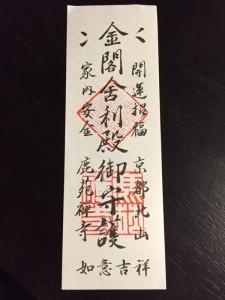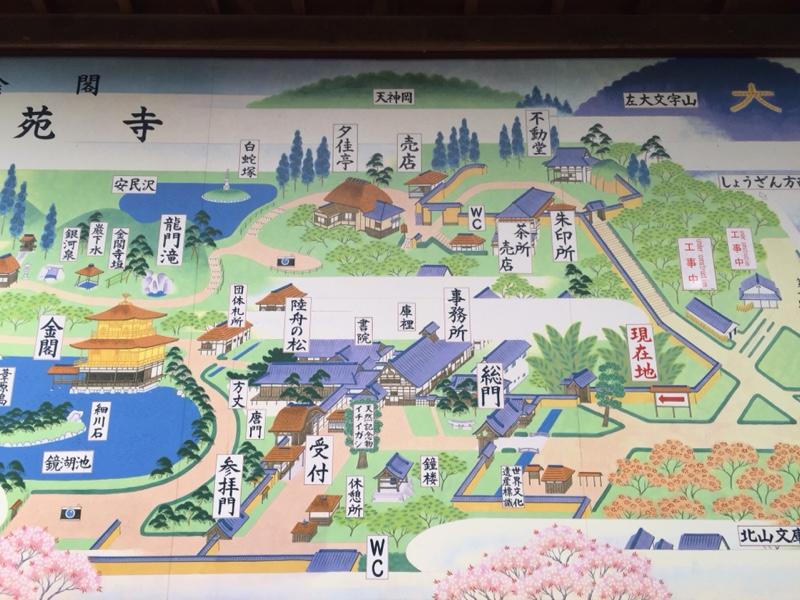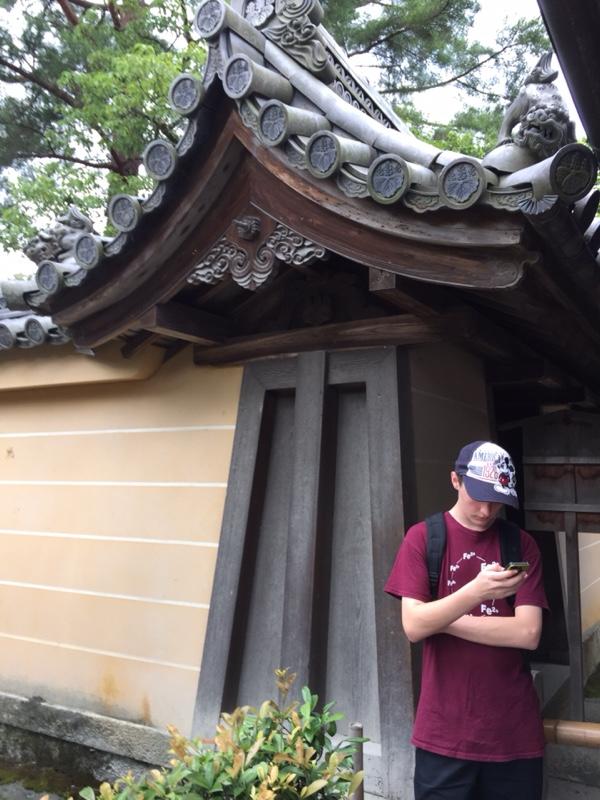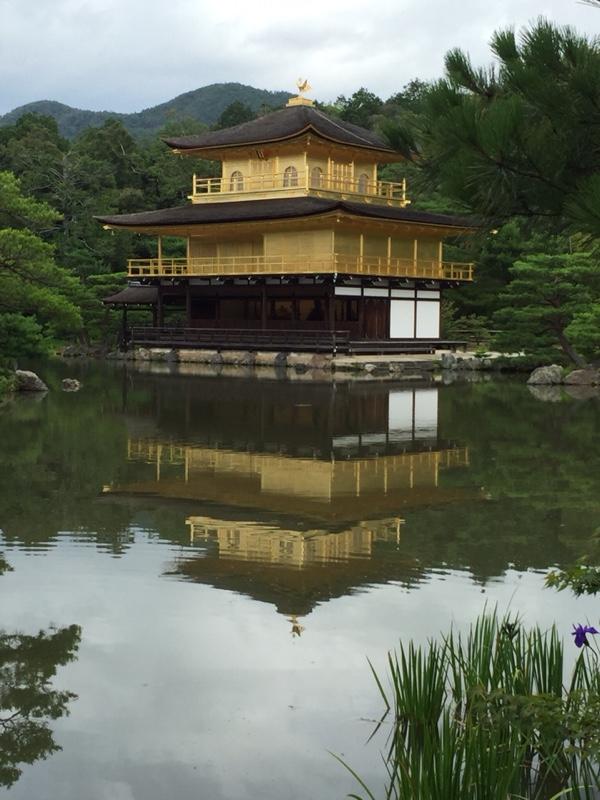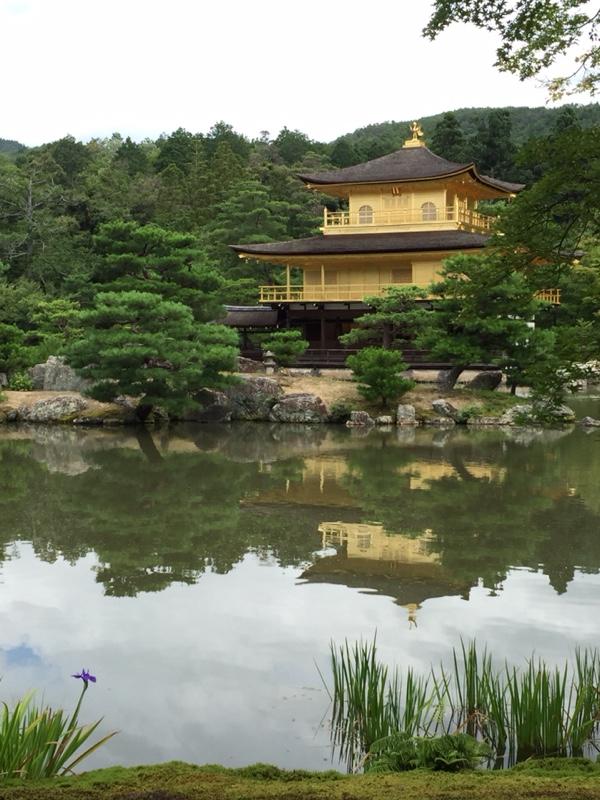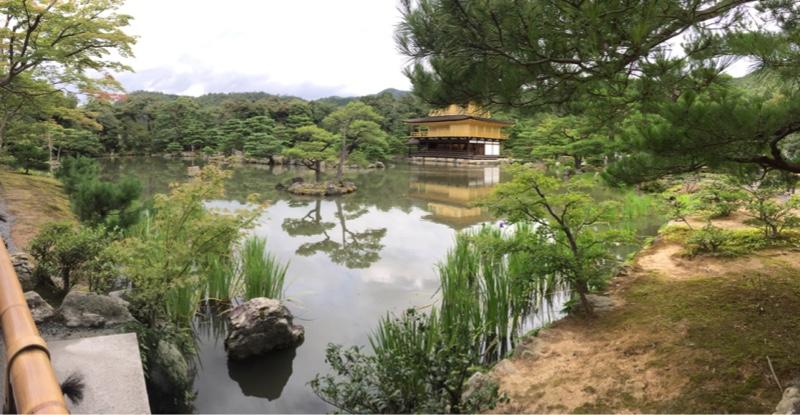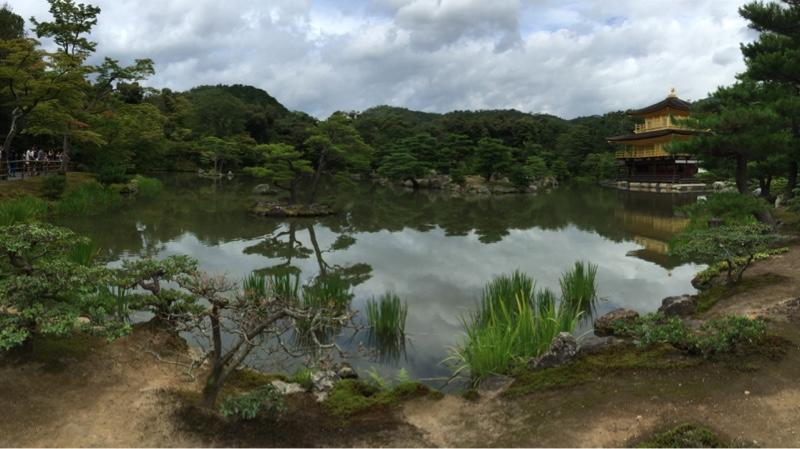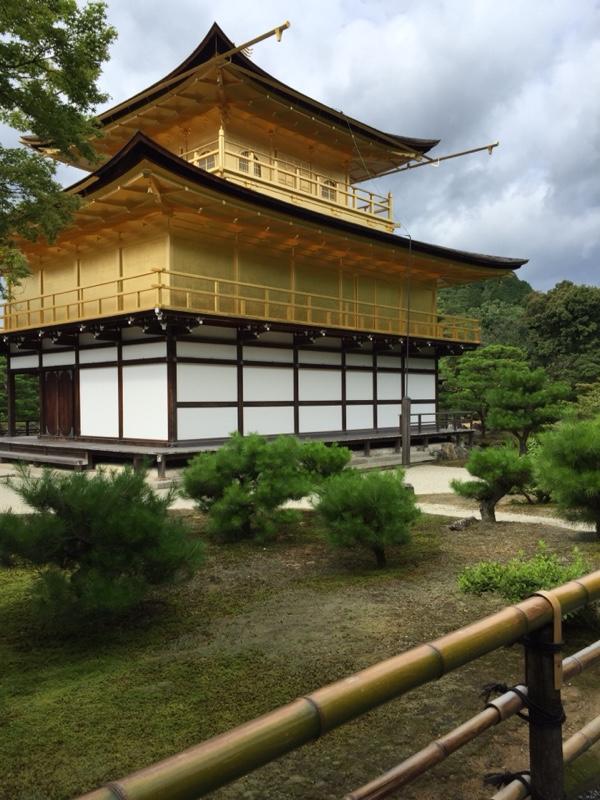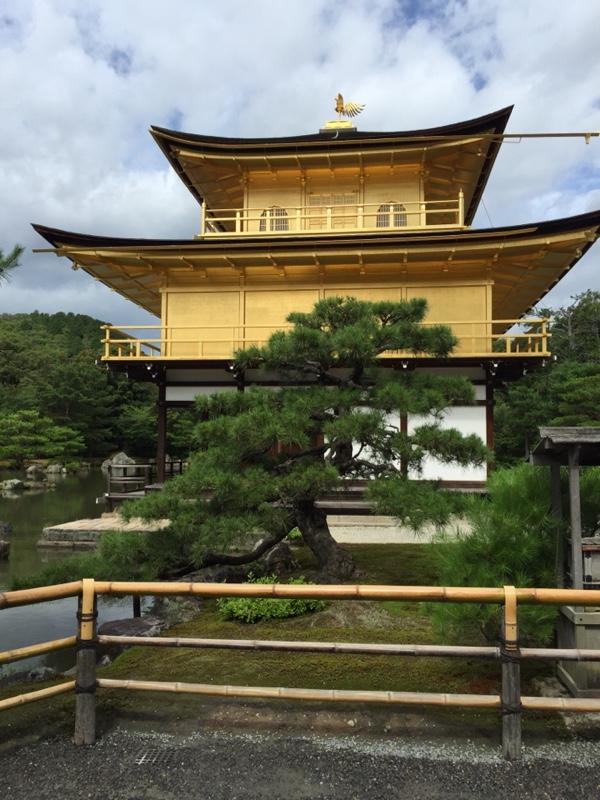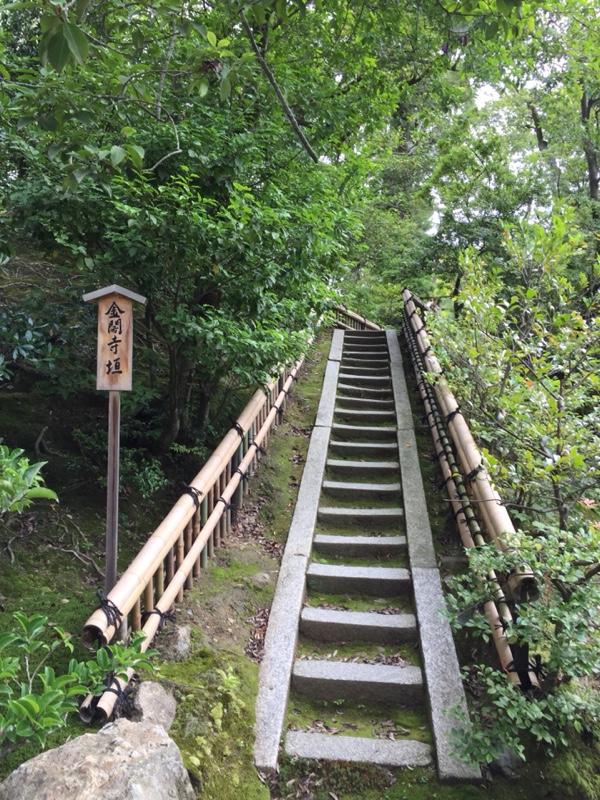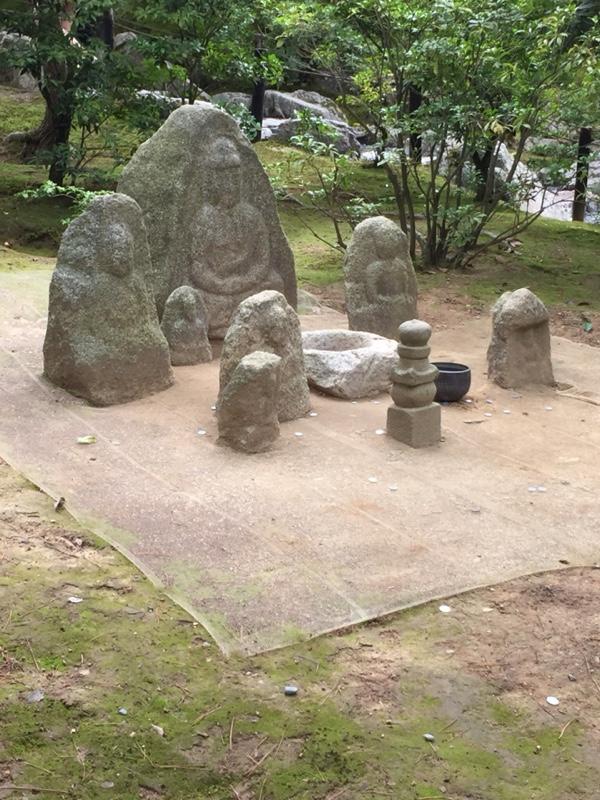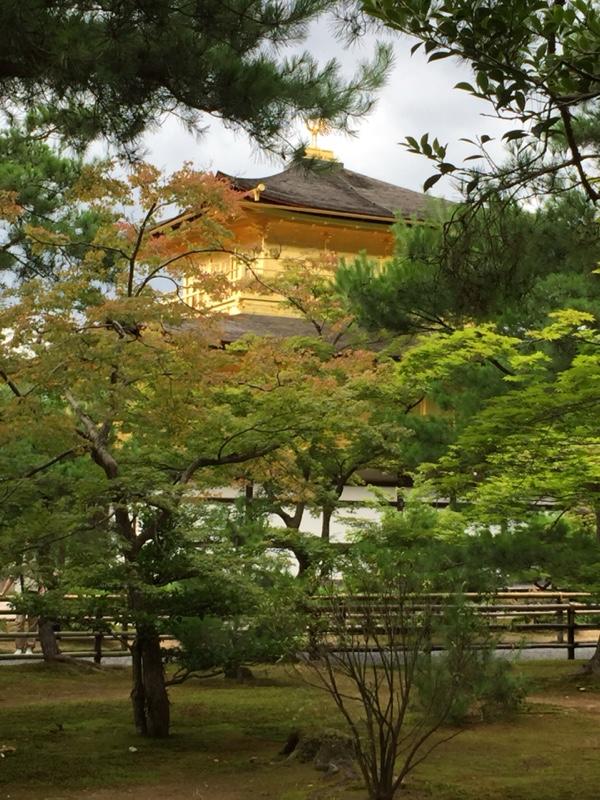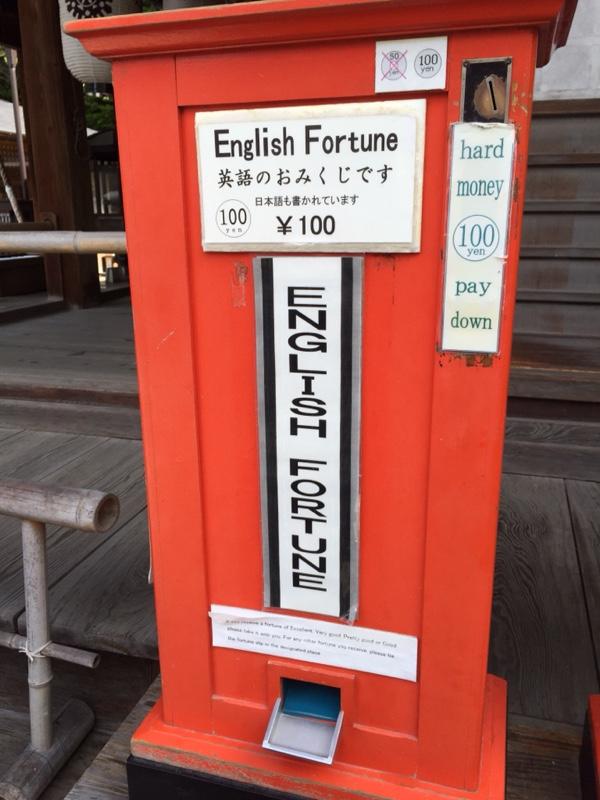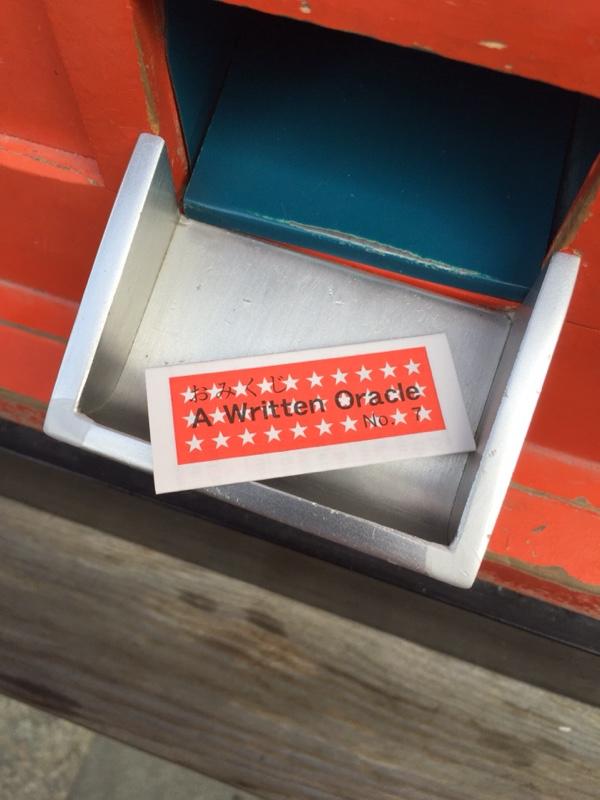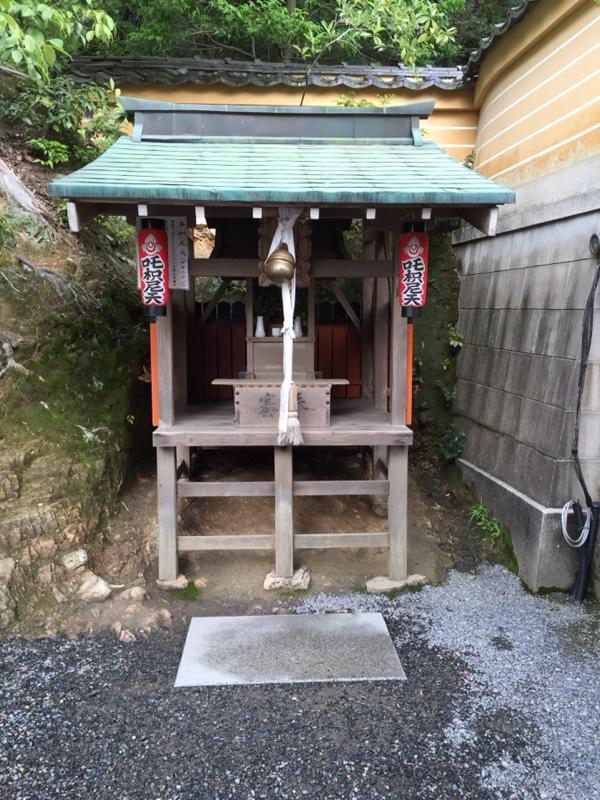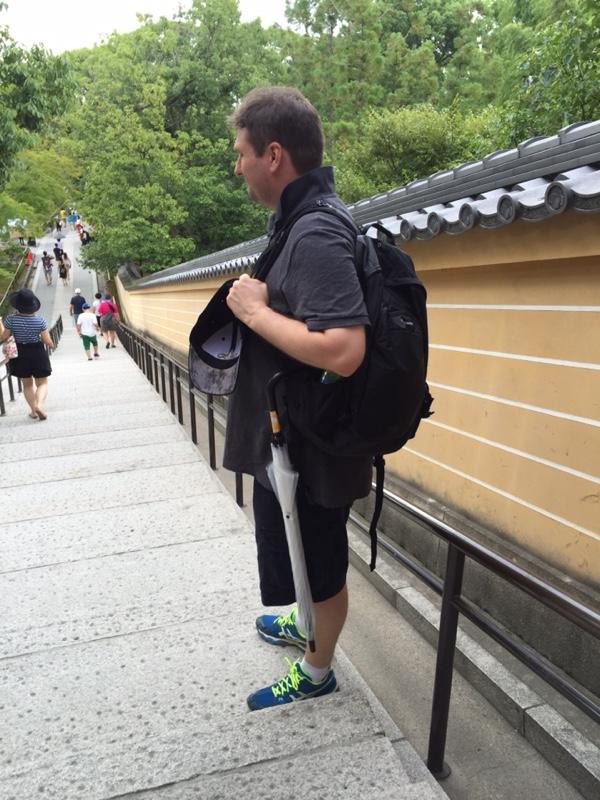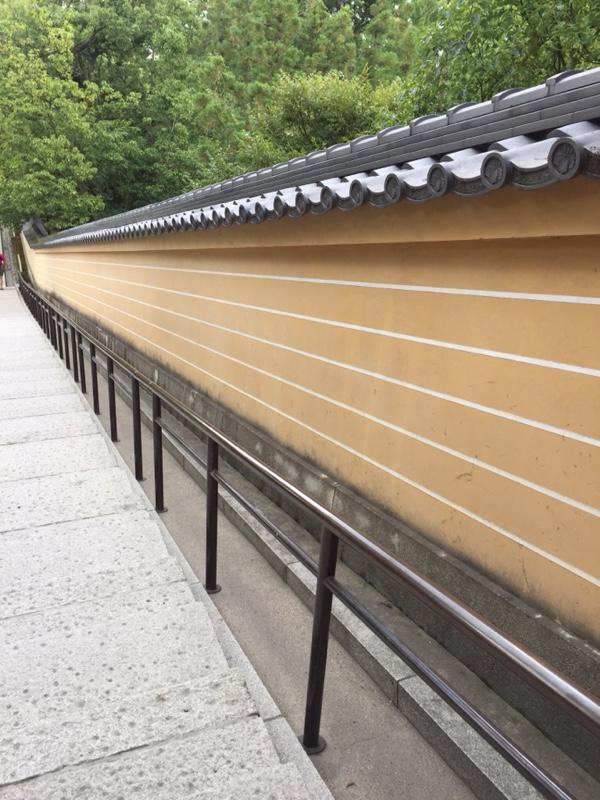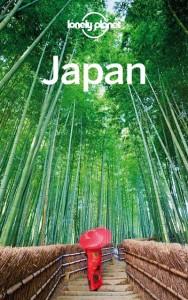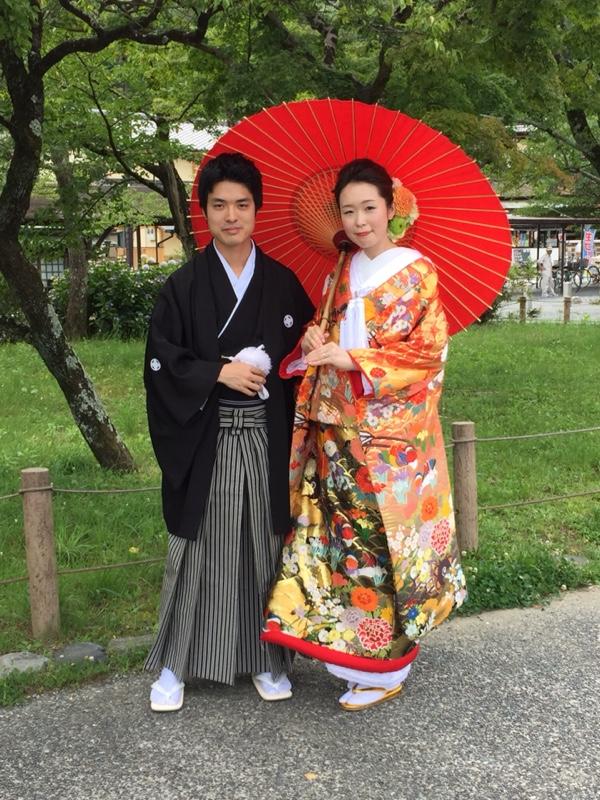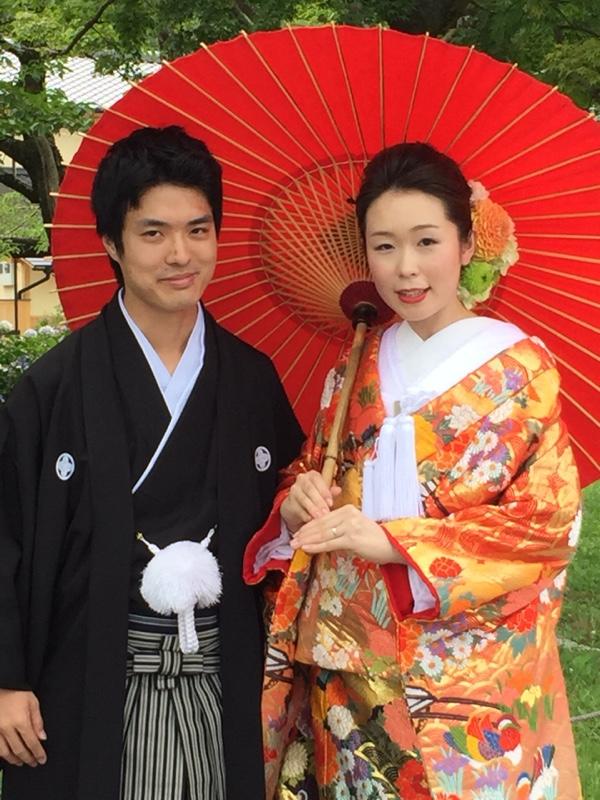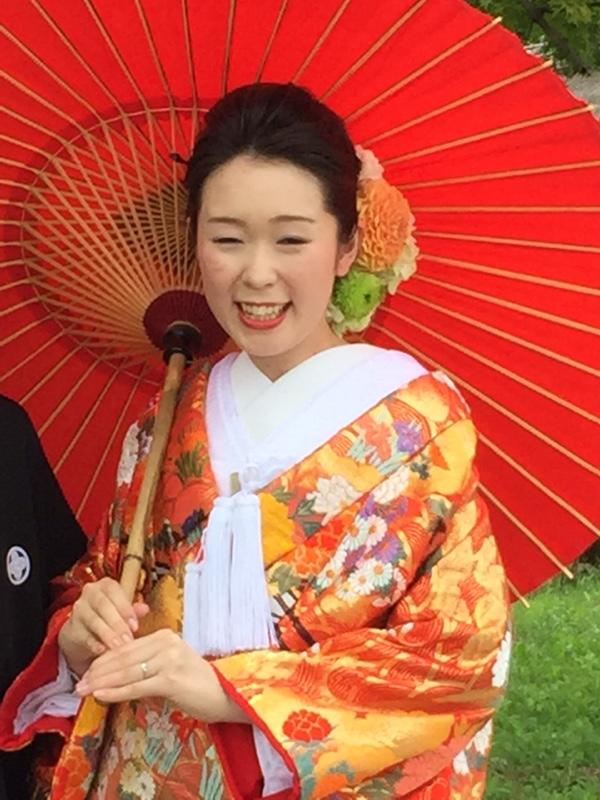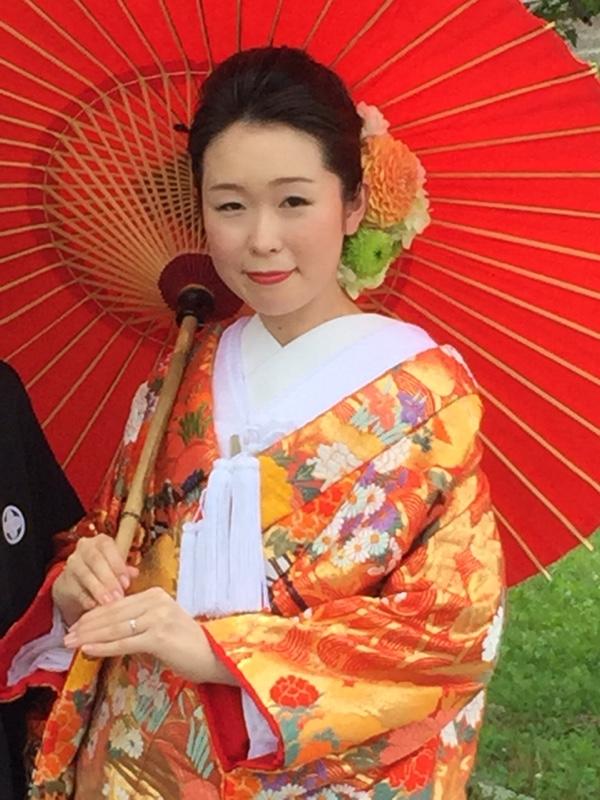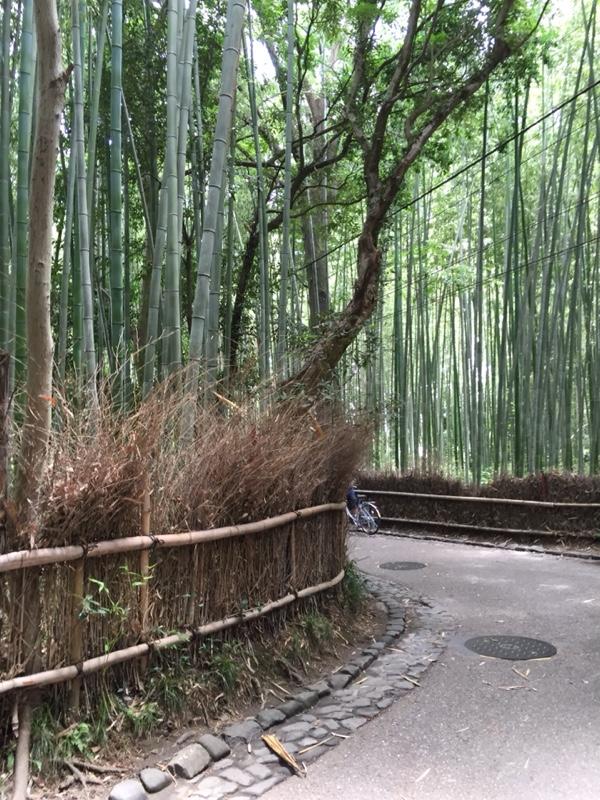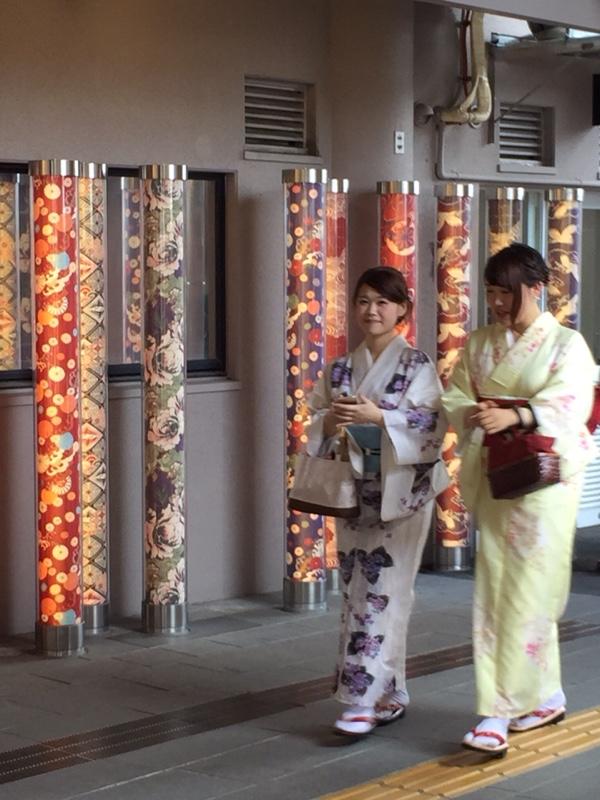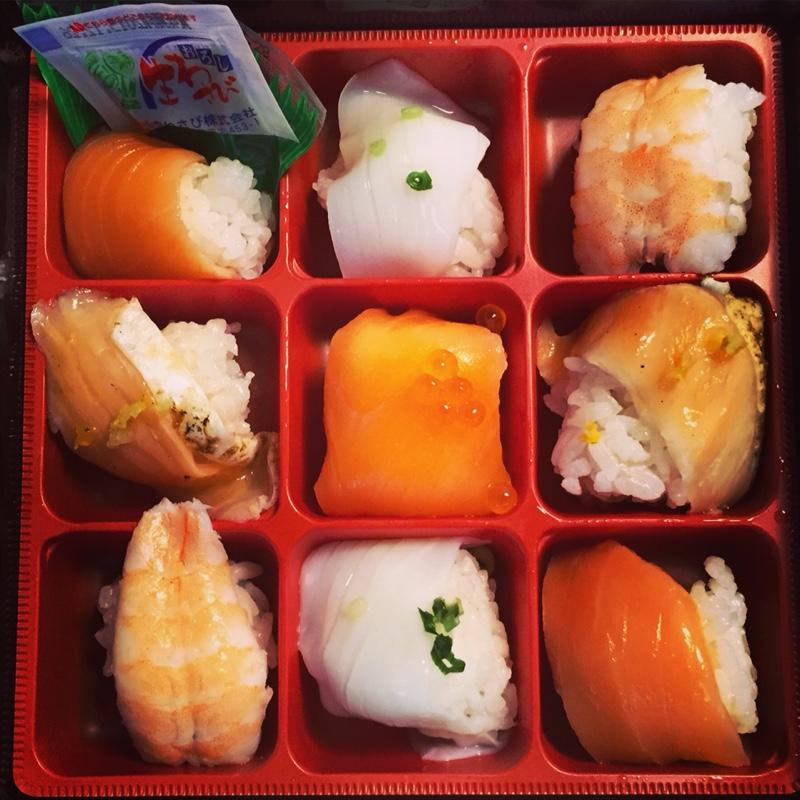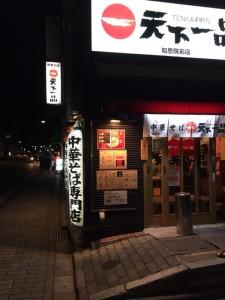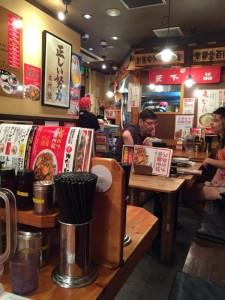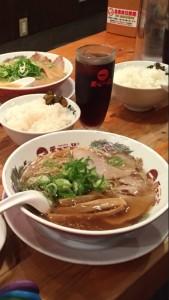Our itinerary for Vienna (outside of Eurocup stuff) was to check out as many museums as possible; but it felt very much like you can’t take a trip to Vienna without going to the Schönbrunn.
Commissioned by Leopold I in 1696, it was designed and built to the preferred baroque architectural style at that time, it is heavy and ornate with large sweeping staircases and colonnades. It was intended as a summer palace and hunting lodge not far from the River Wein, and had several halting stages of construction (due to the lack of funds resultant from war with Spain among other Hapsburg trials). Emperor Charles VI gave it to his daughter Maria Theresia who was apparently particularly fond of the place, and it was she who left the largest mark on the estate.
I remember the palace really well from visiting here in 1995 and mostly remember that it was huge, ornate and we had a very cool guide showing us around. It was also a rather quiet place without too many tourists and not a lot of ropes or glass stopping you from interacting with the space (unlike my memories of Versailles that same trip). Everything was about the Empress Maria Theresia, her investment and design decisions regarding the estate and her prolific offspring that were wed to the various royal houses on the continent leading to her being named, the ‘Grandmother of Europe’. Her name was uttered with a thick Austrian accent numerous times in every single room!
Jesus has this place changed… thanks to the Netflix TV services, “Empress”, the entire palace now is all about Elizabeth – also known as, ‘Sisi’, who was married to the Emperor Franz Josef some one hundred years after Maria Theresia. Seriously, you could could be forgiven for leaving here thinking that Sisi built the place and was the only royal to have lived here! The free roaming tour with polite ‘please don’t touch the velvet wallpaper’ signs are gone, and in it’s place is a rigid, timed and structured audio tour keeping you in glass walkways well away from the artefacts. The palace was packed with visitors… though given it was late afternoon, I imagine it is even worse in the mornings.
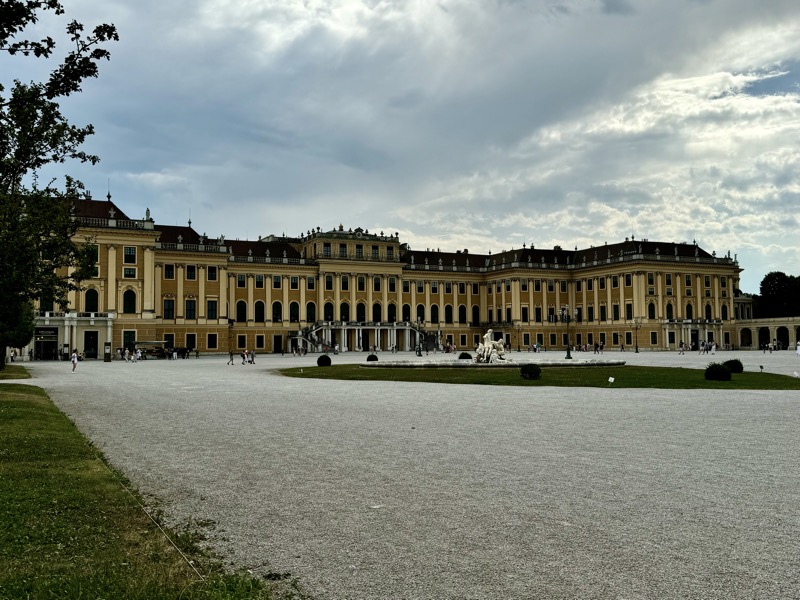
Oh, and nice overpriced touristy carriage rides on offer around the grounds.
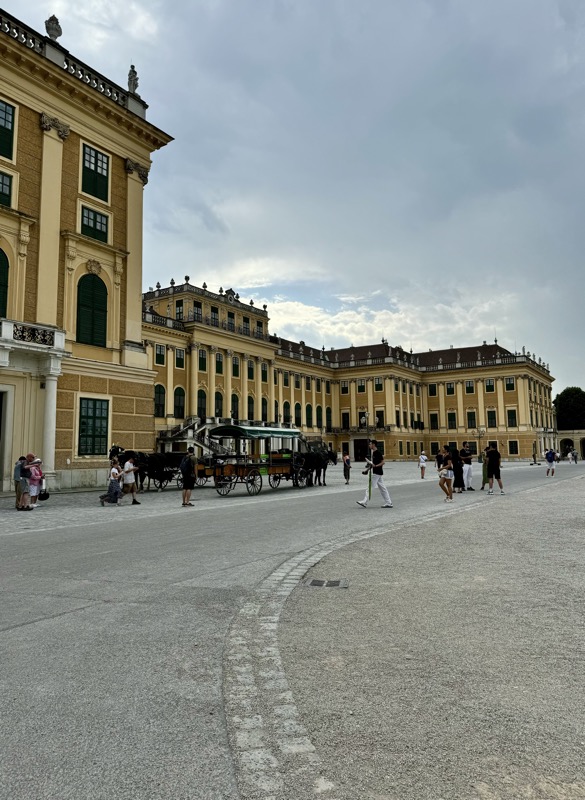
Still it is a lovely building and there is a lot to see here; having recently seen the over the top Nymphemberg Palace, among others, it does all start to feel a bit same-same, though.
The Billiard Room – ‘Franz Jospeh saw himself first and foremost as an officer of his army. Appropriately, the subject of the large format paintings in this room is the Military Order of Maria Theresa, the highest military order of merit of of the Habsburg Monarchy.’ Which was pointed out on the audio-tour… but possibly ignored as everyone is here to hear about Sisi!
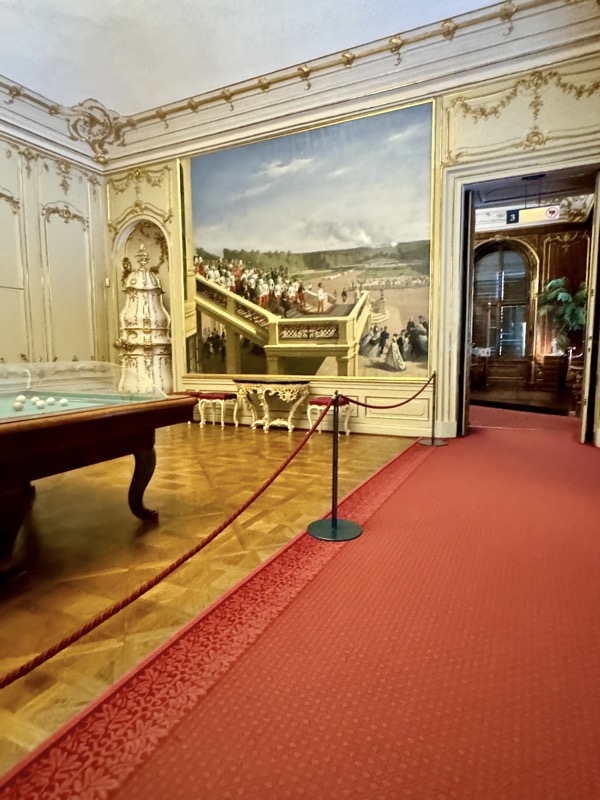
Audience Chamber – Here the various emperors received individuals who had been granted a private audience with the monarch. Members of the government, high ranking military officers and court officials were also summoned here several times a week to deliver their reports.
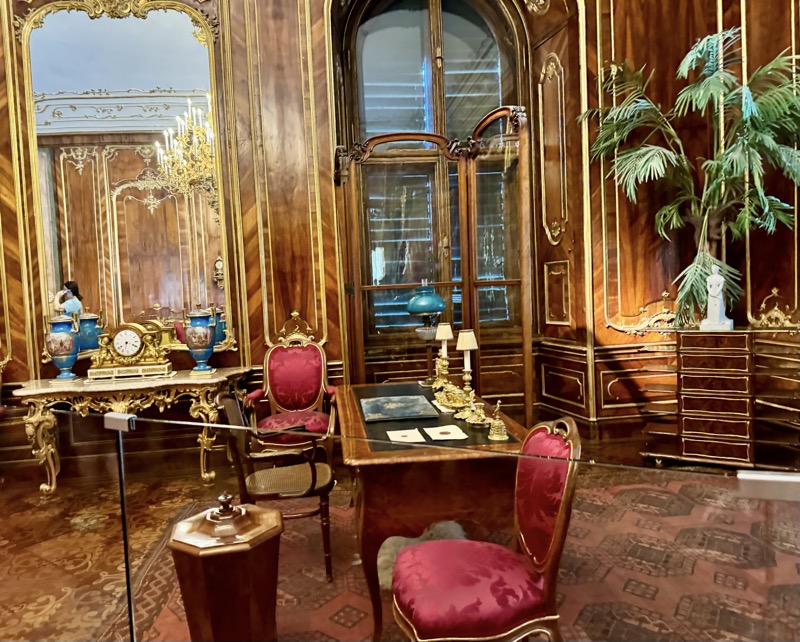
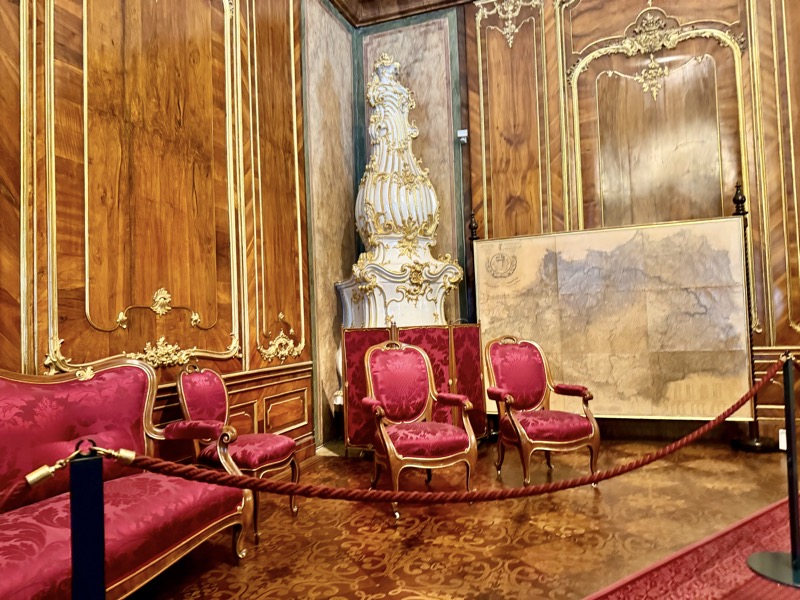
Emperor Franz Joseph’s (aka Sisi’s husband) Study – A host of personal pictures and photographs bear witness to the style of interior favoured by the emperor in his private quarters. Over the course of his long life he amassed in this room a wealth of mementos of his wife Elisabeth (Sisi), their four children and thirteen grandchildren.’
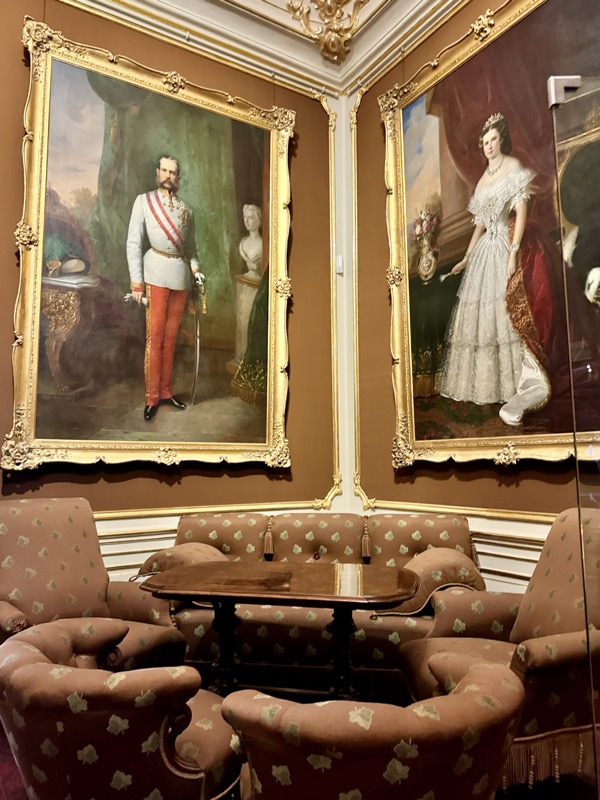
Ketterl Room – the concealed door in the back wall of the study leads into the valet de chambre’s rooms. I’m not sure what a Ketterl is…
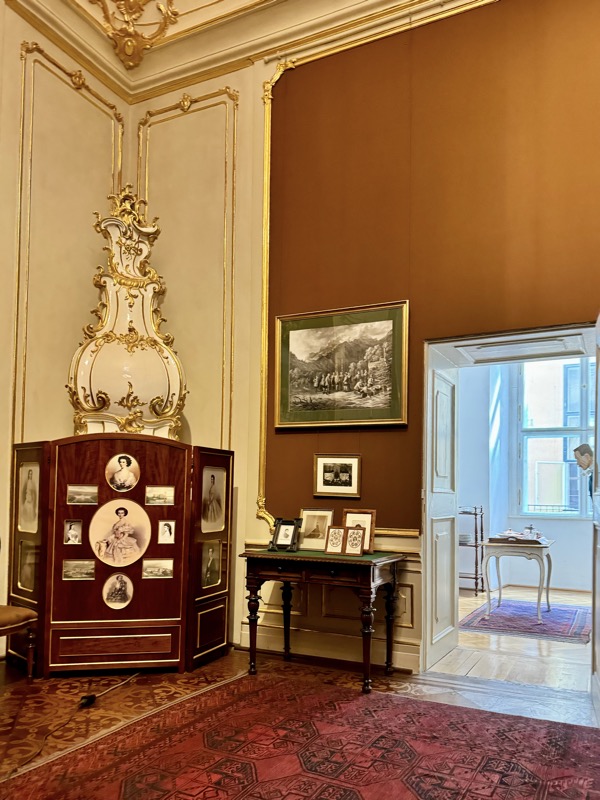
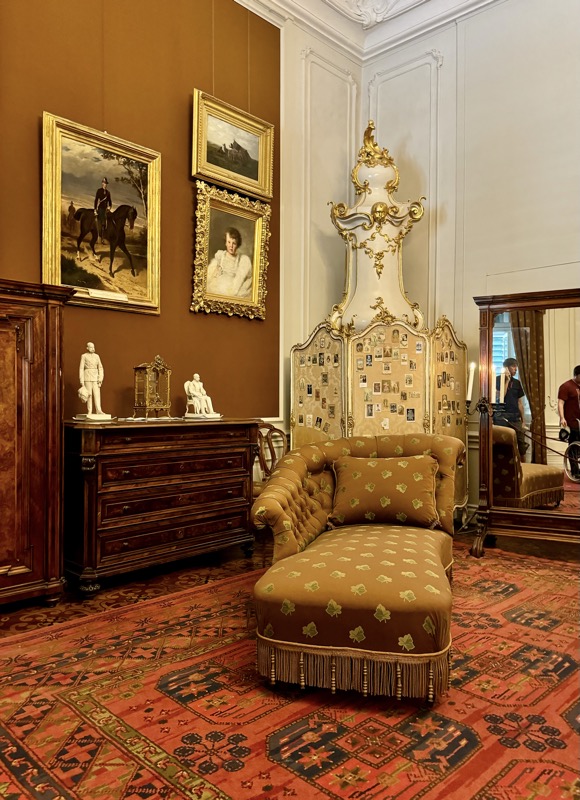
Franz Joseph’s Bedroom – the emperor’s bedroom was also where he died on November 21, 1916. The brown is a bit… meh.
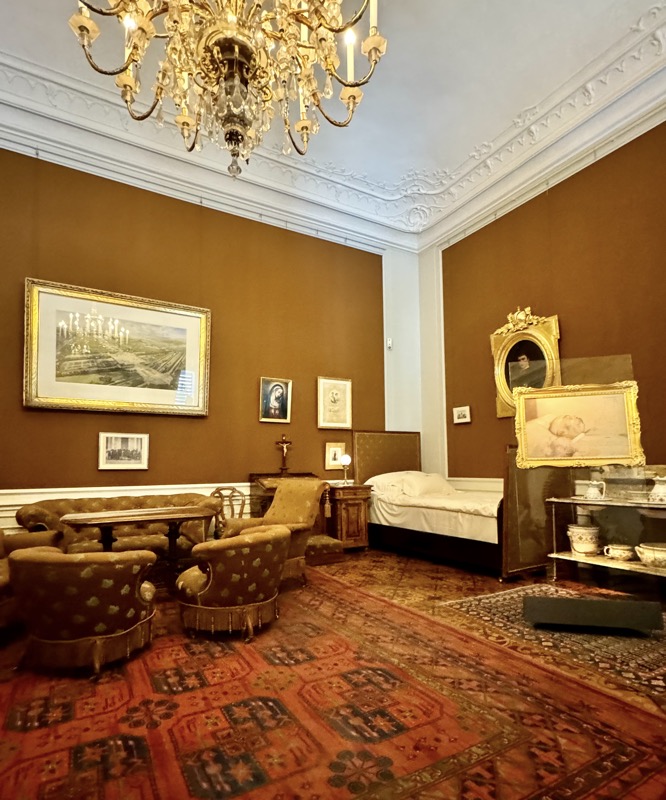
Stairs Cabinet – the Stairs Cabinet served Empress Elisabeth as a writing room. Here she wrote her letters, journals and her poetry. The bookcase still contains part of her personal library apparently.
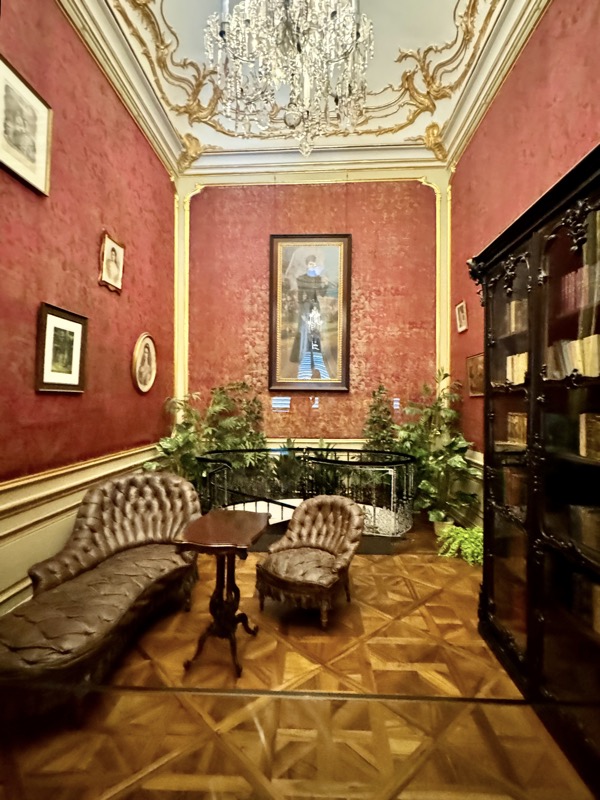
Dressing Room – immediately adjacent to the bedroom, the dressing room was the innermost and most private room in the empress’s apartments. Sisi was known to have a strict diet and beauty regimen to maintain her girlish figure and look after her ankle length hair.
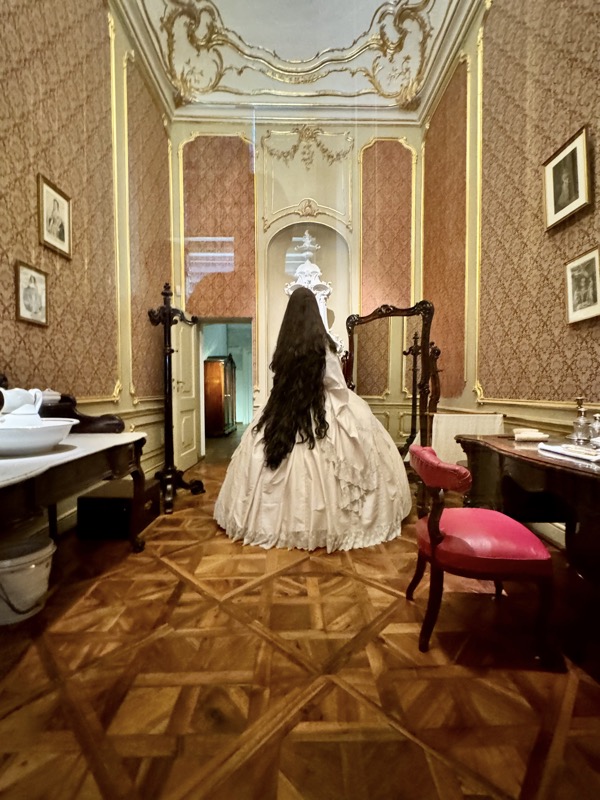
Imperial Couple’s Bedroom – the bedroom in the Italian style that was shared by Franz Joseph and Sisi was furnished and decorated as we see it now, for their marriage in 1854.
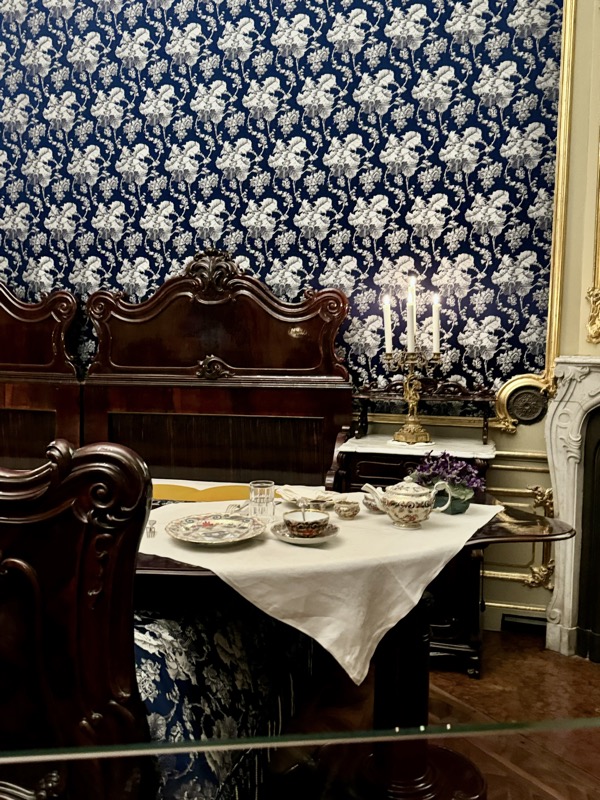
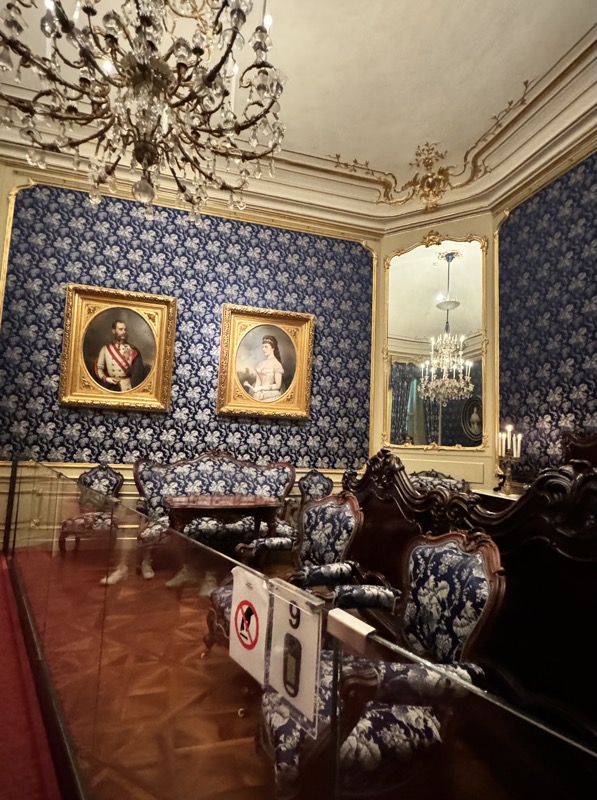
Salon of Empress Elisabeth – this was Sisi’s primary reception room. “The Rococo Revival interior is a typical example of the furnishing and decoration of a state room at the Viennese court during the reign of Emperor Franz Joseph.”… and is way too chintzy for me.
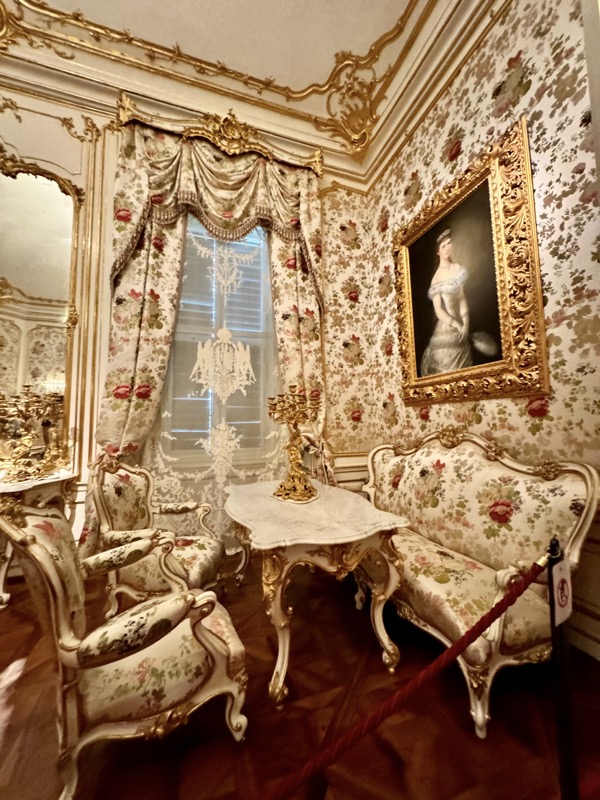
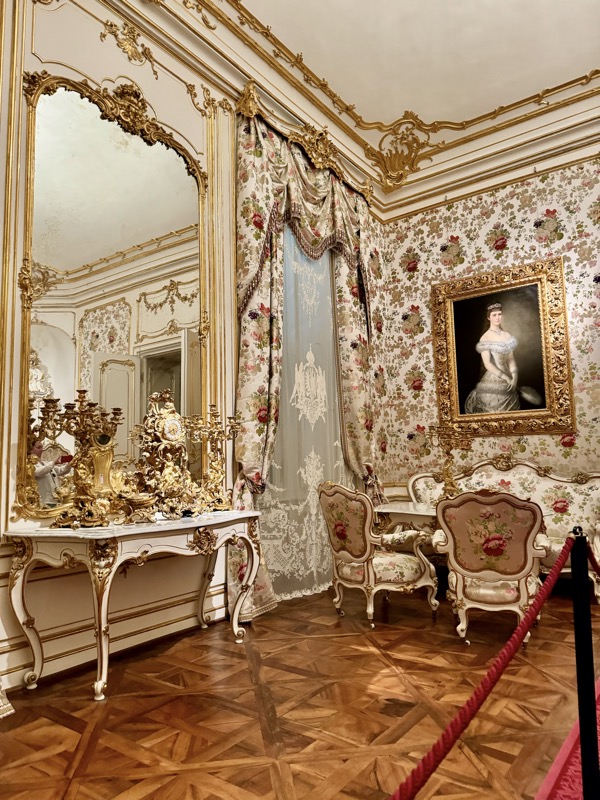
Marie Antoinette Room – during the time when Elisabeth occupied these apartments, the Marie Antoinette Room was used as the family dining room for small dinners in the immediate family circle and attended by the imperial couple and their children, and later on their daughter and sons-in-law and grandchildren. So, like a casual breakfast nook really.
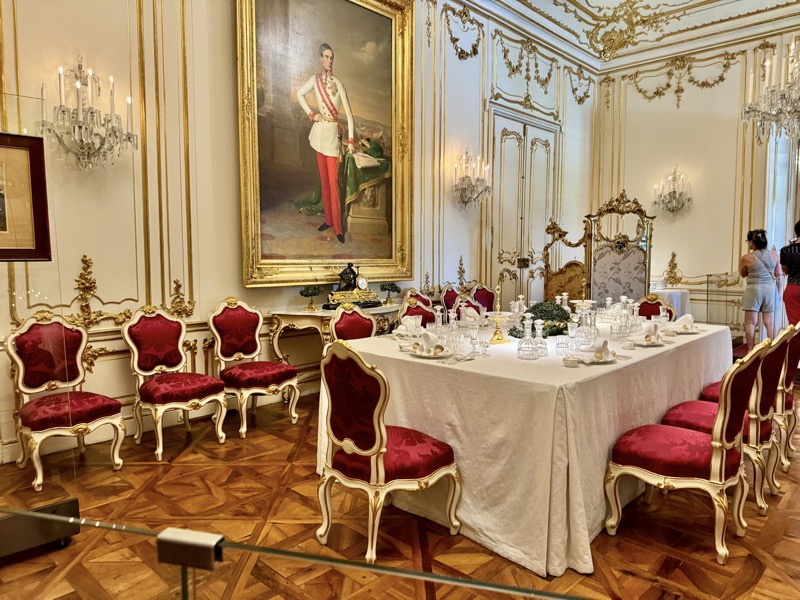
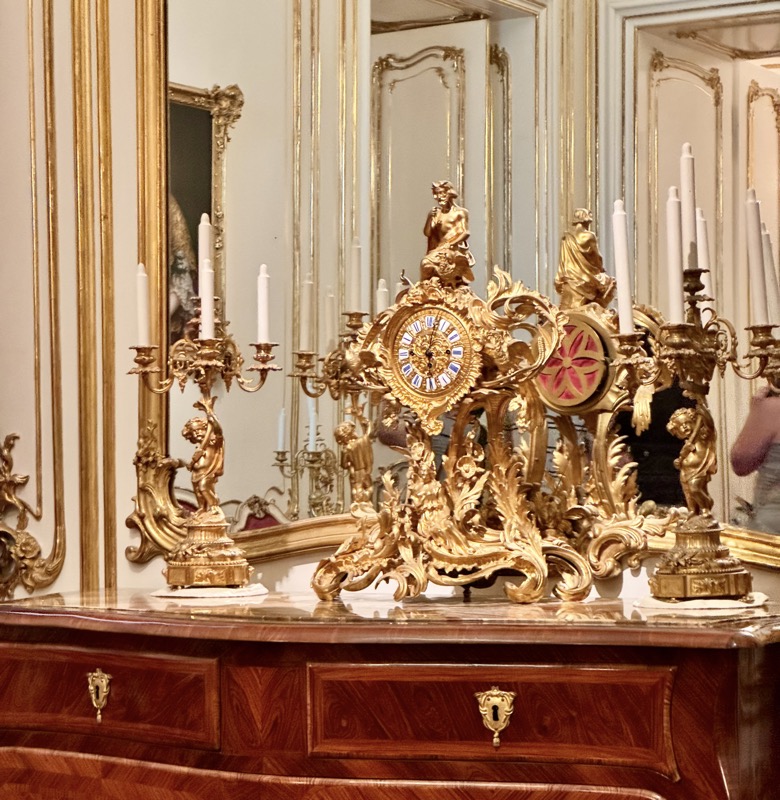
Yellow Salon – the Yellow Salon is the first room in the apartments facing the palace gardens. From the windows of these rooms one has a stunning view of the main parterre with the Gloriette as the lofty termination of the vista. <- I did not write that.
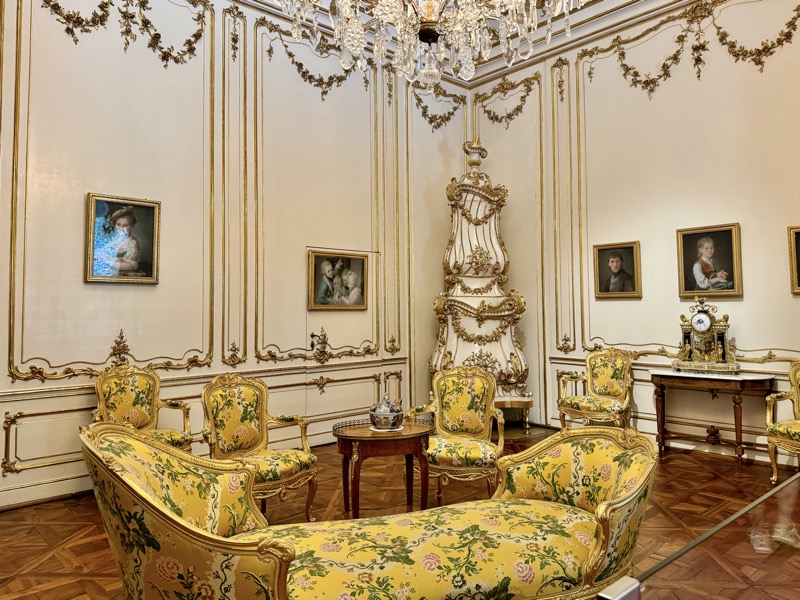
Balcony Room – continuing numerous pictures of Maria Theresa and her numerous children. The portraits are from the the studio of court painter Martin van Meytens. This was quite a nice room actually.
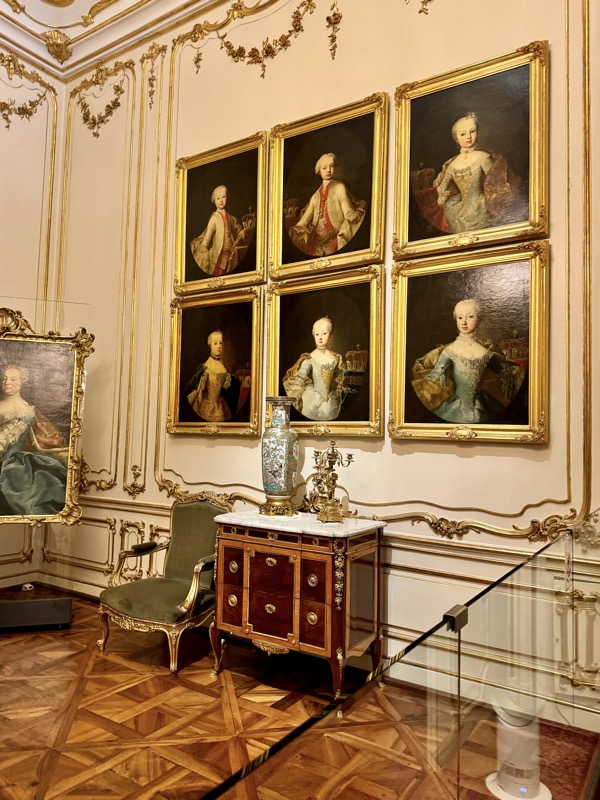
Breakfast Cabinet – this little corner room owes its ‘pleasing character’ (according to the audio) to the textile flower pictures set into the wall panelling in gilt frames. It’s lovely, but so delicate and feminine. I think trying to relax in these spaces would just put me on edge.
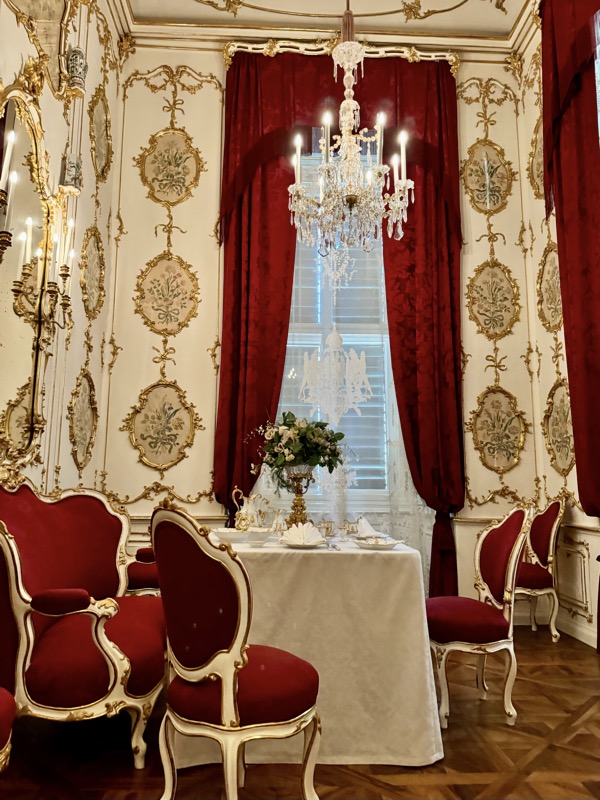
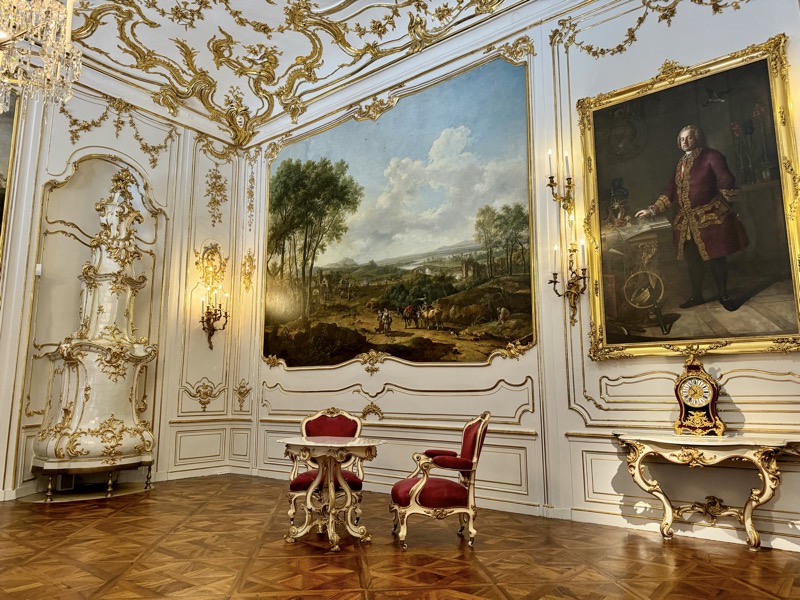
Salon of the Arch Duchess Portraits – this room is done in a Rococo Revival decor and once belonged to the apartments occupied by Empress Elizabeth. Today it contains the famous portraits of Maria Theresa’s daughters, and is therefore also sometimes known as the Children’s Room.
Large Rosa Room – the three Rosa Rooms are named after the artist Joseph Rosa, who executed fifteen landscaping paintings for the ensemble at the behest of Maria Theresa in the 1760s. See, Maria Theresa did all the work, and somehow Sisi is now the belle of the ball!
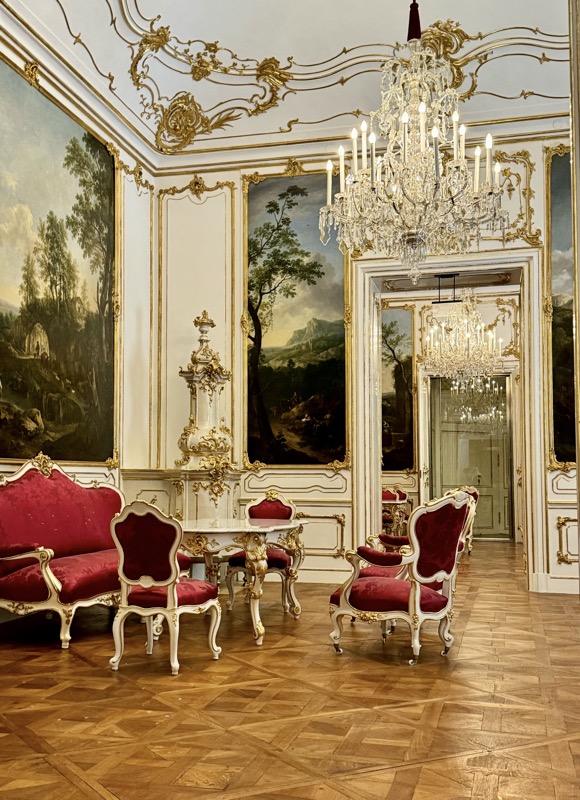
Second Small Rosa Room – consisting of one large room and two adjoining smaller room, the Rosa Rooms form an ensemble with a cohesive decor plan.
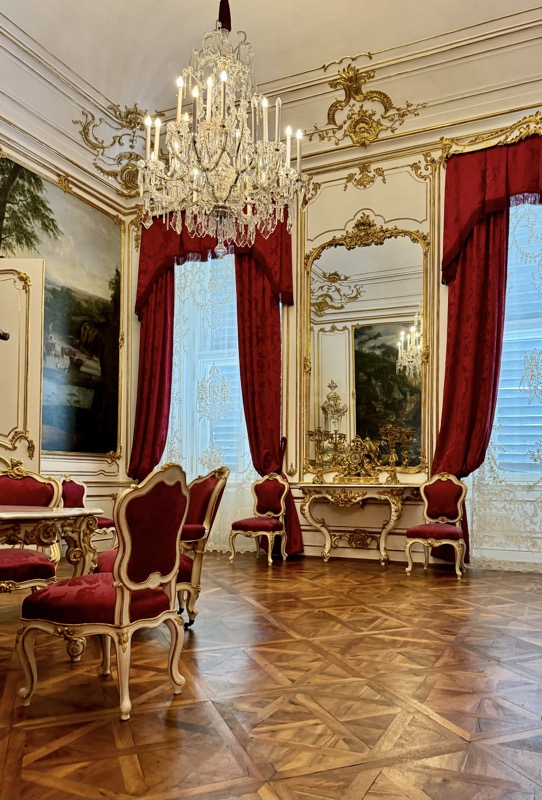
Great Gallery – Okay, this is pretty great still. It is 43 metres long, and just shy of 10 metres wide, the Great Gallery was the used as an ideal setting for courtly events. The interior is dripping with magnificent gilt stucco decorations and ceiling frescos represents the epitome of Rococo art – which is fabulous, if you like that sort of thing.
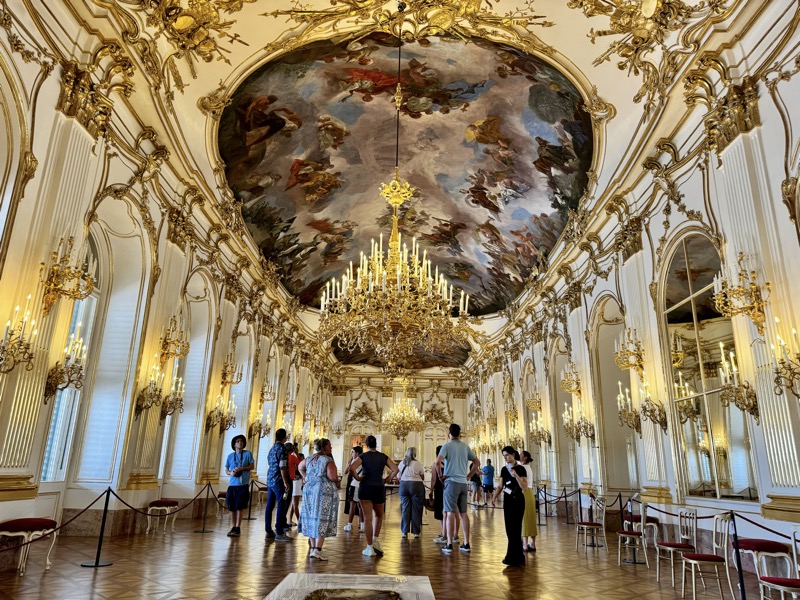
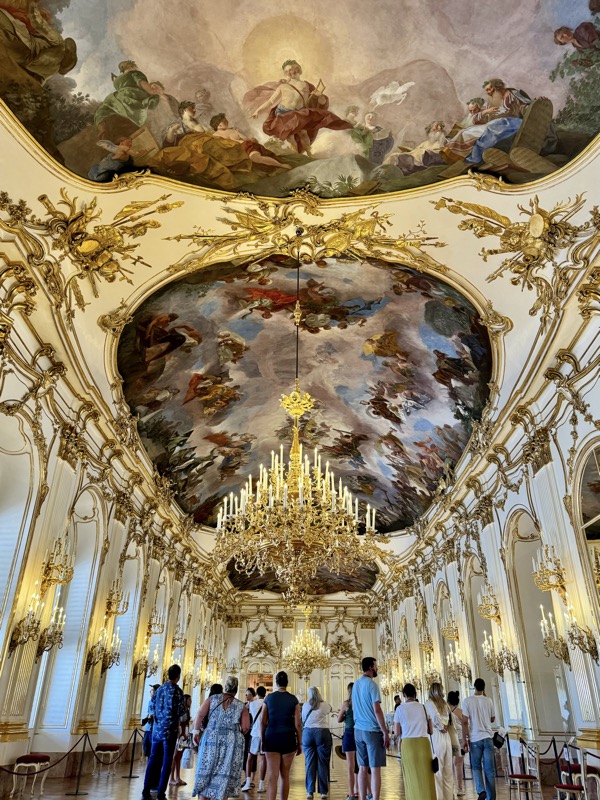
Okay, I love the chandeliers! Want one at home, though it may be hard to manoeuvre around given the high ceiling in my house is only about 14’. 🙂
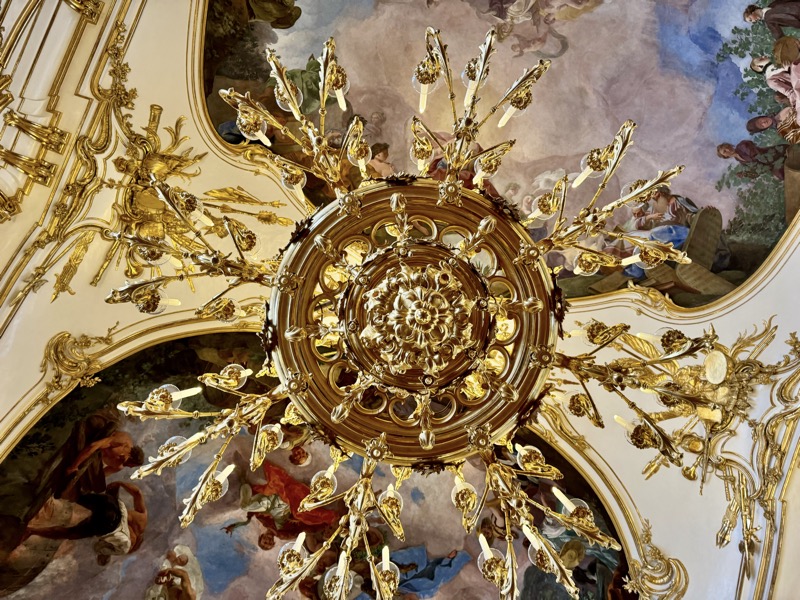
Round Chinese Cabinet – half concealed to either side of the Small Gallery lie two highlights among the historic state rooms of the palace; two cabinets lying opposite each other in mirror-image, both decorated with a rich array of works of art from China and Japan… though it ends up being subtlely chinoiserie, as it’s all surrounded in those heavy Rococo frames.
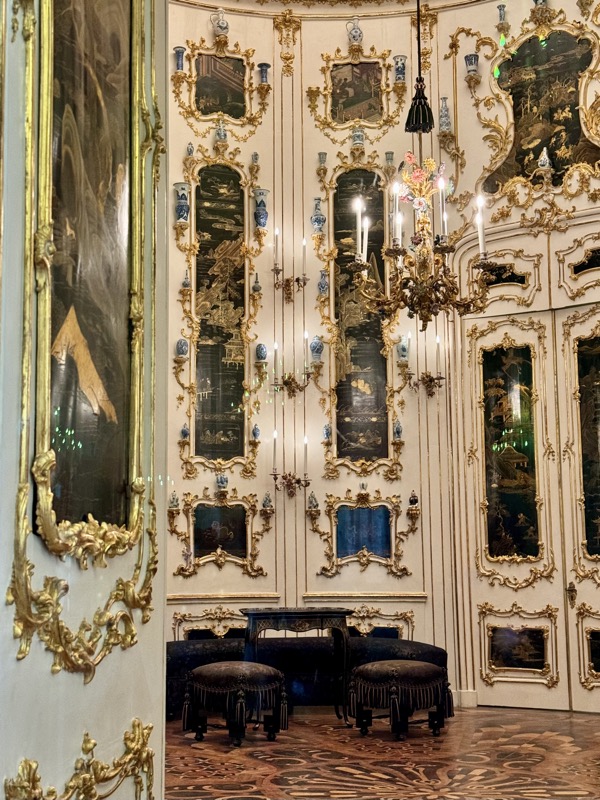
Small Gallery – crossing the central axis of the palace, the Small Gallery, together with the two smaller rooms on either side, made for small salons used for intimate courtly entertainment. I still can’t imagine living in a place like this, how do you decide which room is appropriate for a game of Code Names?
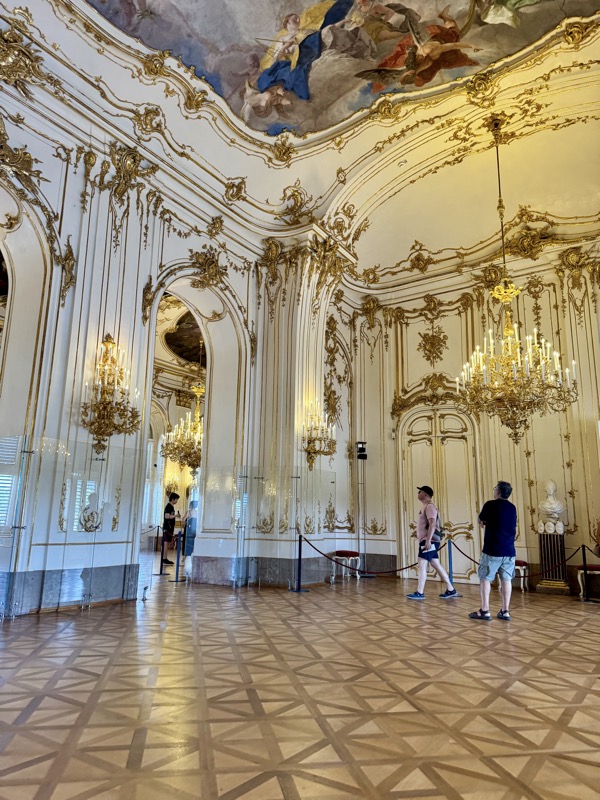
Oval Chinese Cabinet:
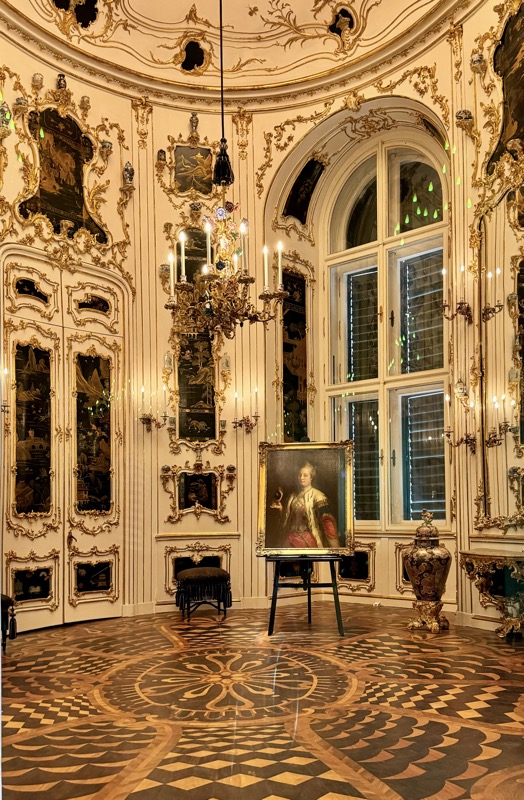
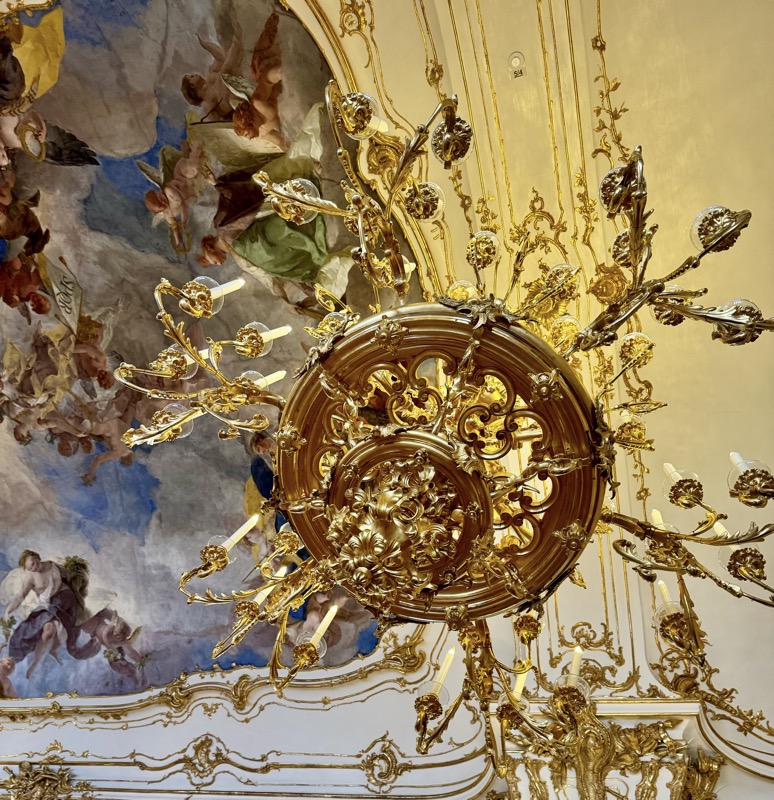
Hall of Ceremonies – at the court of Maria Theresa the Hall of Ceremonies served as the Second or Great Antechamber. Here, enthroned under a canopy of state, she received her guests in audience. Today this place is occupied by probably the most famous portrait of Maria Theresa, showing her as the ‘First Lady of Europe’ in a sumptuous gown of Brabant lace. Sumptuous – good word.
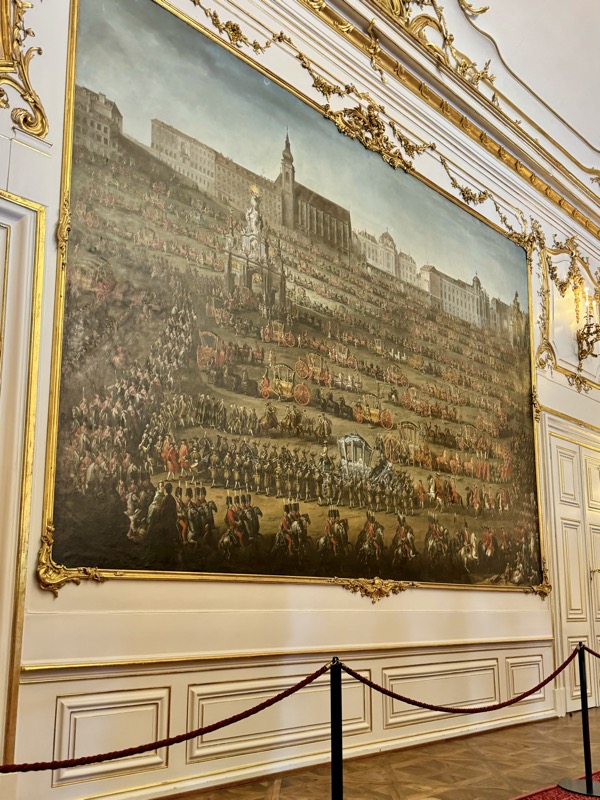
Vieux Laque Room – in terms of its art-historical significance, the Vieux Laque Room is apparently among the most important interiors of the Schönbrunn. The black lacquer panels from China lend the room an impression of decadence and magnificence.
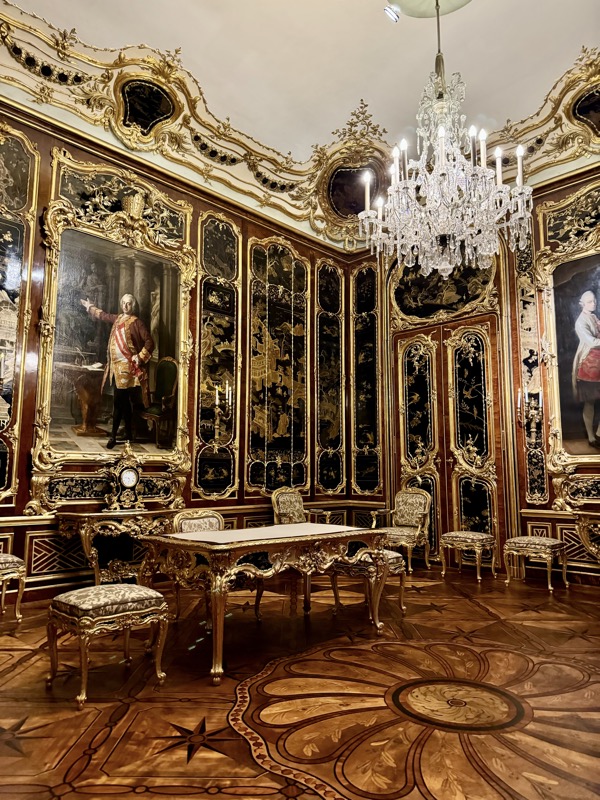
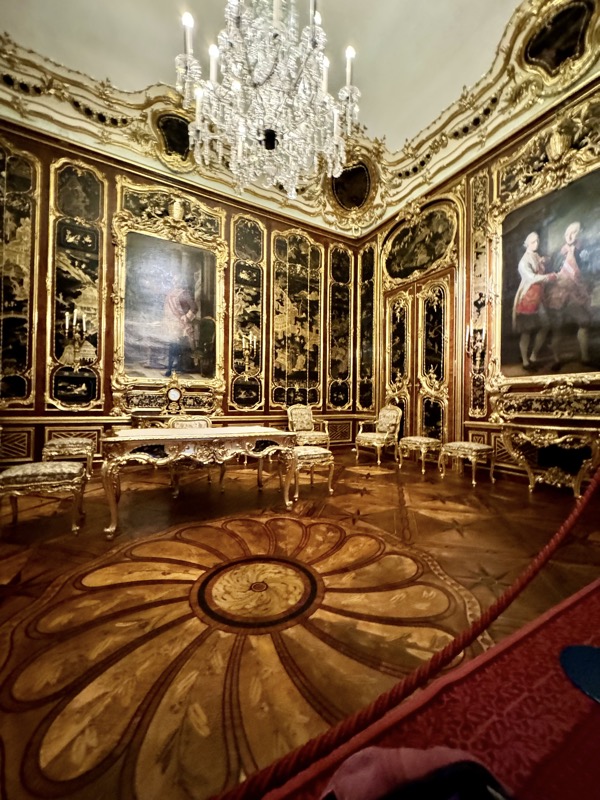
Needs more gilt…
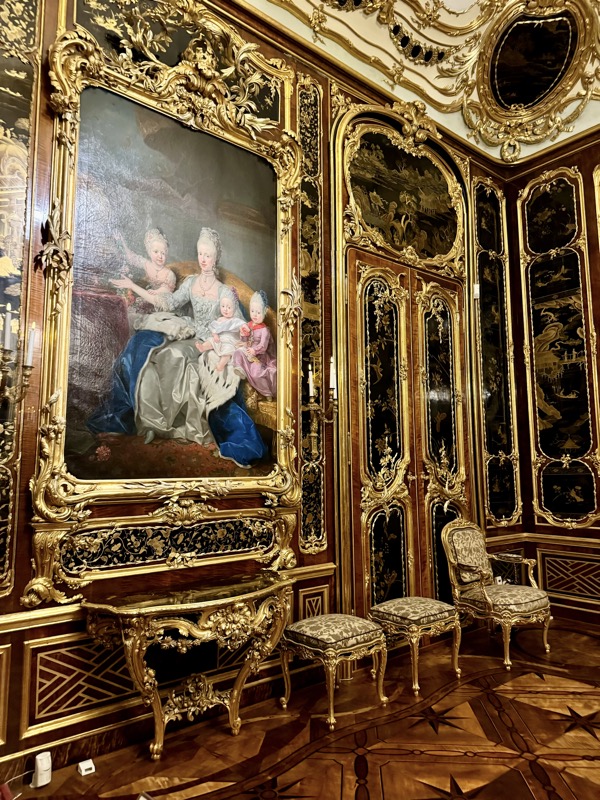
Napoleon Room – known today as the Napoleon Room, the room was refurbished several times during the 19thC. When it was restored in 2007 the decision was taken to highlight various phases of its past decoration and make this visible to visitors. I don’t know why it’s called the Napoleon Room, they didn’t say?!
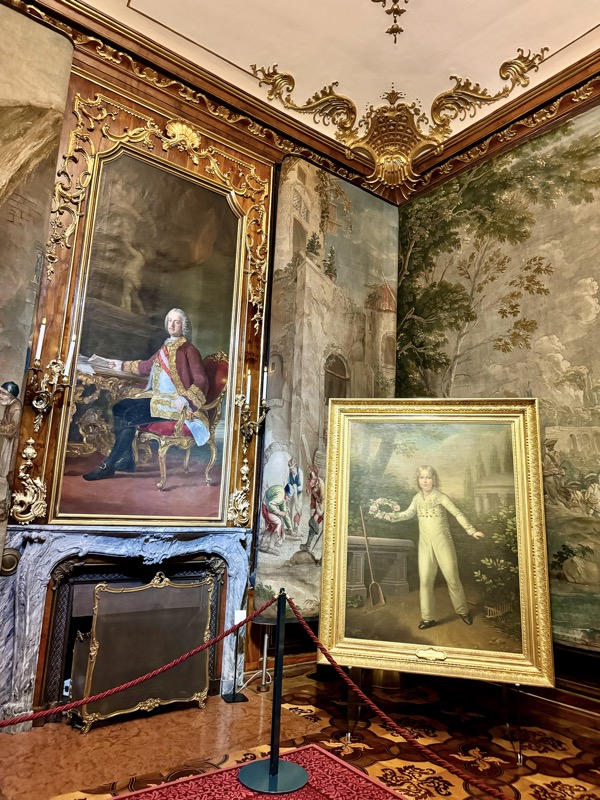
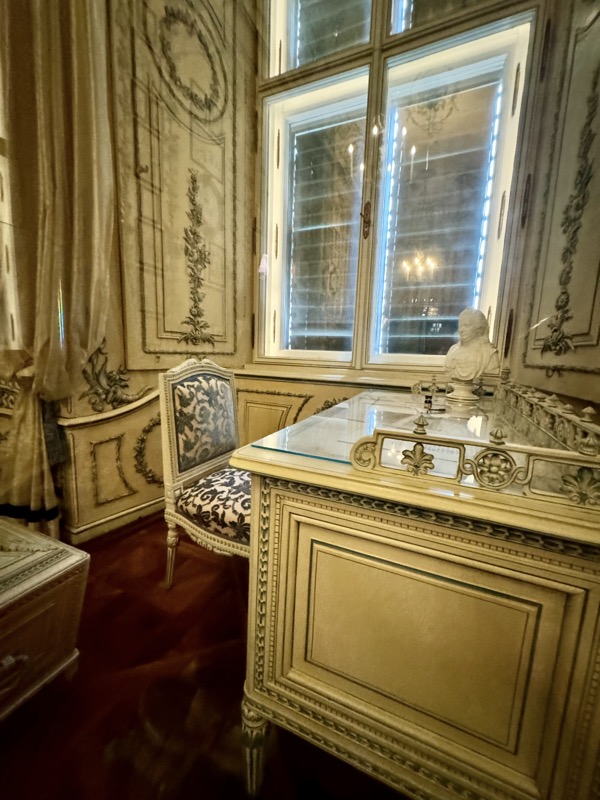
Porcelain Room – this small room served as Maria Theresa’s private writing room. It has a particularly private character and was decorated to her personal tastes apparently. The decor not only displays the empress’s love of the chinoiserie fashion of the times but was partly made by members of her family – it interestingly the most monochromatic area in the entire place, but still full of baroque clutter. .
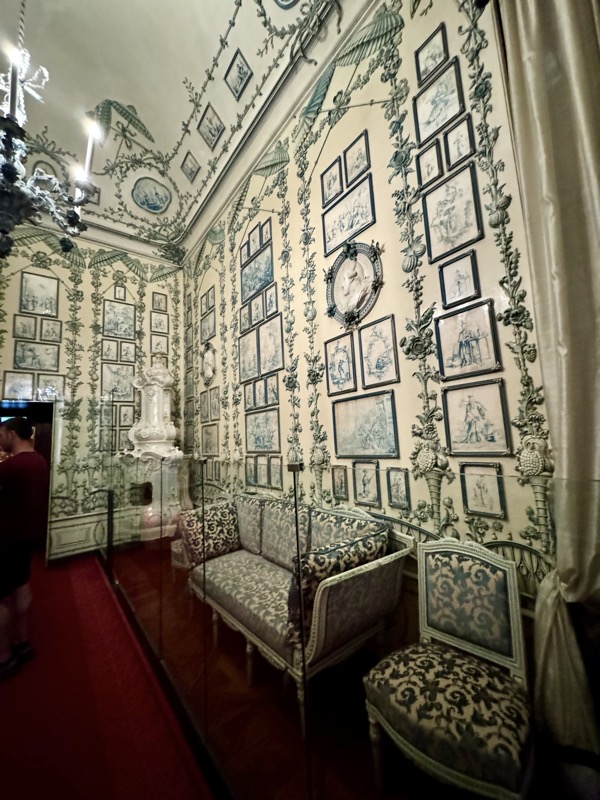
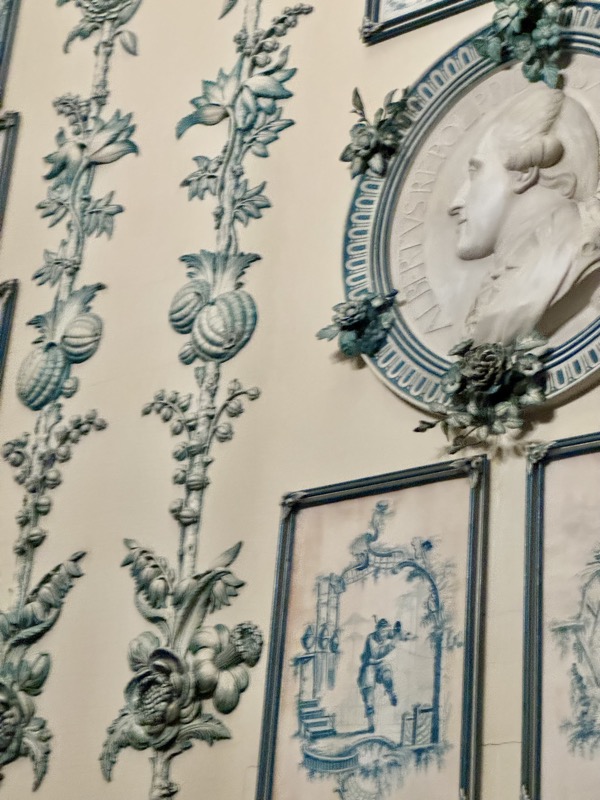
Millions Rooms – the interior of the Millions Room (named for the Indo-Persian works attached to the walls) is particularly extravagant. In the ceremonial sequence of rooms prescribed for the Viennese court, Maria Theresa used this room, originally known as the Mirrors Room, to receive guests for private audiences. Okay, so the house is definitely all still about Maria Theresa – so why is the advertising, posters, website and gift shop all about Sisi?
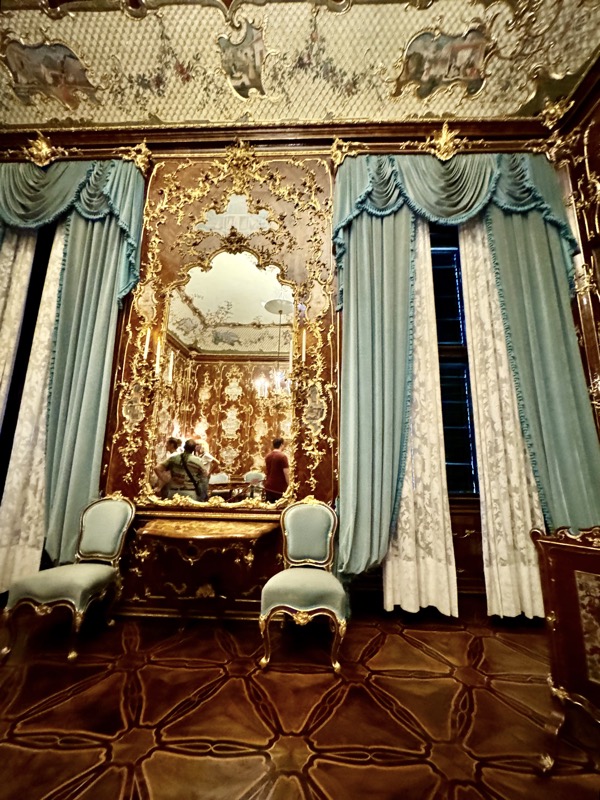
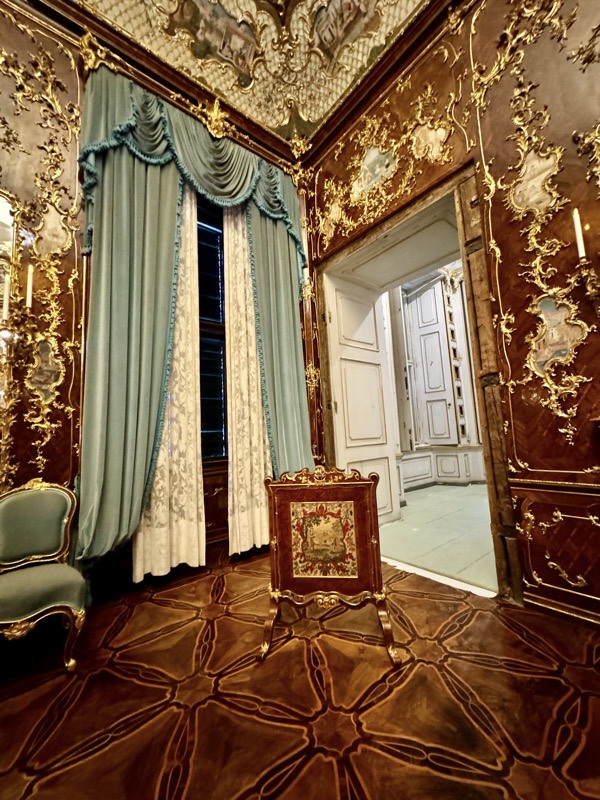
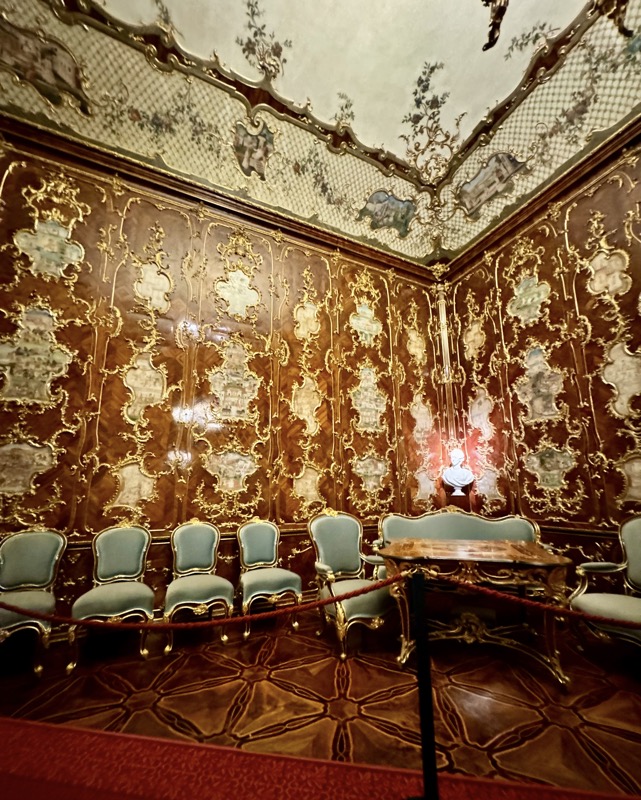
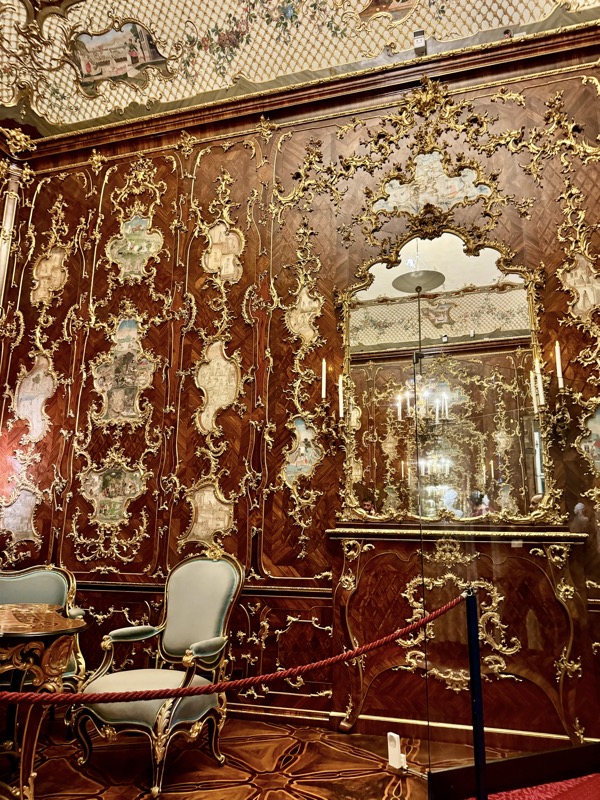
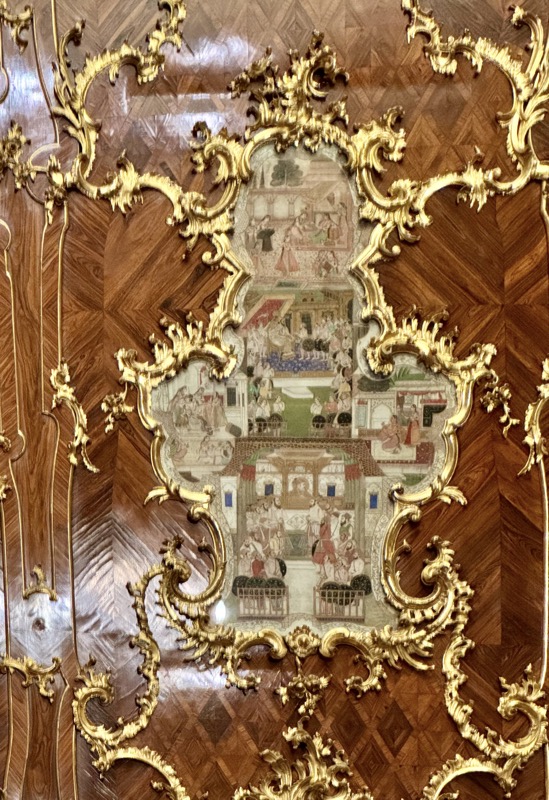
Gobelin Salon – both the walls and the armchairs in this room are covered in valuable tapestries; the backs of the seats of the six chairs each show representations together with the signs of the Zodiac… it’s pretty flash.
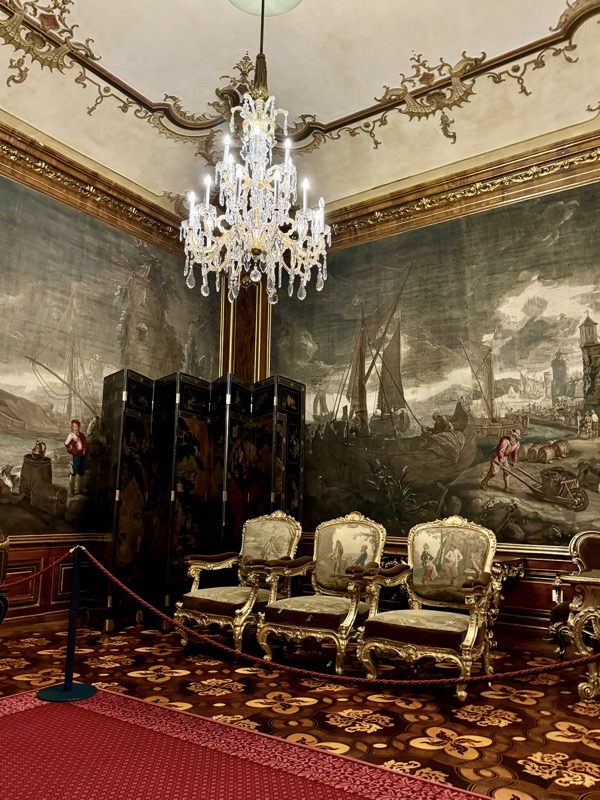
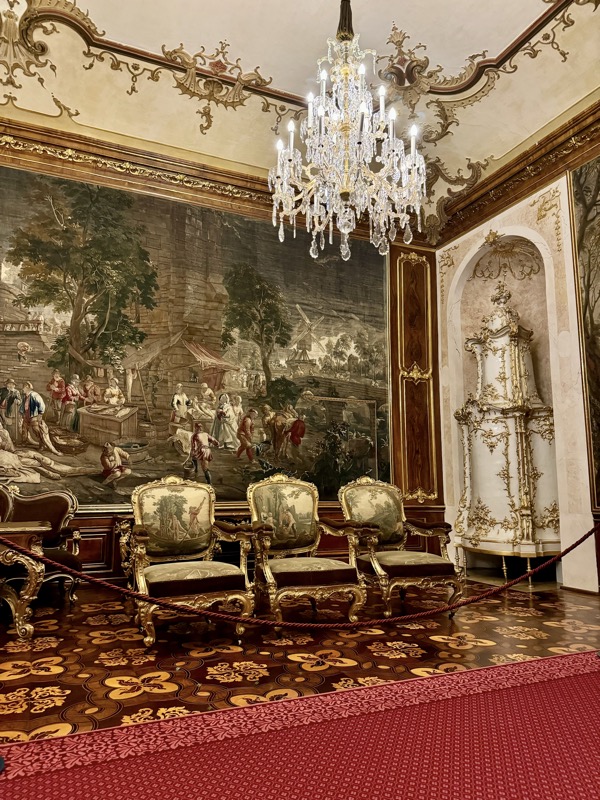
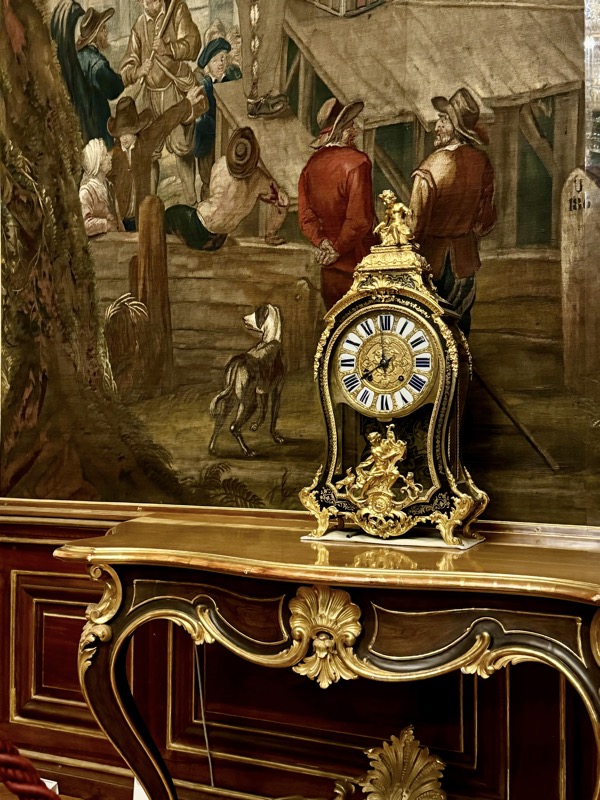
Red Salon – known today as the Red Salon, this room is decorated in the style typical of the later years of Emperor Franz Jospeh’s reign. The room is characterised by the wall hangings and upholstery in ‘court damask’, a red silk damask with a design based on a pineapple like central motif.
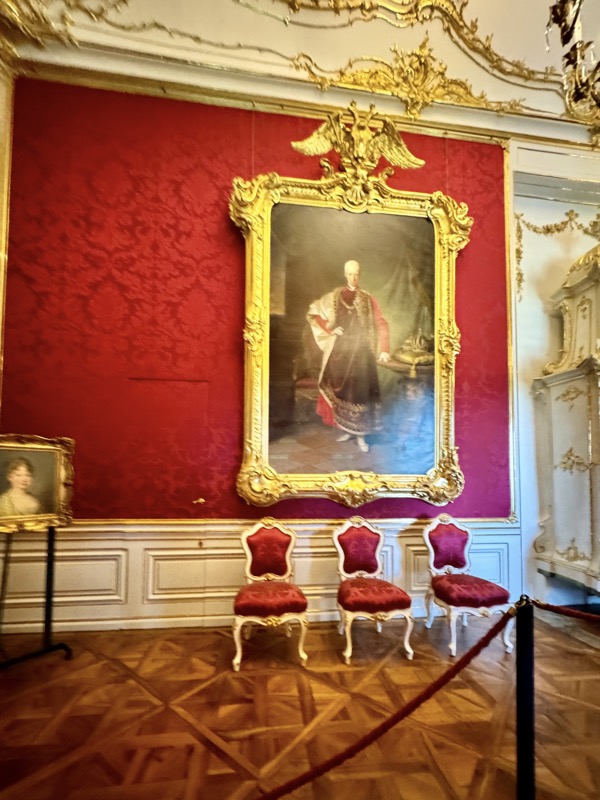
Rich Room.
The Rich Room does its name full justice, on display here is Maria Theresa’s state bed with its lavishly embroidered covers and hanging. Love it!
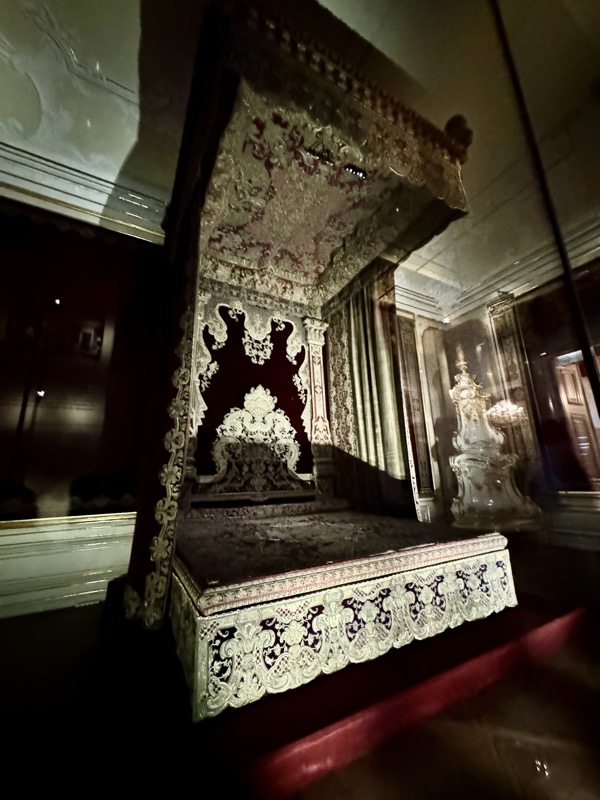
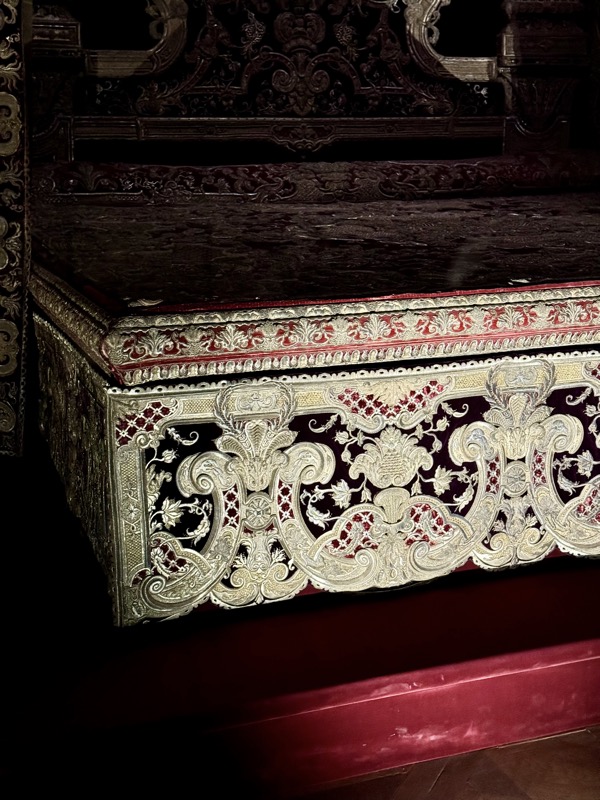
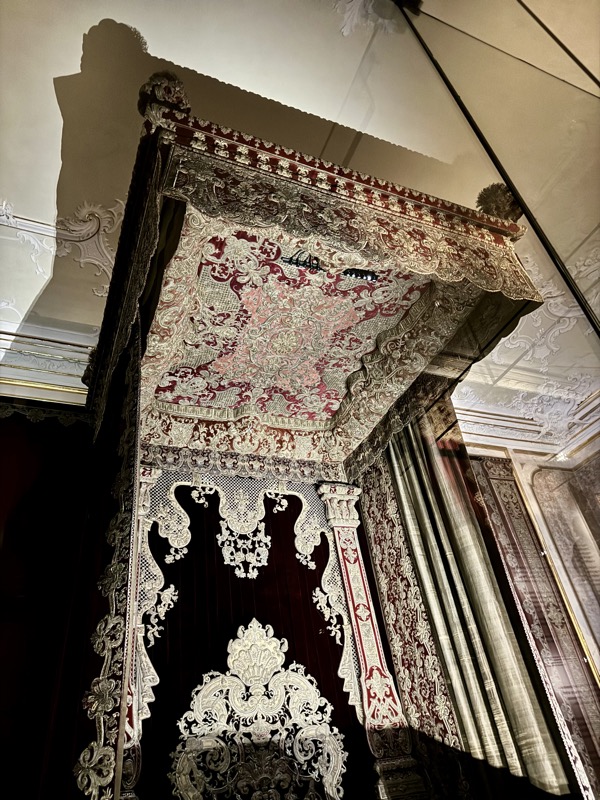
Salon of Archduke Franz Karl – a glass door allows a view into the corner salon, which is decorated with life-size portraits of Maria Theresa’s children.
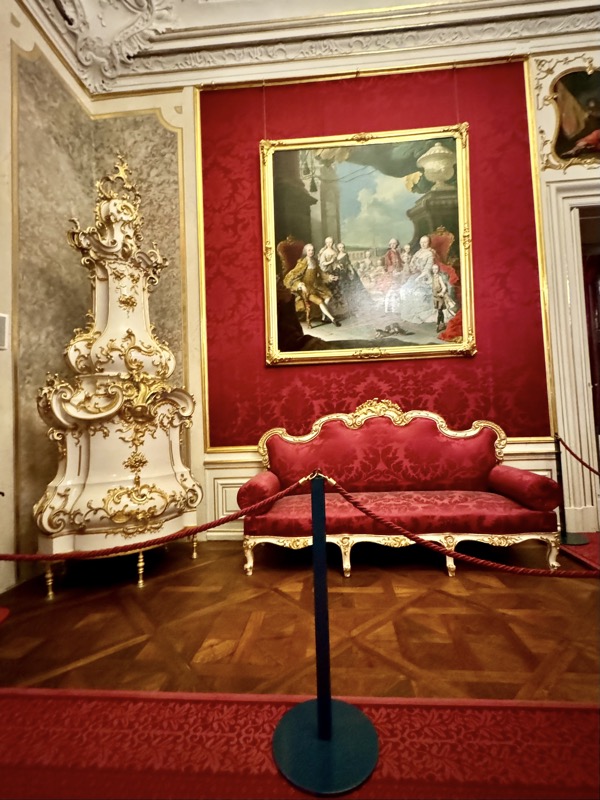
I didn’t take a lot of photos of the corridors and staircases (I say staircases for there are several!), but there are plenty of statuary placed around the common areas of the palace, much of which doesn’t have any plaques informing visitors of the artist or the content. Though this one is most likely Hercules defeating the Lion.
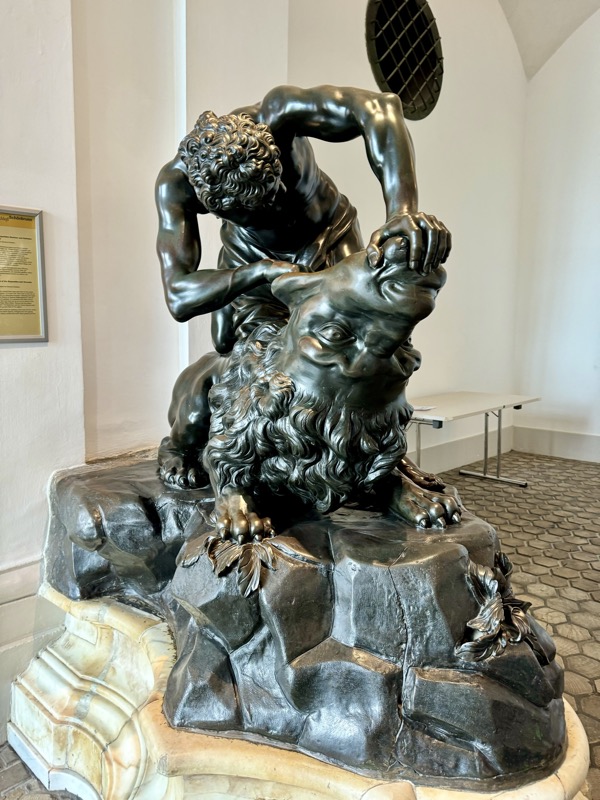
All up a cool, slightly confusing visit to the Shönbrunn… I wish I had taken some pictures of the gift shop and the posters around the palace that were all, ‘Sisi this, Sisi that!’ Poor Maria Theresa, how was she to know she would need a better post humours PR machine 300 years after her death. Netflix, you have a lot to answer for!

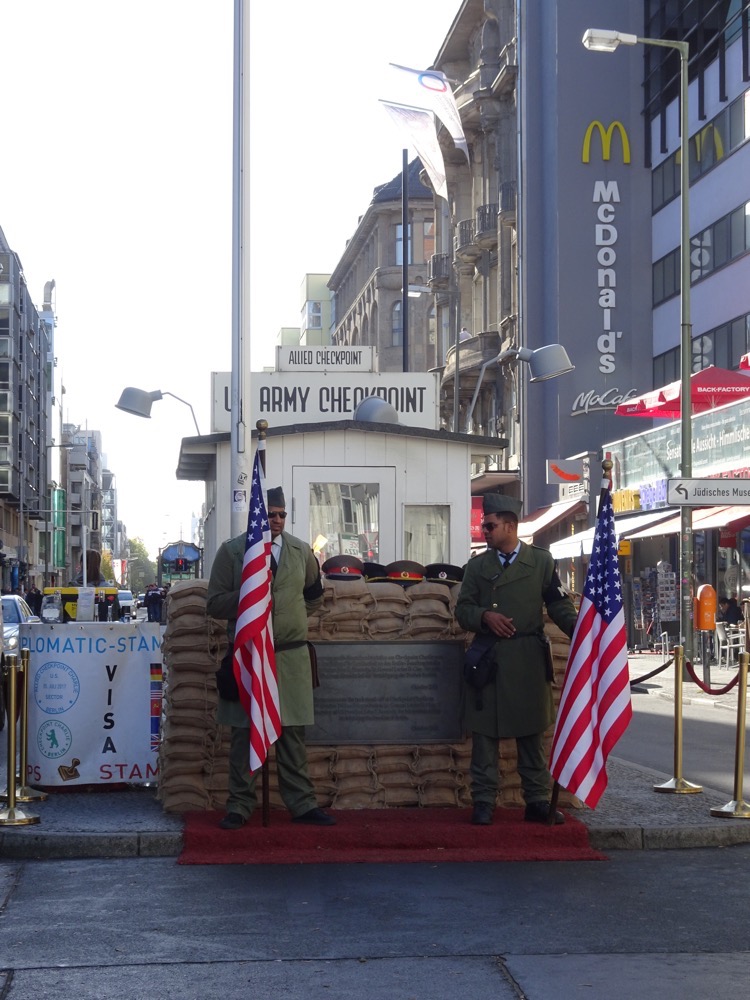
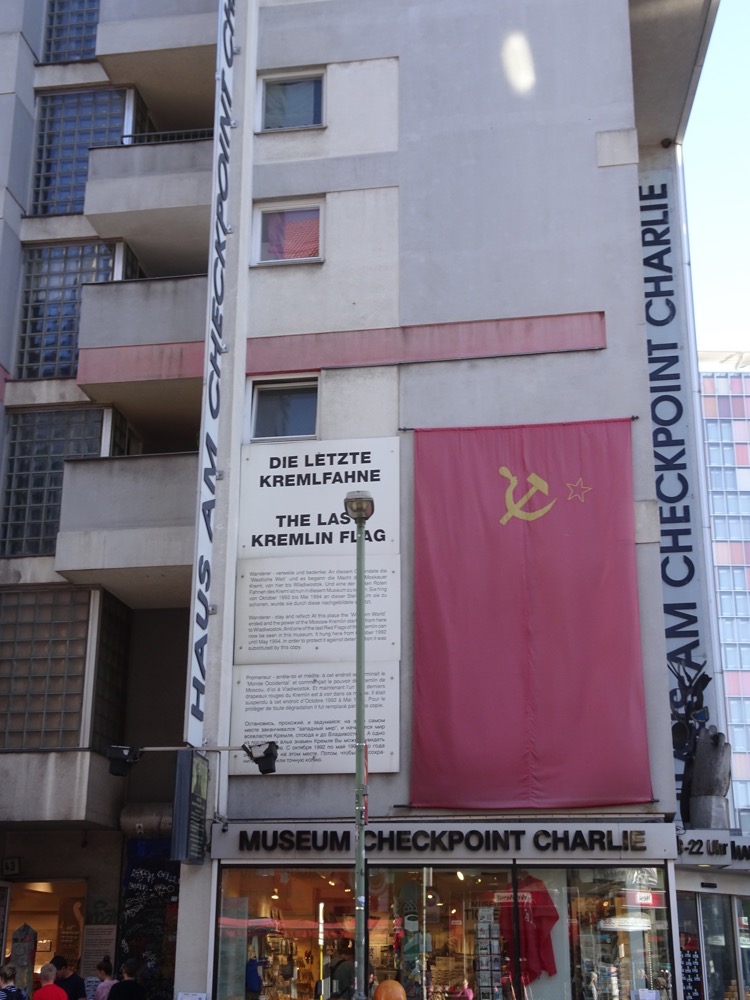 Train stations in Berlin are nowhere near as deep as London, New York or Kyiv and definitely not as pretty as Moscow or St Petersburg – but some of them make a striking statement. At the Checkpoint Charlie end:
Train stations in Berlin are nowhere near as deep as London, New York or Kyiv and definitely not as pretty as Moscow or St Petersburg – but some of them make a striking statement. At the Checkpoint Charlie end: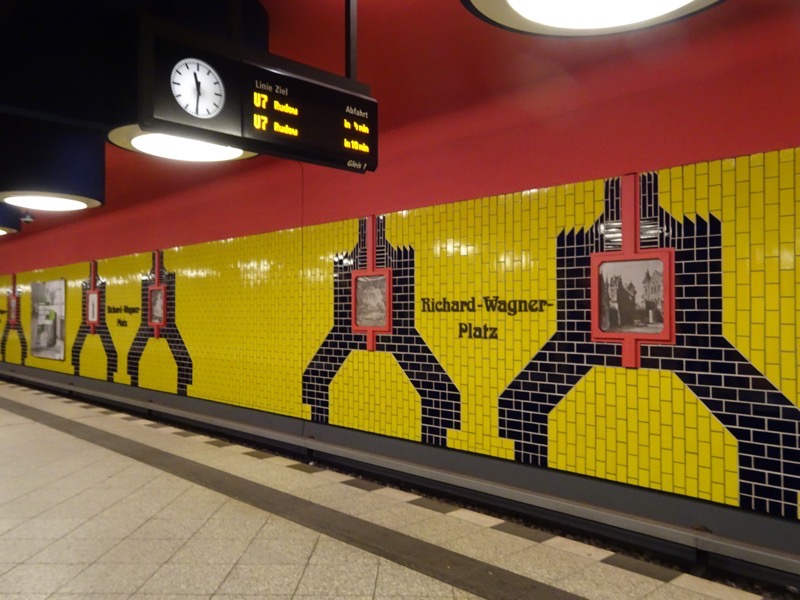 And copies of golden mosaics representing historical rulers of Saxony, Prussia and who knows where else, at the other end.
And copies of golden mosaics representing historical rulers of Saxony, Prussia and who knows where else, at the other end.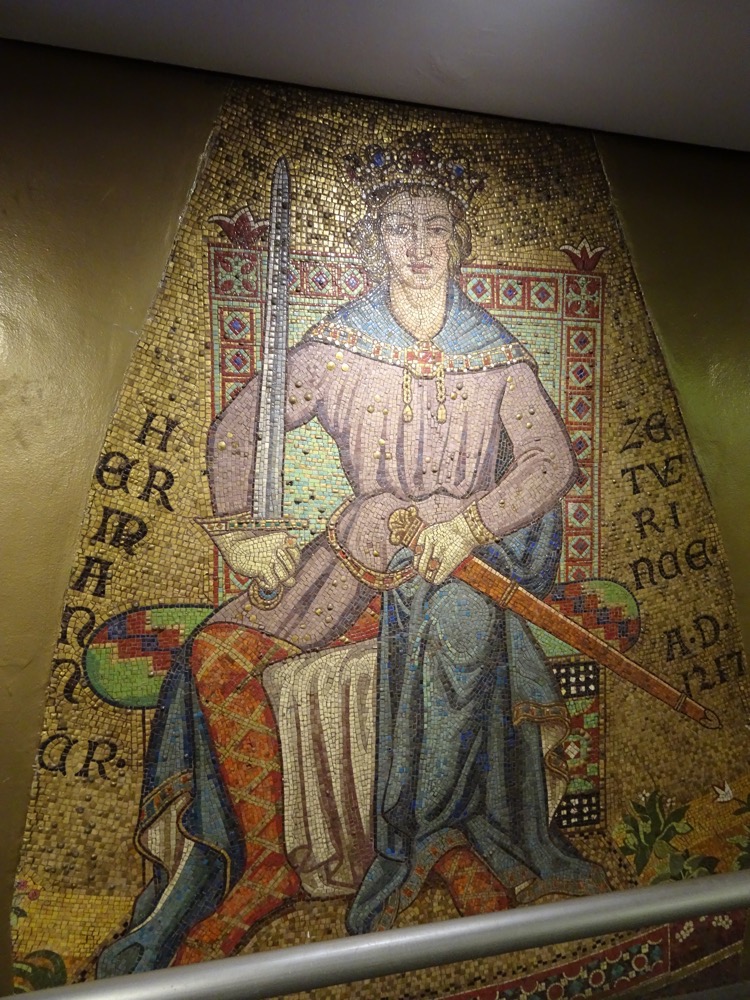
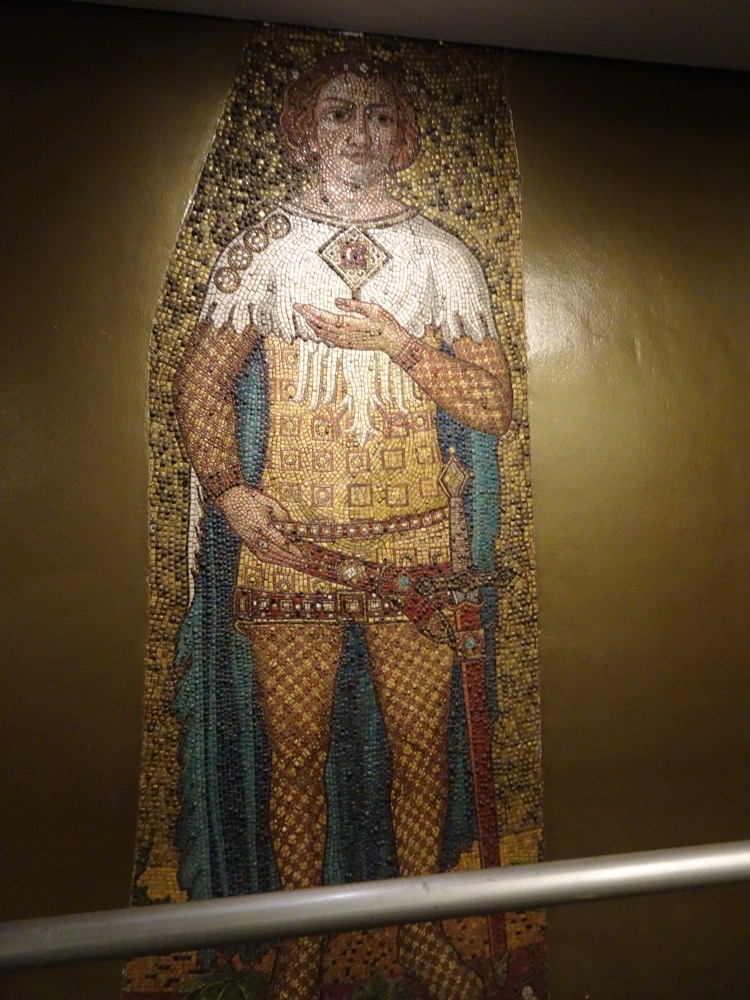 I haven’t managed to photograph many Berlin Bears – whenever we see them, there are usually annoying tourist standing with them for ten minutes or more trying to get that elusive perfect selfie, so we have mostly just passed by them.
I haven’t managed to photograph many Berlin Bears – whenever we see them, there are usually annoying tourist standing with them for ten minutes or more trying to get that elusive perfect selfie, so we have mostly just passed by them.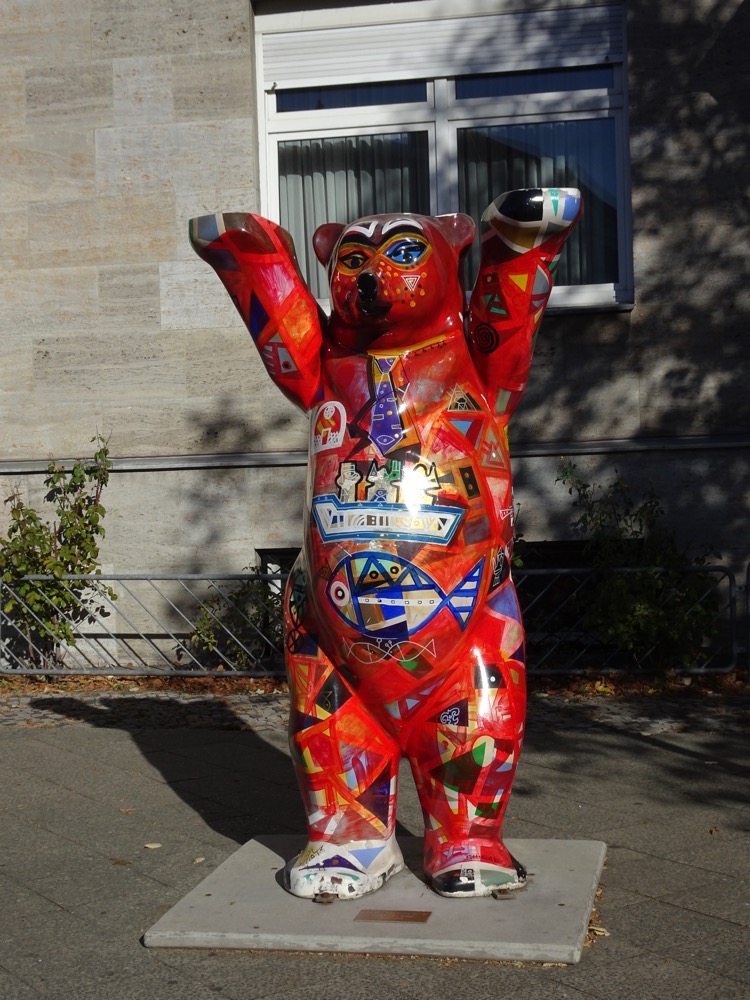 Charlottenburg Palace was originally built at the end of the 17th century, and then expanded upon enormously following century. It is done in extravagant baroque and rococo styles as of course was fitting for the woman who commissioned it, Sophie Charlotte, the wife of Friedrich I who was Elector of Brandenburg at the time.
Charlottenburg Palace was originally built at the end of the 17th century, and then expanded upon enormously following century. It is done in extravagant baroque and rococo styles as of course was fitting for the woman who commissioned it, Sophie Charlotte, the wife of Friedrich I who was Elector of Brandenburg at the time.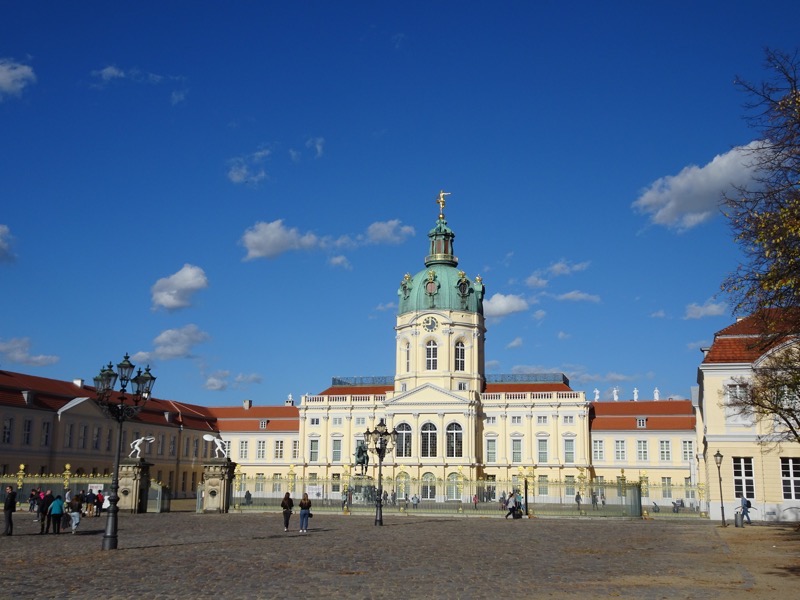 Friedrich crowned himself as King Friedrich I in Prussia in 1701 having two years earlier appointed Johann Friedrich von Eosander to be his royal architect on the extension project. Von Eosander spent a great deal of time in Italy and France studying places like Versailles, and I think that influence is fairly evident. When the royal architect returned in 1702 he put into place his plans to extend the palace to have two large wings and a courtyard in the front, and to also extend the entire length of the main building as well. Poor Sophie Charlotte died in 1705, long before it was finished and Friedrich named the palace, ‘Charlottenburg’ in her memory. Mind you, that’s him up there on that horse right out front of the place… not her.
Friedrich crowned himself as King Friedrich I in Prussia in 1701 having two years earlier appointed Johann Friedrich von Eosander to be his royal architect on the extension project. Von Eosander spent a great deal of time in Italy and France studying places like Versailles, and I think that influence is fairly evident. When the royal architect returned in 1702 he put into place his plans to extend the palace to have two large wings and a courtyard in the front, and to also extend the entire length of the main building as well. Poor Sophie Charlotte died in 1705, long before it was finished and Friedrich named the palace, ‘Charlottenburg’ in her memory. Mind you, that’s him up there on that horse right out front of the place… not her.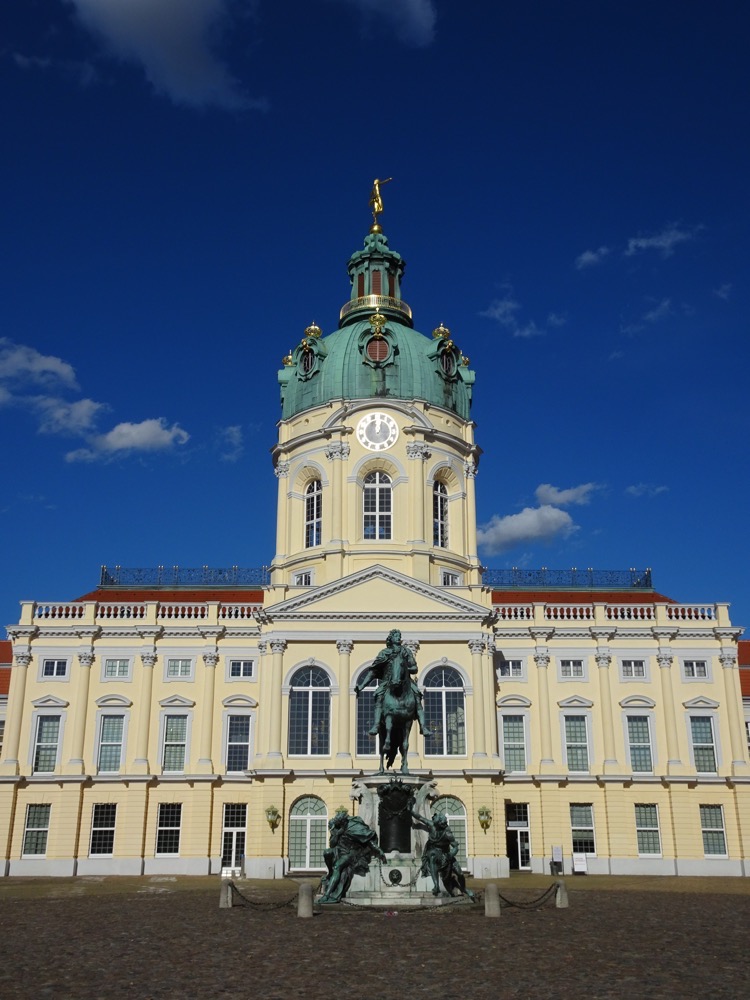 The Orangerie off to the left side of the palace.
The Orangerie off to the left side of the palace.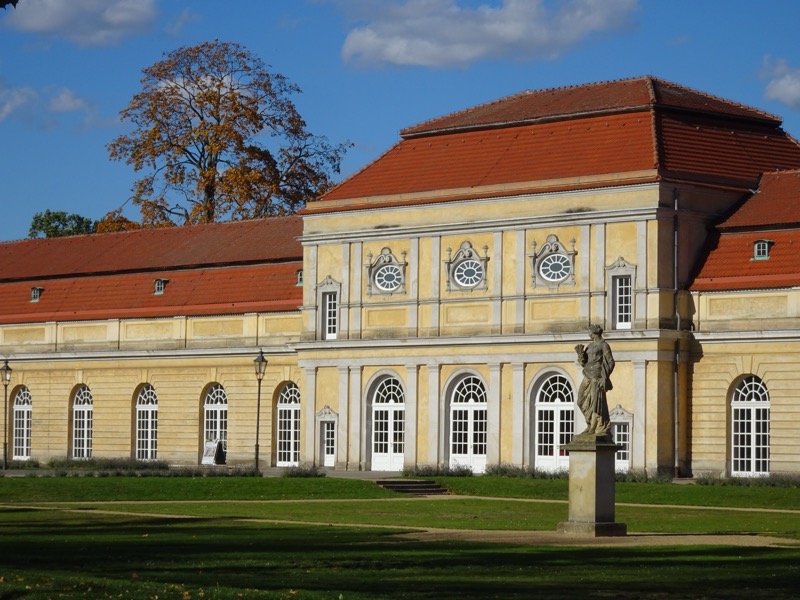 The dressing room to the ‘Mecklenburg Apartment’ which comprises of three rooms that were used to receive relatives from the House of Mecklenburg. The relief images above the doors are all original as are the parquetry floors, the fireplace and wooden panelling.
The dressing room to the ‘Mecklenburg Apartment’ which comprises of three rooms that were used to receive relatives from the House of Mecklenburg. The relief images above the doors are all original as are the parquetry floors, the fireplace and wooden panelling.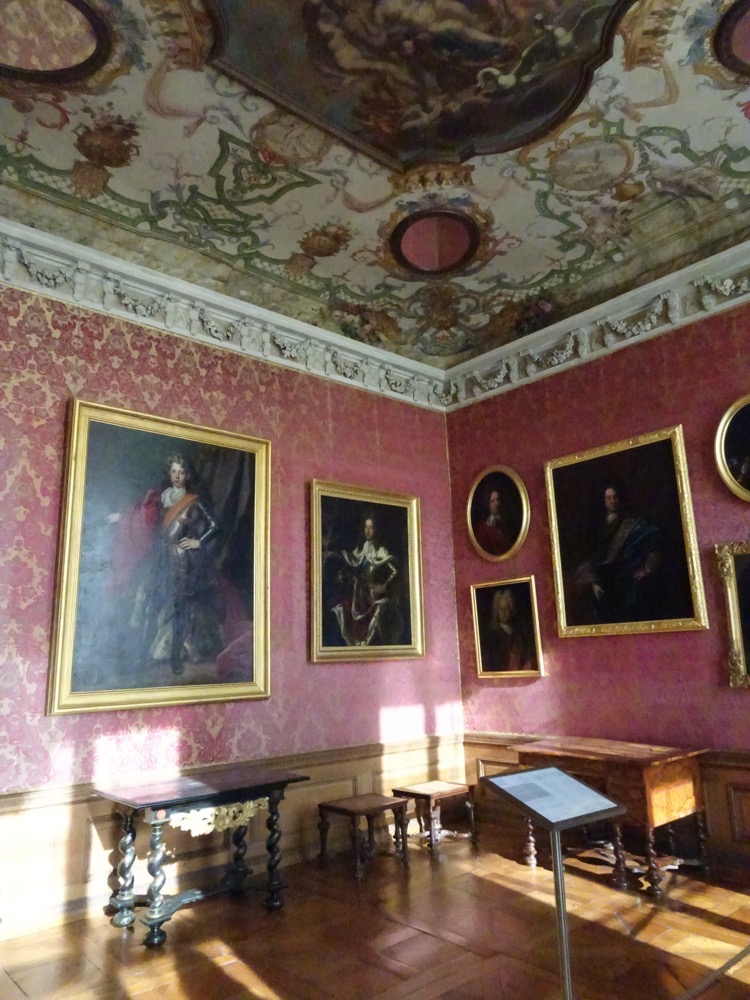
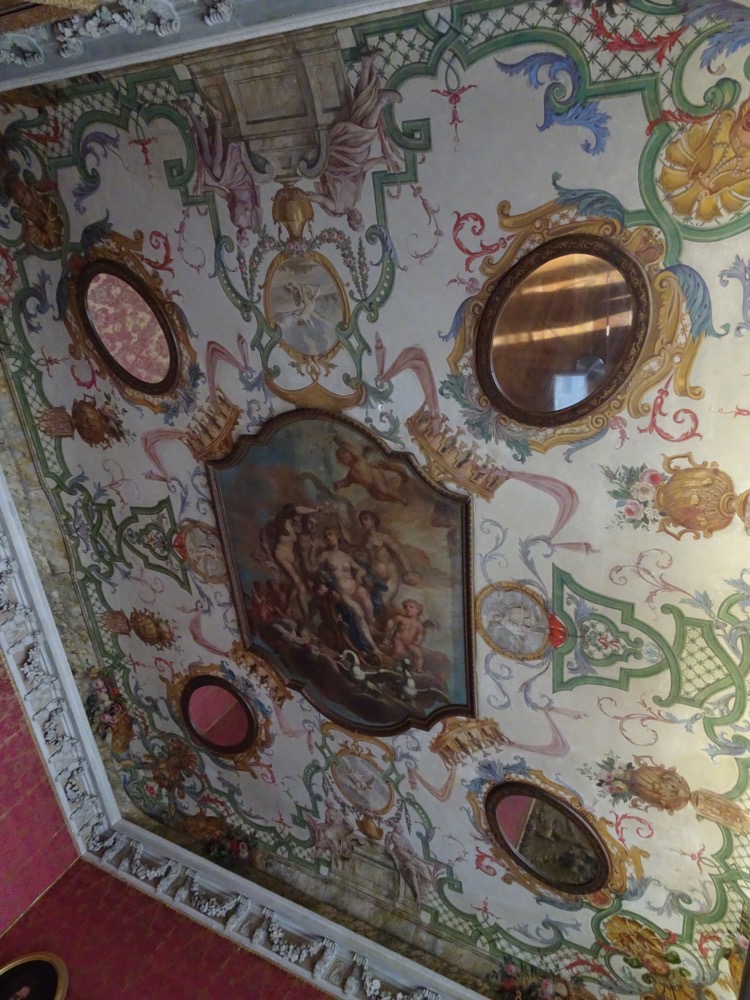
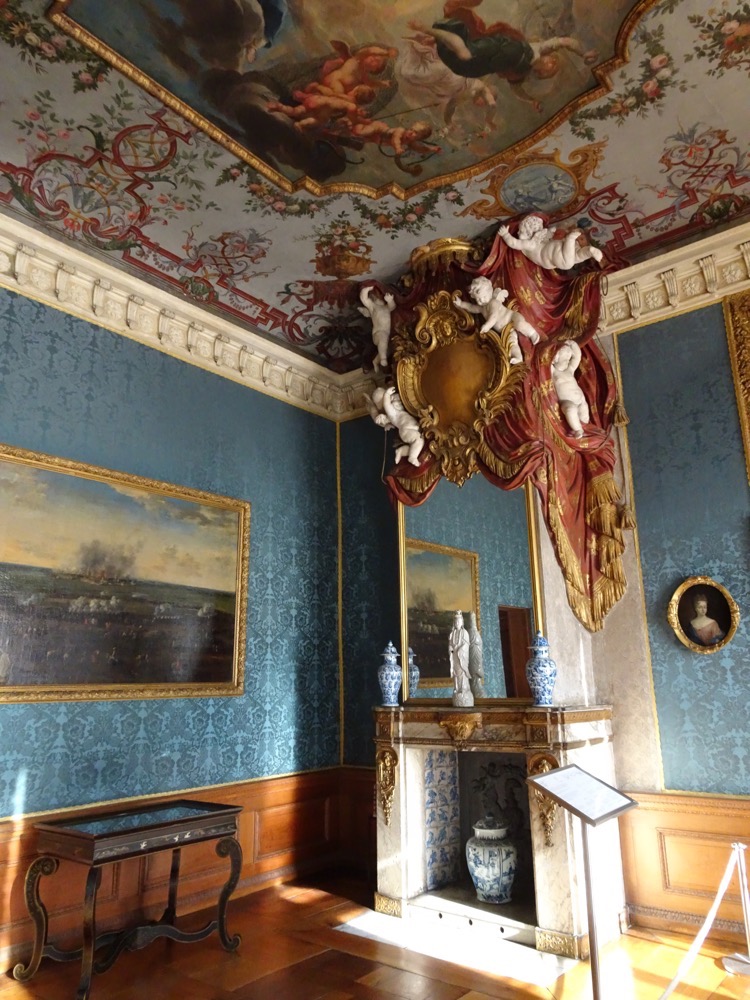
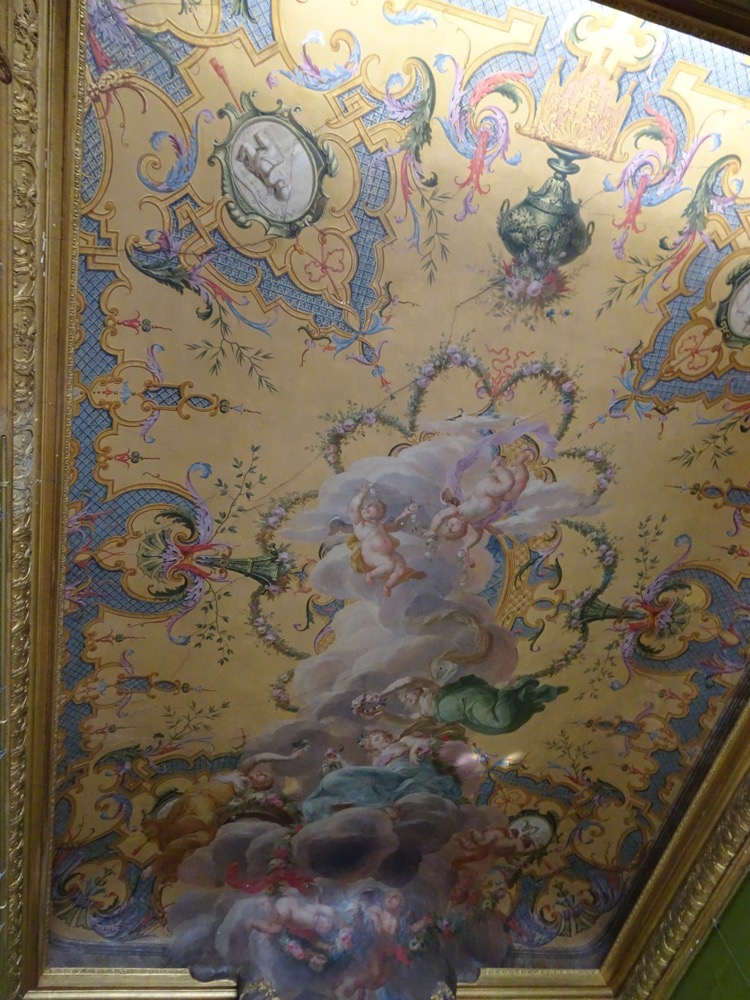
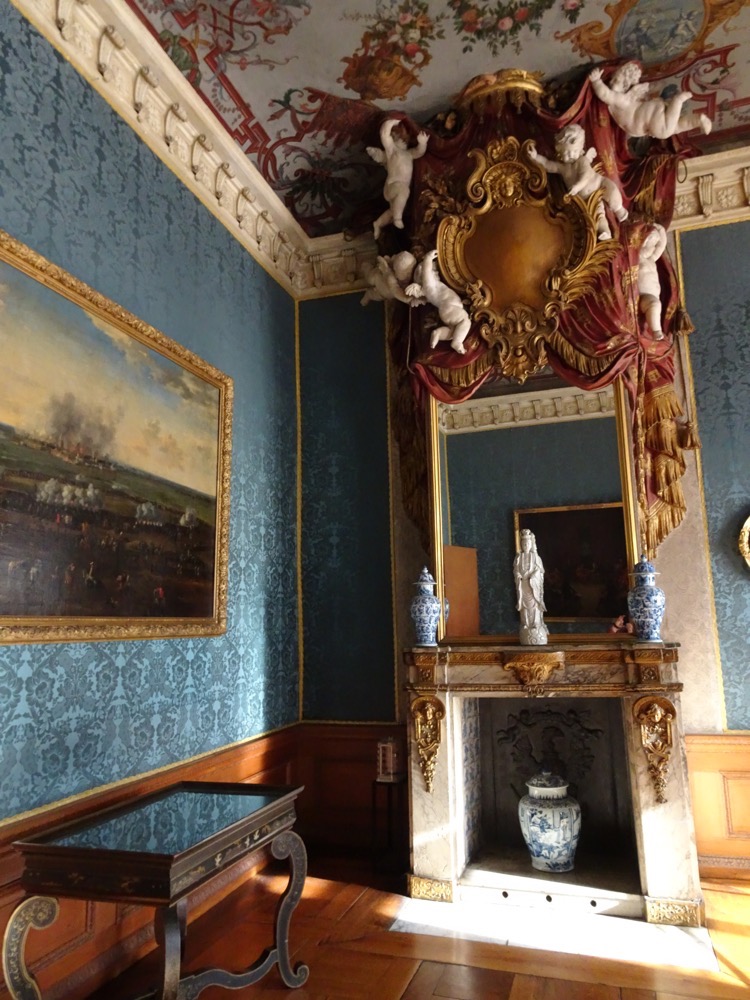 The Old Gallery – this was damaged considerably in 1943, so the oak panelling and the paintings are all copies.
The Old Gallery – this was damaged considerably in 1943, so the oak panelling and the paintings are all copies. 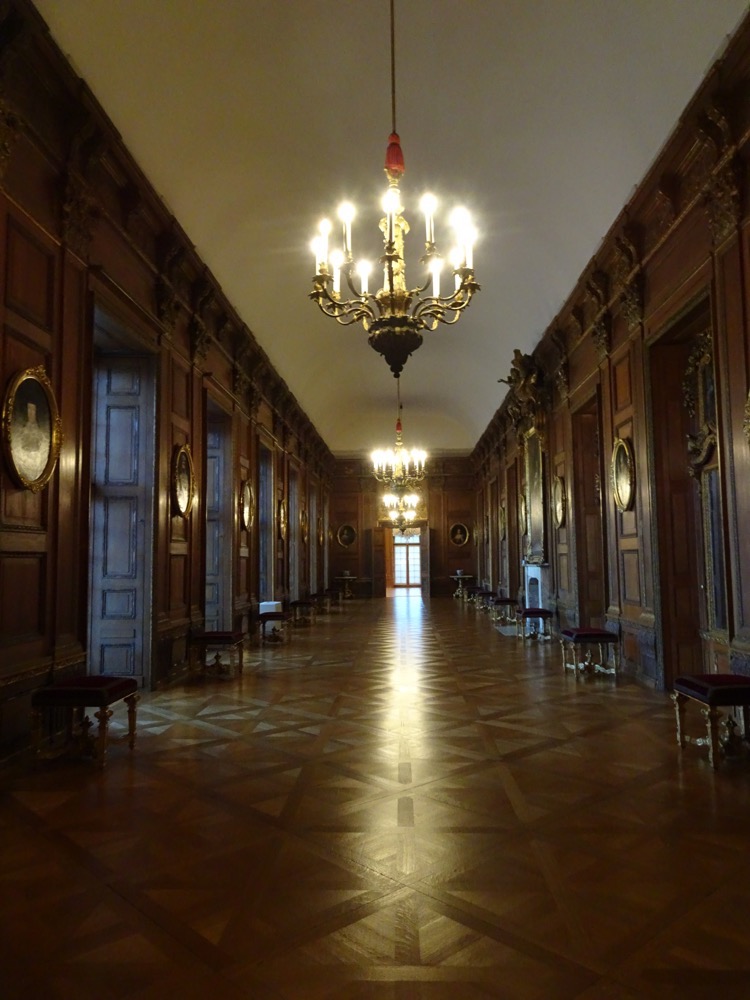 There is a pair of these candlesticks, but they are in vitrines so far apart that it’s nearly impossible to photograph the pair together. They were made for King Frederick William I from the Silver Buffet at the Berlin Palace. The candlesticks were entirely cast in solid silver and are the last items remaining of the Prussian royal palaces’ silver setting. Friedrich apparently placed extensive commissions with the south German master goldsmiths of Auber (more than any other German Prince) and his orders for just three years from 1730 to 1733 included 85 silver objects with a total weight of over 8 tonnes. Only six works have survived including these two (of ten) candlesticks. All the other works were melted down in the mid 1700s and early 1800s. They’re enormous – all monograms and Prussian eagles.
There is a pair of these candlesticks, but they are in vitrines so far apart that it’s nearly impossible to photograph the pair together. They were made for King Frederick William I from the Silver Buffet at the Berlin Palace. The candlesticks were entirely cast in solid silver and are the last items remaining of the Prussian royal palaces’ silver setting. Friedrich apparently placed extensive commissions with the south German master goldsmiths of Auber (more than any other German Prince) and his orders for just three years from 1730 to 1733 included 85 silver objects with a total weight of over 8 tonnes. Only six works have survived including these two (of ten) candlesticks. All the other works were melted down in the mid 1700s and early 1800s. They’re enormous – all monograms and Prussian eagles.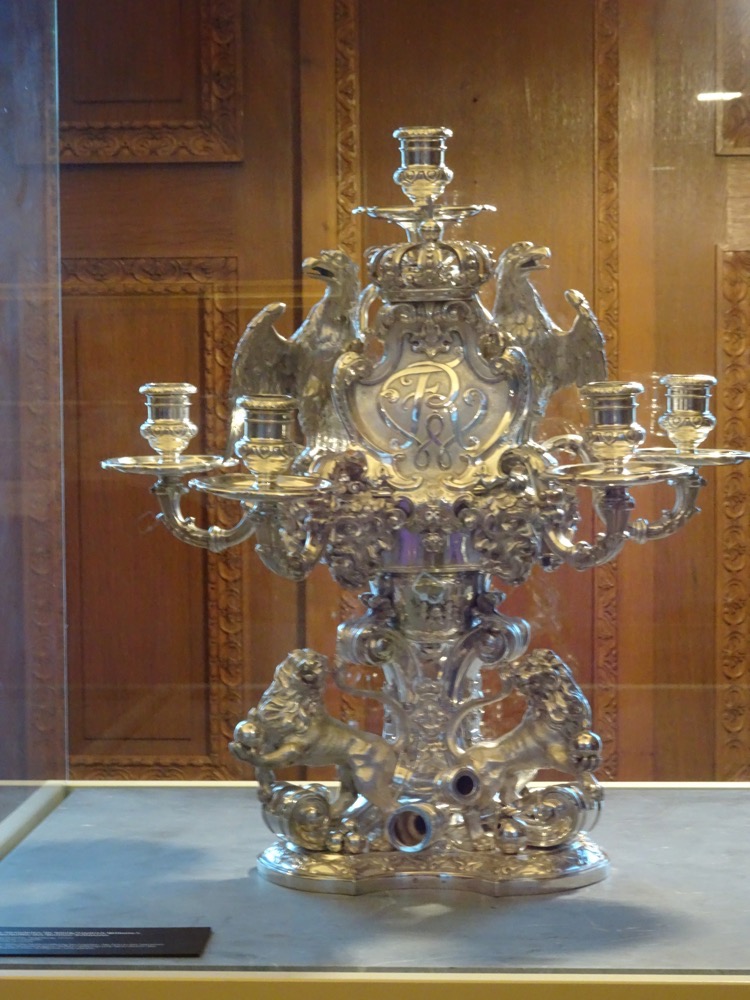
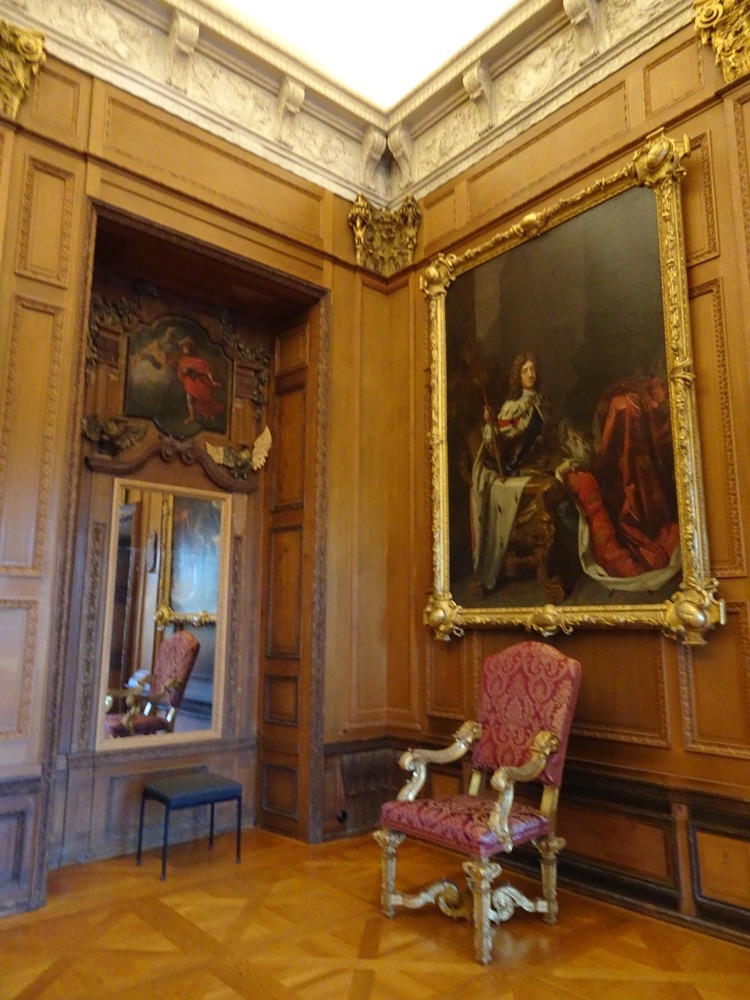 The aptly named, Mirror Panelled Bed Chamber was part of Sophie’s original five room apartments. The mirrors were to reflect the lavish gardens outside.
The aptly named, Mirror Panelled Bed Chamber was part of Sophie’s original five room apartments. The mirrors were to reflect the lavish gardens outside.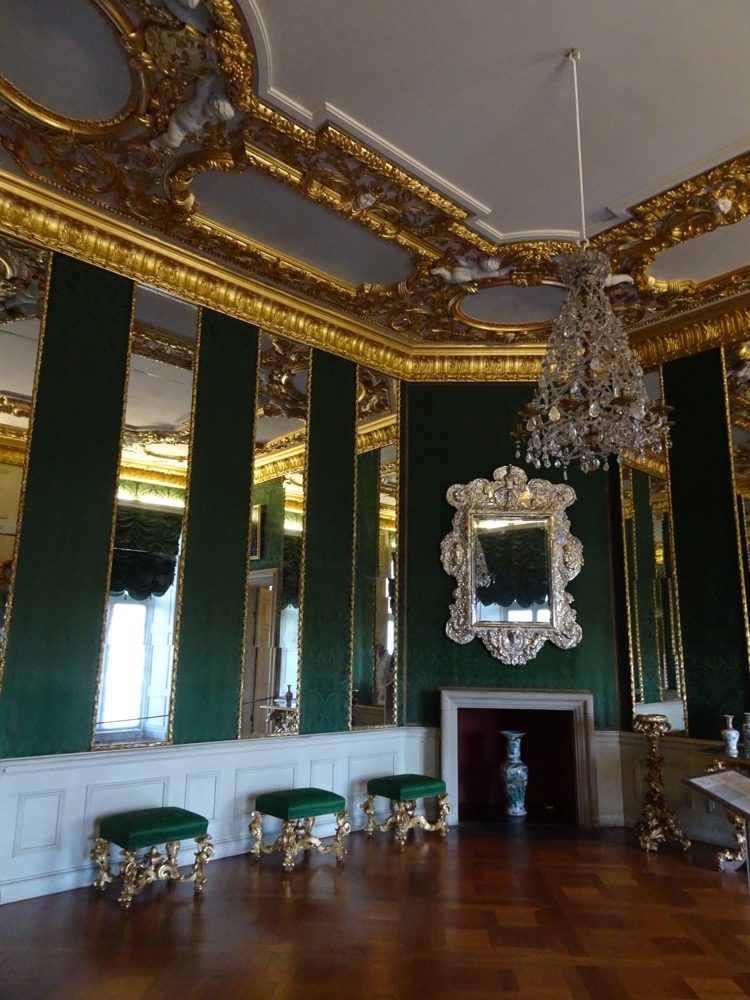 This section of the Palace too, was badly damanged in WWII and has been recreated to be a fair approximation of what was here earlier.
This section of the Palace too, was badly damanged in WWII and has been recreated to be a fair approximation of what was here earlier.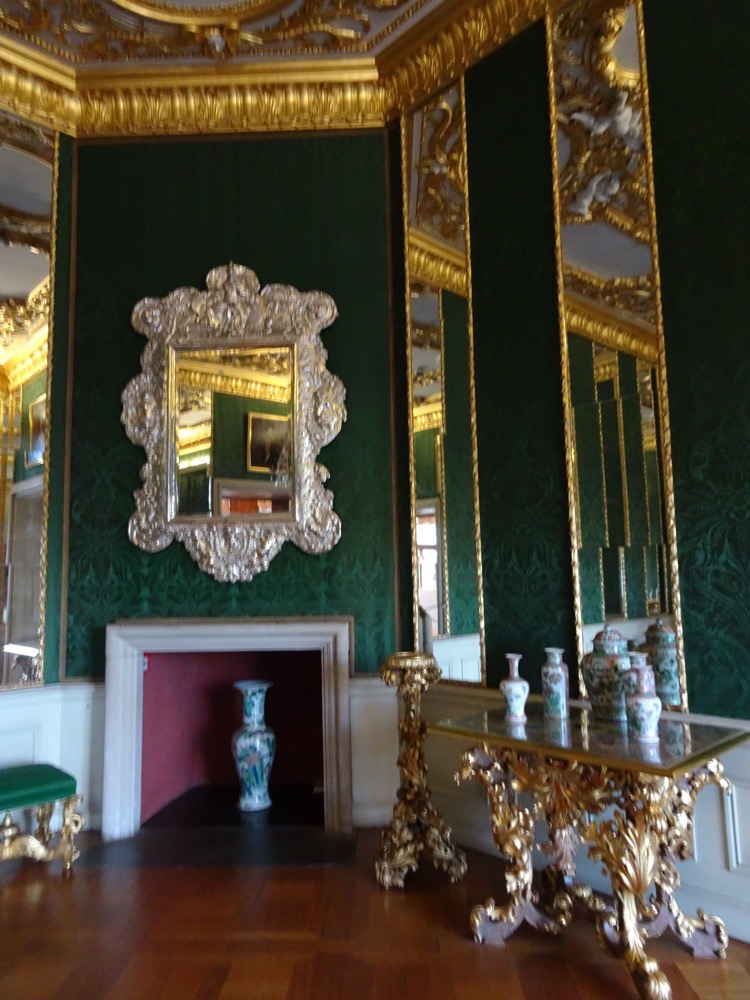
 One of Sophie’s antechambers.
One of Sophie’s antechambers.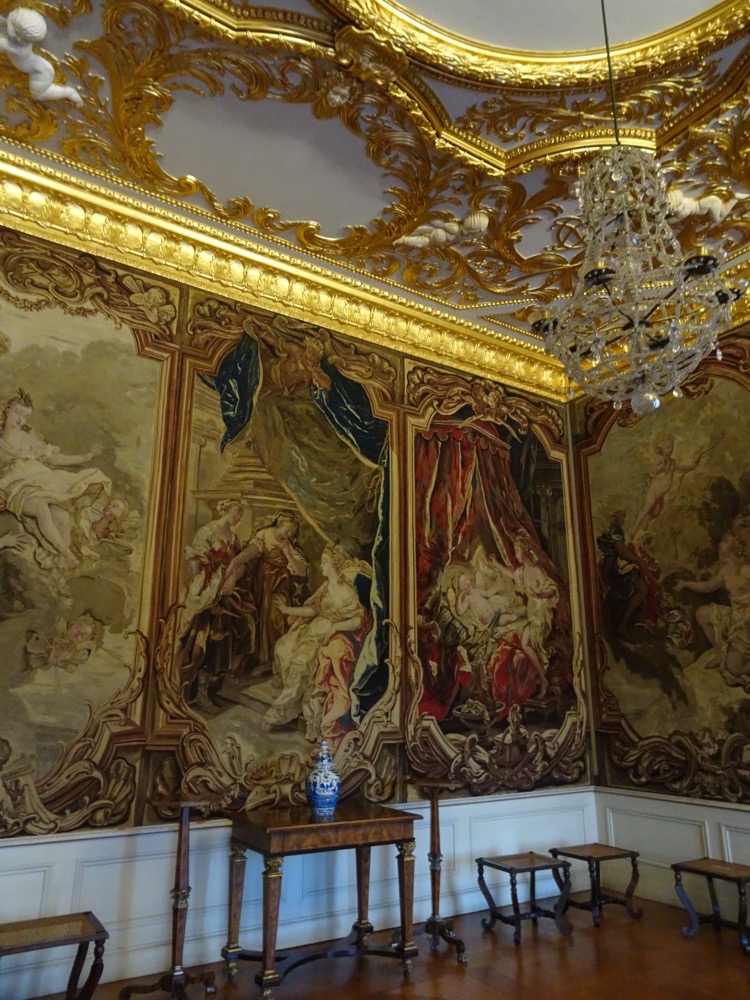
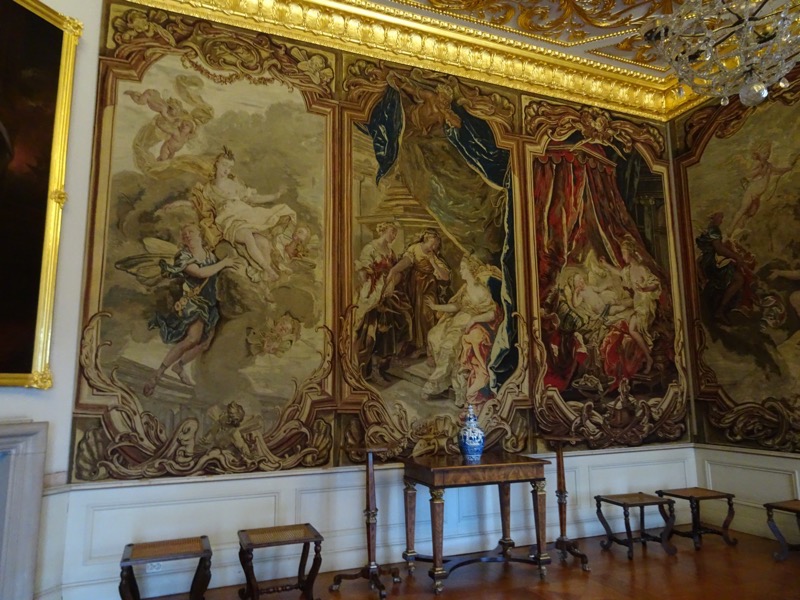 Cupid and Psyche are kinda evident everywhere.
Cupid and Psyche are kinda evident everywhere.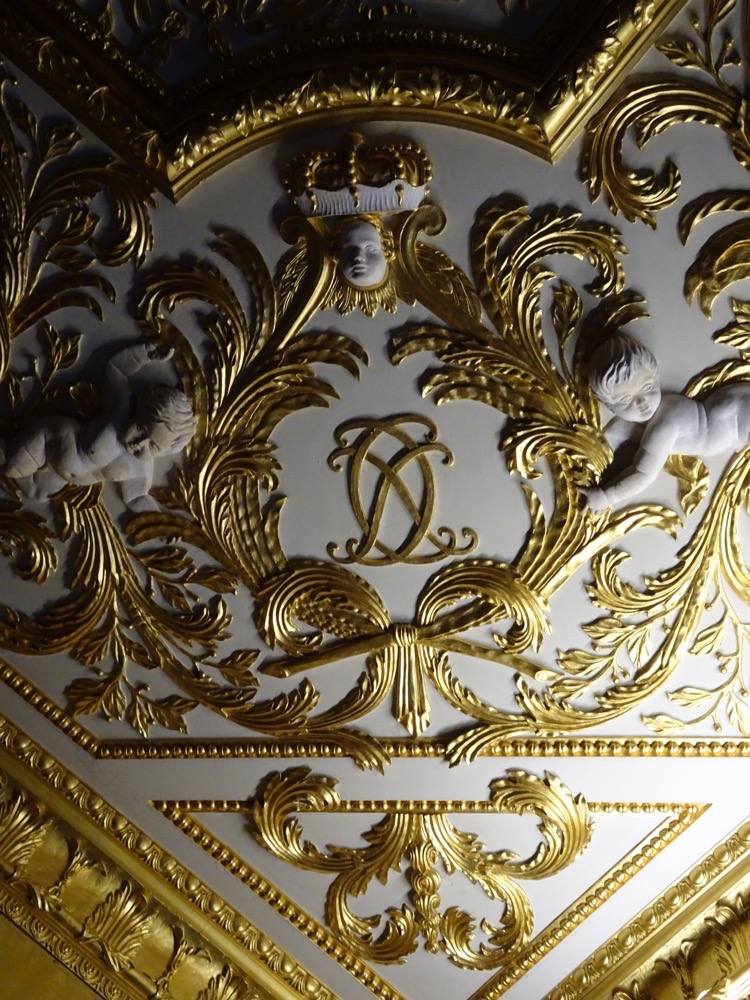 The Long Oval Hall was an entrance and recption area before the palace was extended, after which it became one of Sophie’s private rooms, it has exceptional views out to the gardens. But again was severly damaged in WWII so has also been recreated.
The Long Oval Hall was an entrance and recption area before the palace was extended, after which it became one of Sophie’s private rooms, it has exceptional views out to the gardens. But again was severly damaged in WWII so has also been recreated.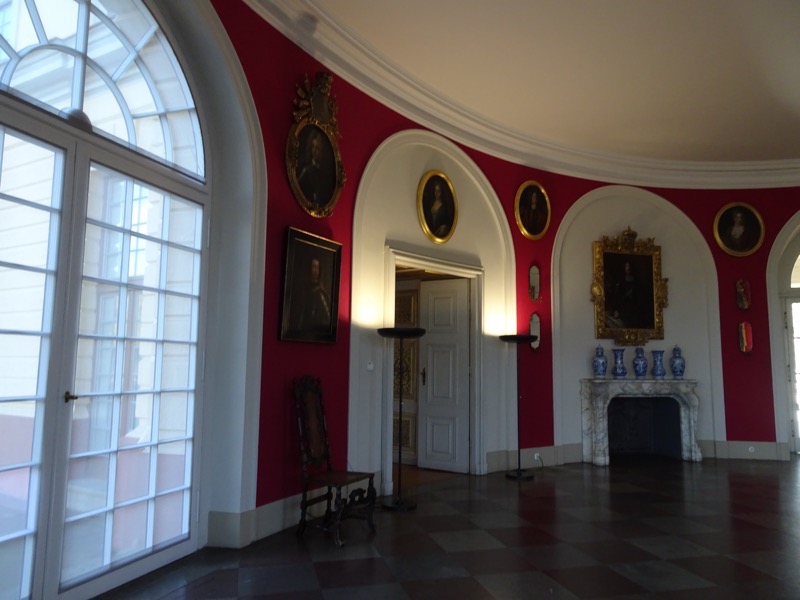 As we moved through the Palace we noticed quite a few chinoiserie ceramics. There seemed to be quite a lot of them for a palace of this style/age… little did we know.
As we moved through the Palace we noticed quite a few chinoiserie ceramics. There seemed to be quite a lot of them for a palace of this style/age… little did we know.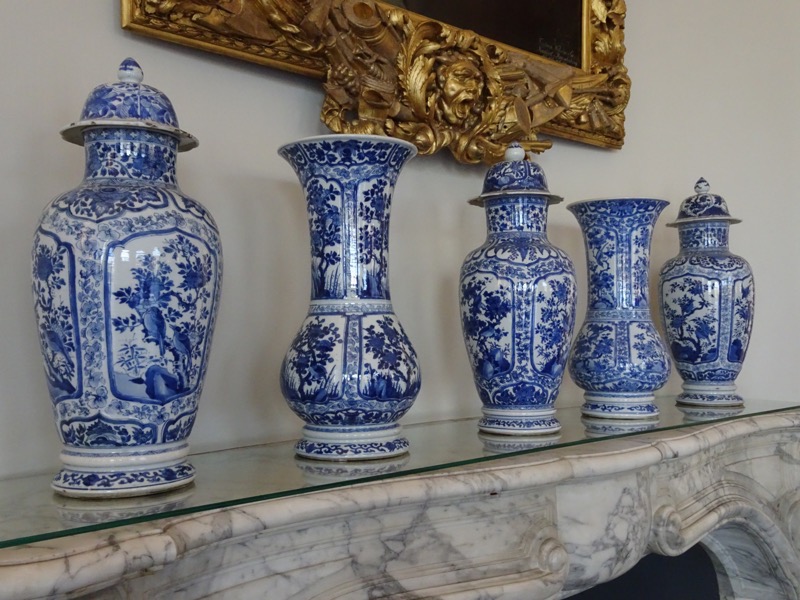 The Long Oval overlooked the formal gardens.
The Long Oval overlooked the formal gardens.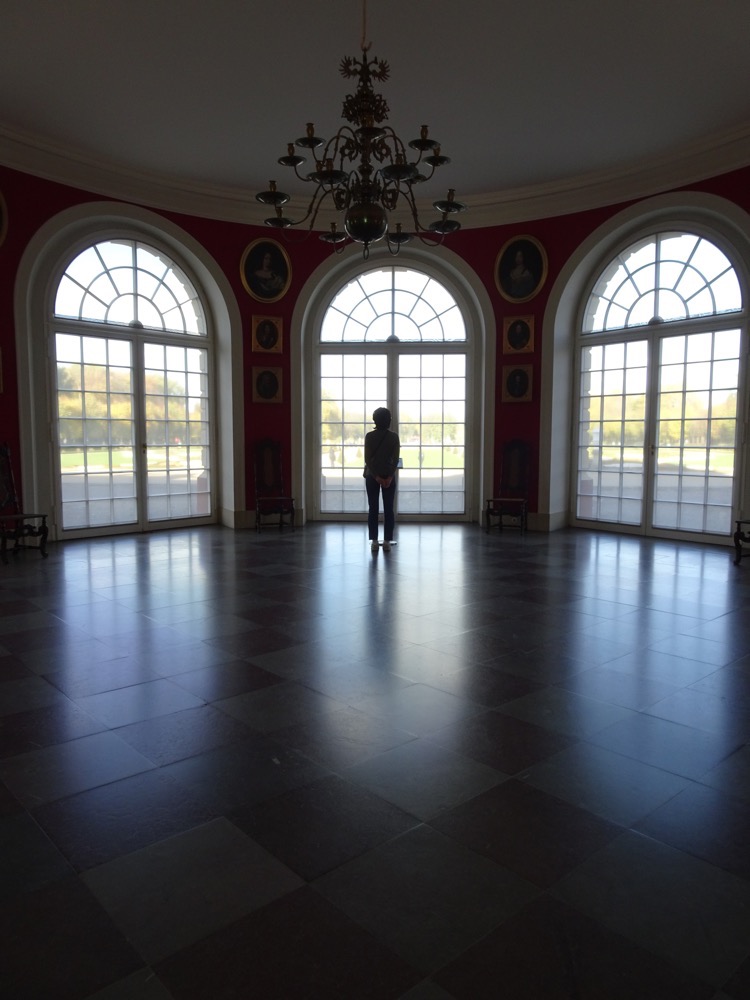
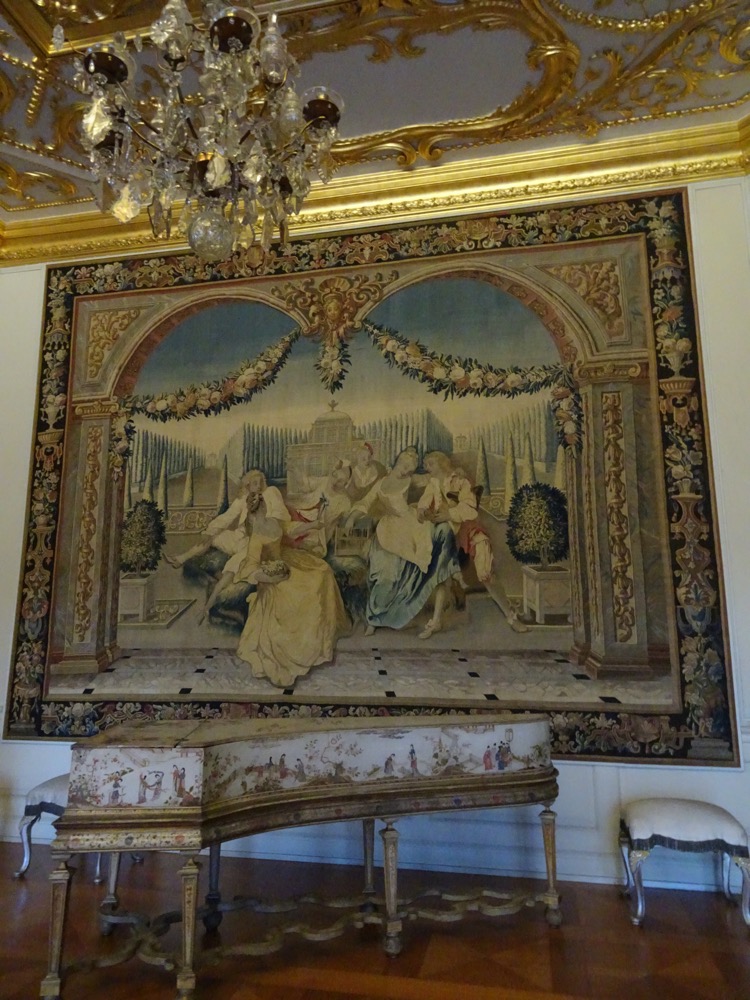 After Sophie’s death, Frederick used her second antechamber as a small audience chamber. The tapestries were added in 1740 by his grandson, however, all in here was also damaged so is copied or reconstructed. One of the placards I read in here said all the fireplaces had been deliberately built to have consoles for displaying porcelain.
After Sophie’s death, Frederick used her second antechamber as a small audience chamber. The tapestries were added in 1740 by his grandson, however, all in here was also damaged so is copied or reconstructed. One of the placards I read in here said all the fireplaces had been deliberately built to have consoles for displaying porcelain.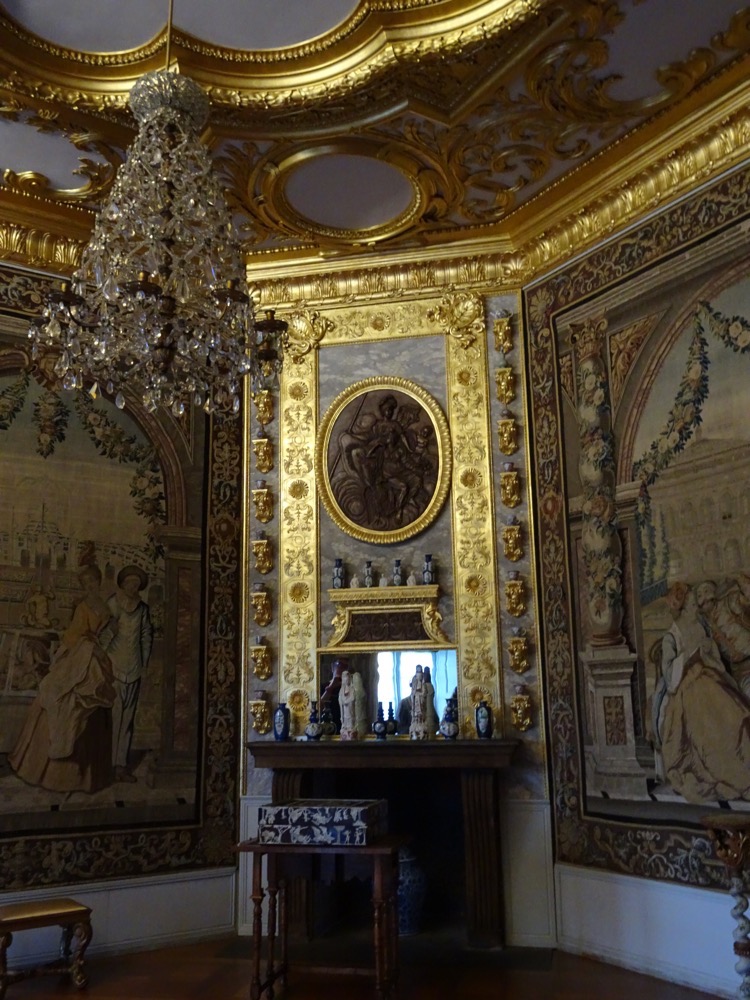
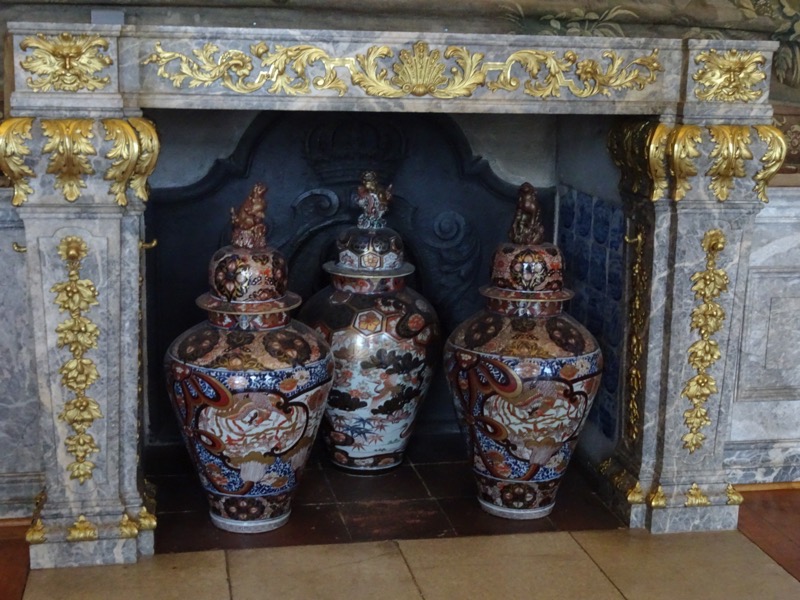
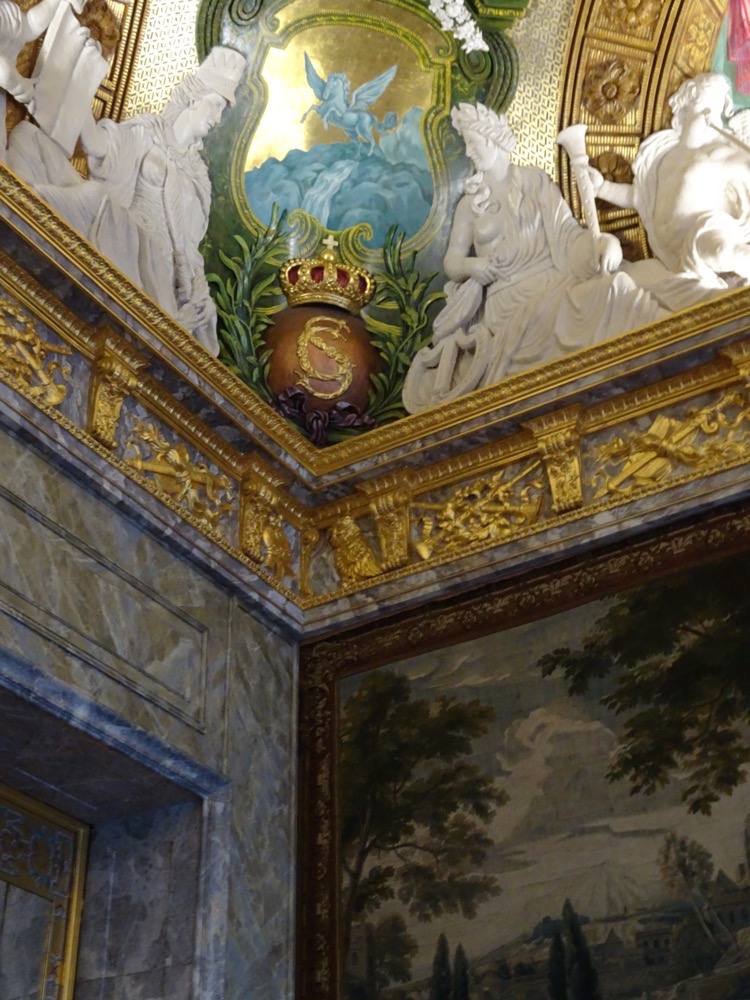 Another audience chamber, also demonstrating their particular fondness for ceramics.
Another audience chamber, also demonstrating their particular fondness for ceramics.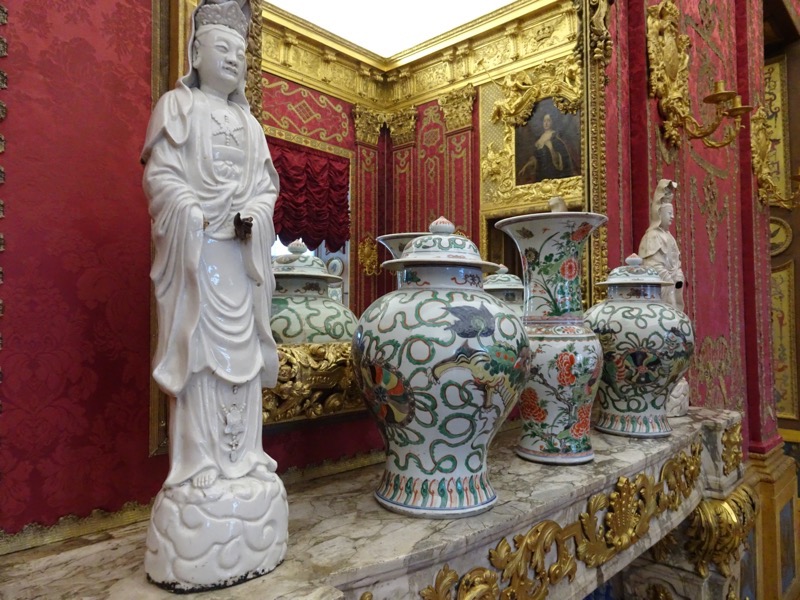
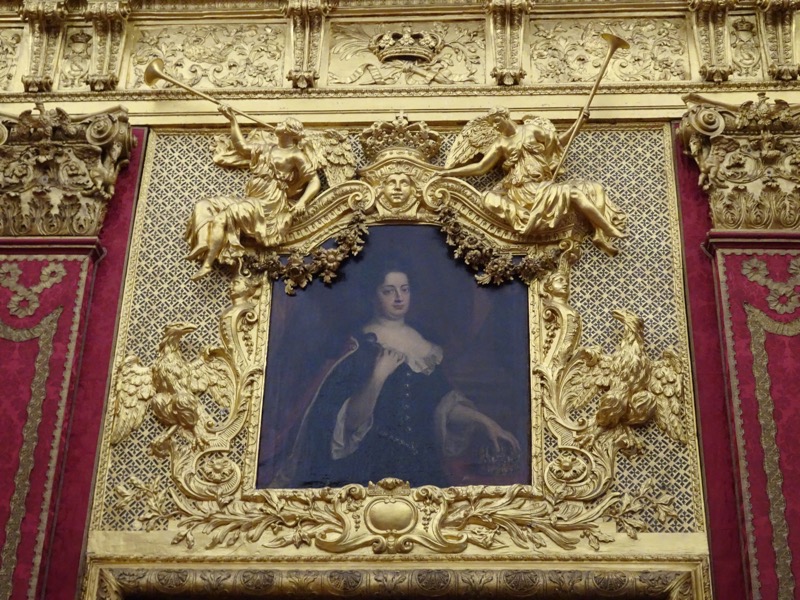 And a third audience chamber… there was little to indicate whether all these audience chambers served different purposes or were for people of varying levels of acquaintance (well nothing I saw in English anyway). However, this room indicated that it was for private audiences with intimate members of the family and the King and his guest would have chairs of equal size. It also had the most amazing ceiling that is painted on canvas and survived the war, so it is the original art.
And a third audience chamber… there was little to indicate whether all these audience chambers served different purposes or were for people of varying levels of acquaintance (well nothing I saw in English anyway). However, this room indicated that it was for private audiences with intimate members of the family and the King and his guest would have chairs of equal size. It also had the most amazing ceiling that is painted on canvas and survived the war, so it is the original art.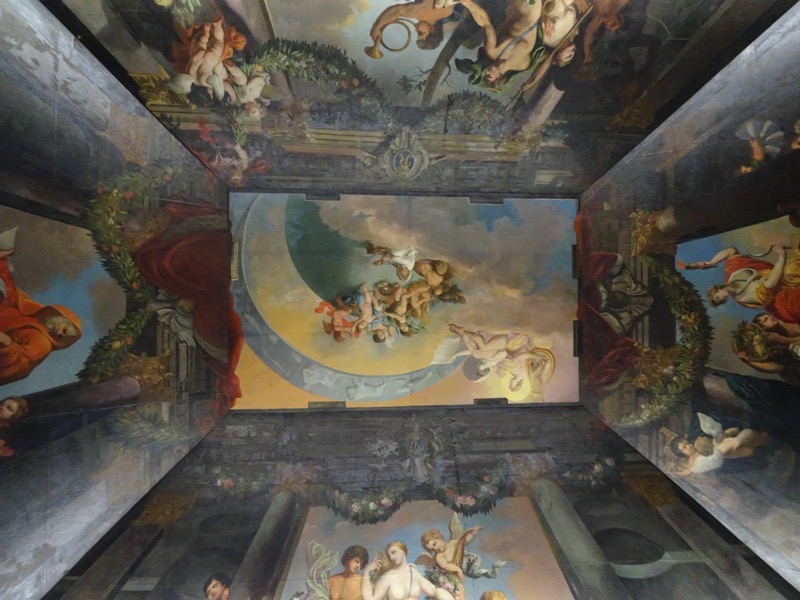 and more porcelain of course.
and more porcelain of course.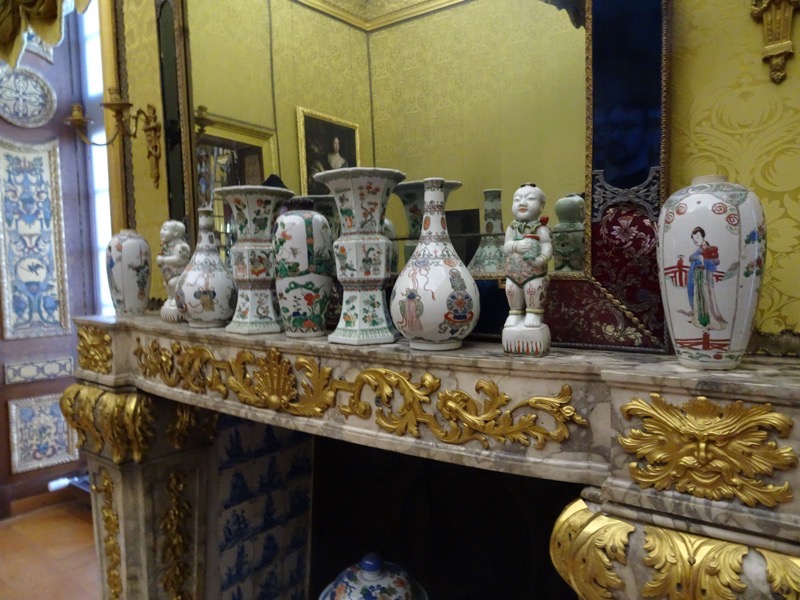
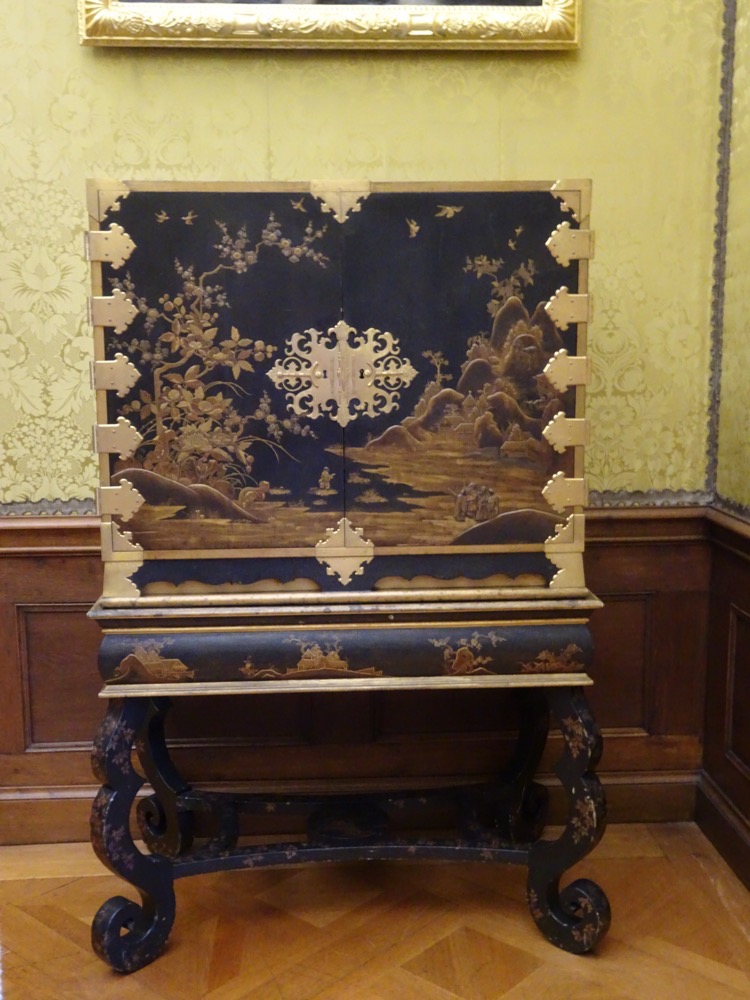 Which then led into ‘the Porcelain Cabinet’
Which then led into ‘the Porcelain Cabinet’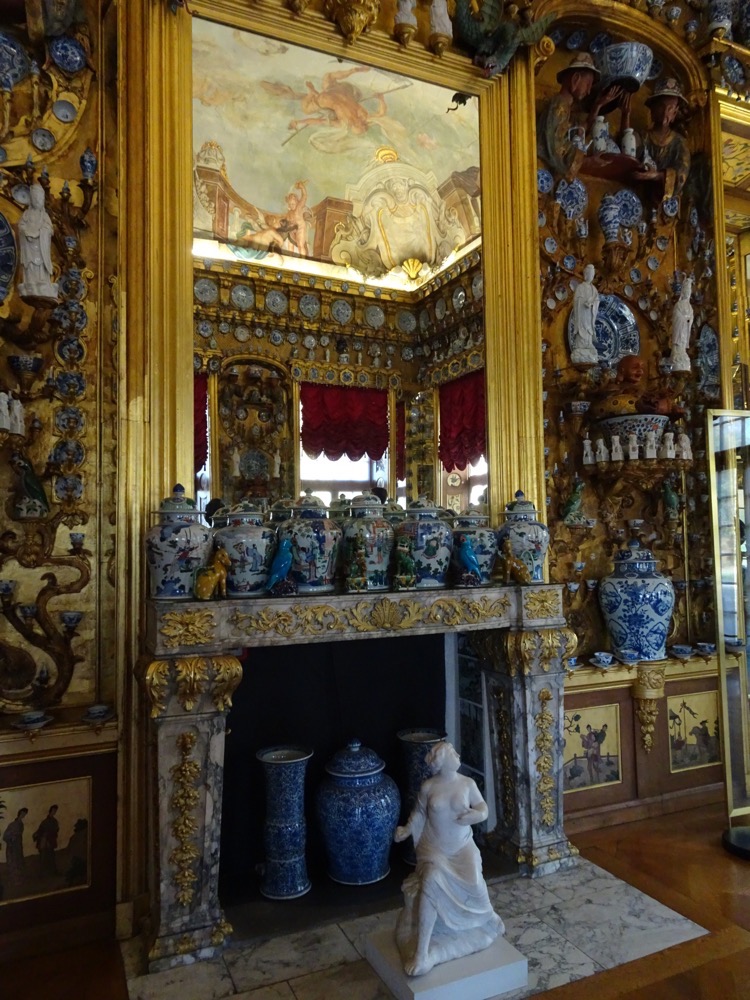 “The Porcelain Cabinet is the magnificent highlight of the 140m long flight of rooms on the palace’s garden side. However, when Sophie Charlotte died in 1705, the construction works were by no means finished and were not in fact completed until 1706. The walls have been designed in a way that shows the porcelain and figural motifs off to their best advantage. The ceiling murals painted in 1706 by Anthonie Coxie, are allegorical images glorifying the rise of the Prussian royal dynasty. The Cabinet was heavily damaged in 1943 and restored in 1967.”
“The Porcelain Cabinet is the magnificent highlight of the 140m long flight of rooms on the palace’s garden side. However, when Sophie Charlotte died in 1705, the construction works were by no means finished and were not in fact completed until 1706. The walls have been designed in a way that shows the porcelain and figural motifs off to their best advantage. The ceiling murals painted in 1706 by Anthonie Coxie, are allegorical images glorifying the rise of the Prussian royal dynasty. The Cabinet was heavily damaged in 1943 and restored in 1967.”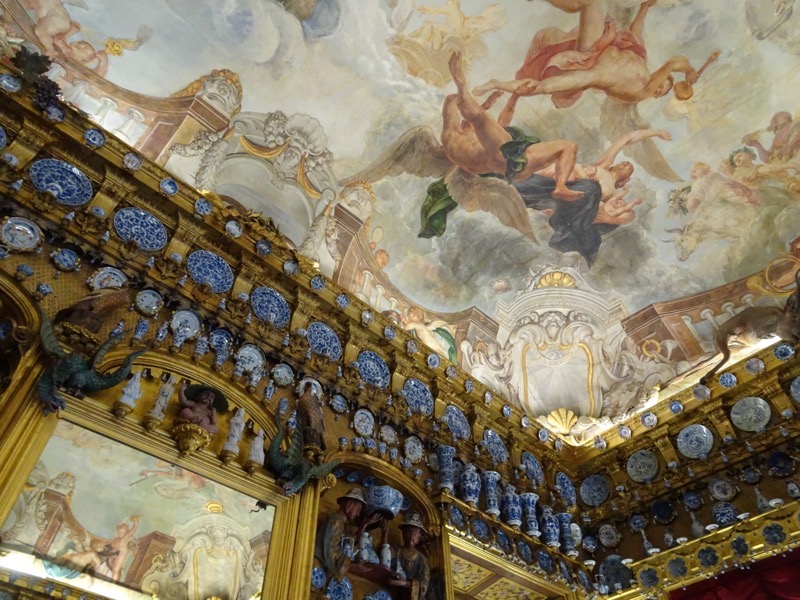 My how our sensibilities of what is ‘beautiful’ has changed.
My how our sensibilities of what is ‘beautiful’ has changed.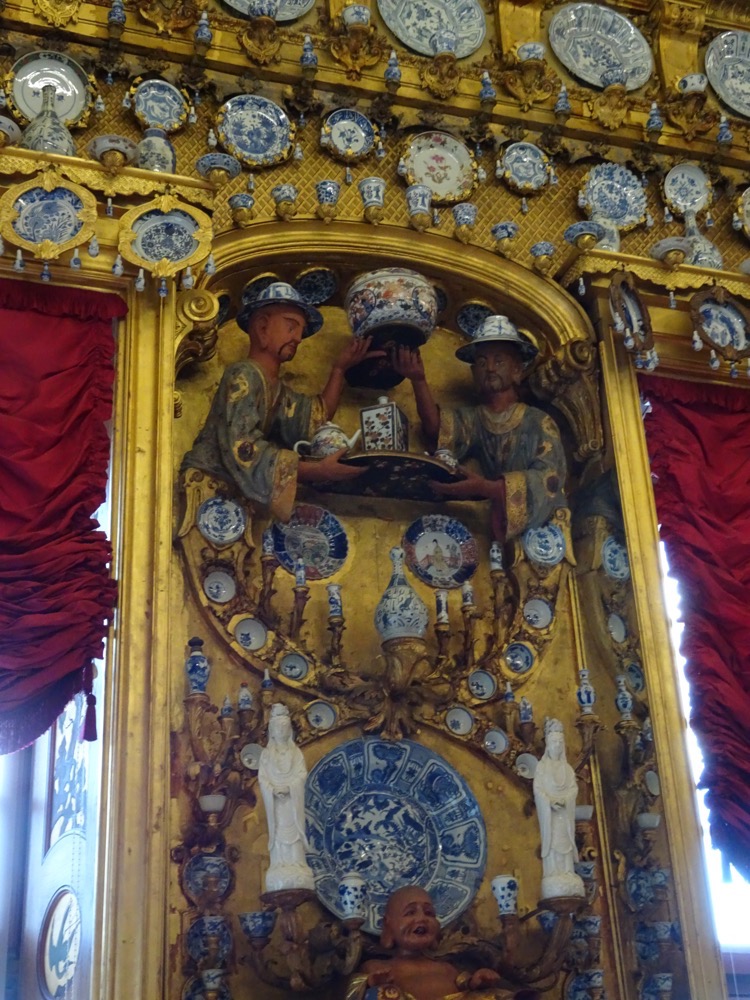
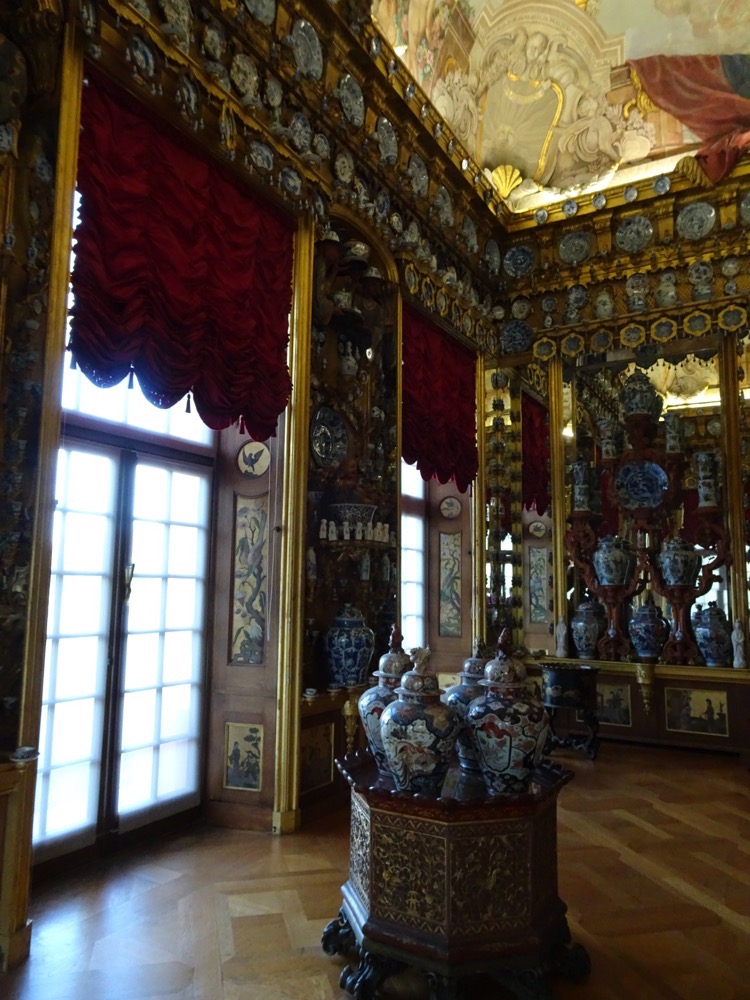 Next to the Porcelain Cabinet is the Royal Chapel – lavishly gilded and heavily ornamented.
Next to the Porcelain Cabinet is the Royal Chapel – lavishly gilded and heavily ornamented.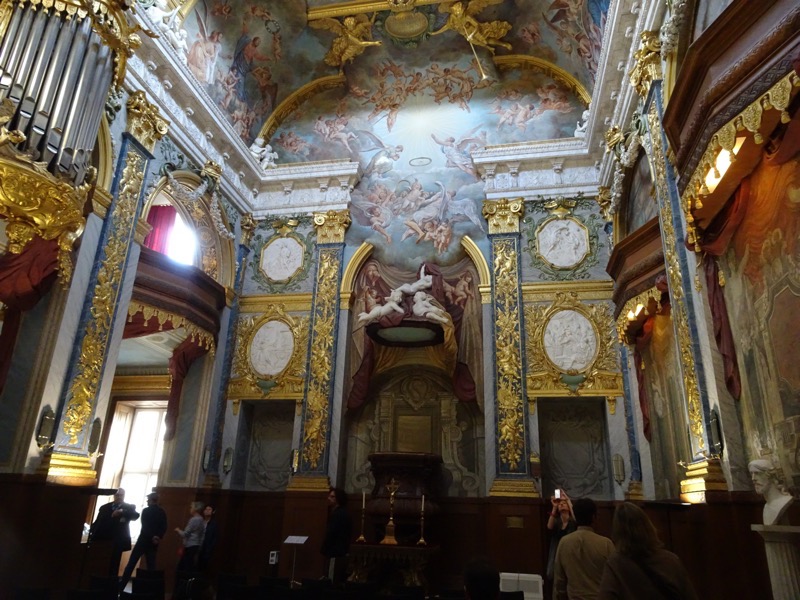
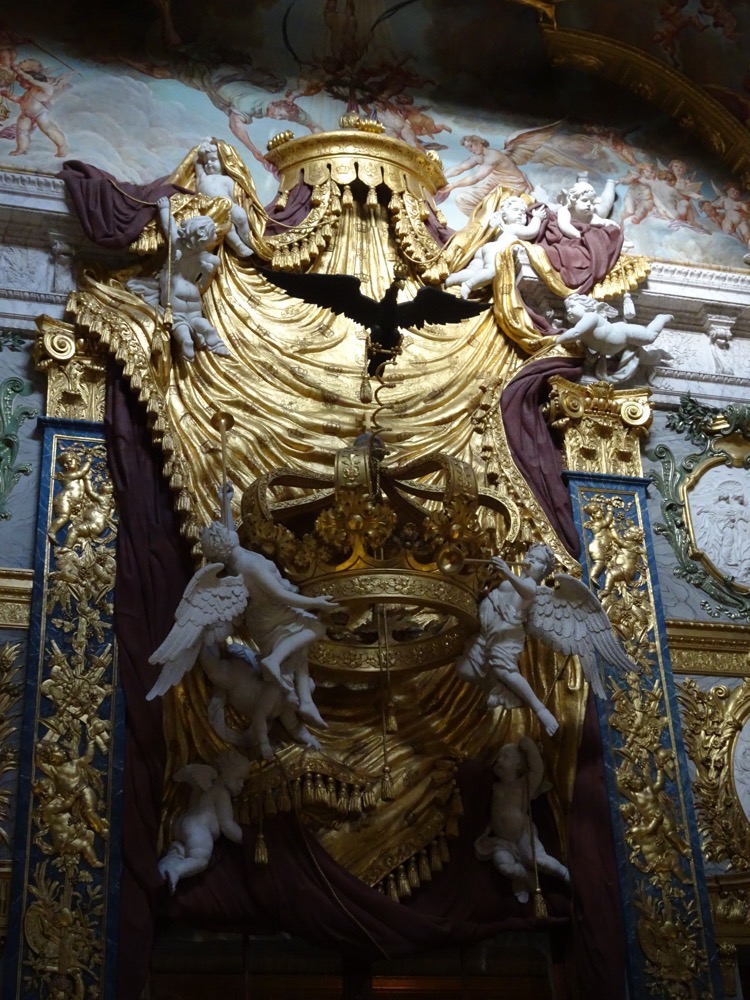
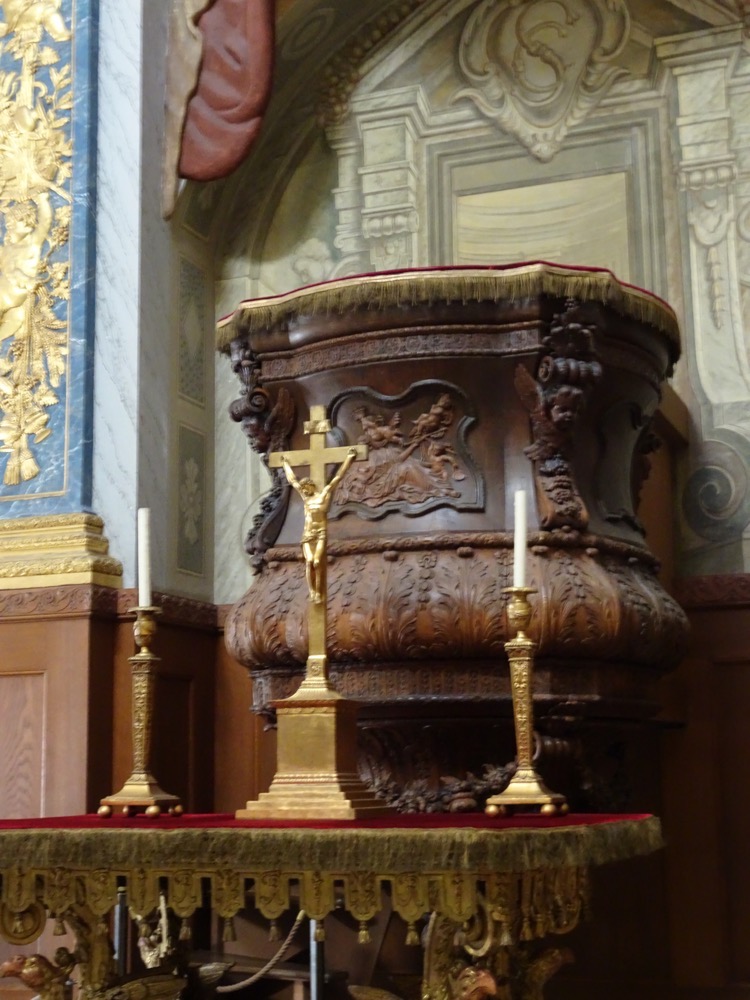 With its own miniature pipe organ.
With its own miniature pipe organ.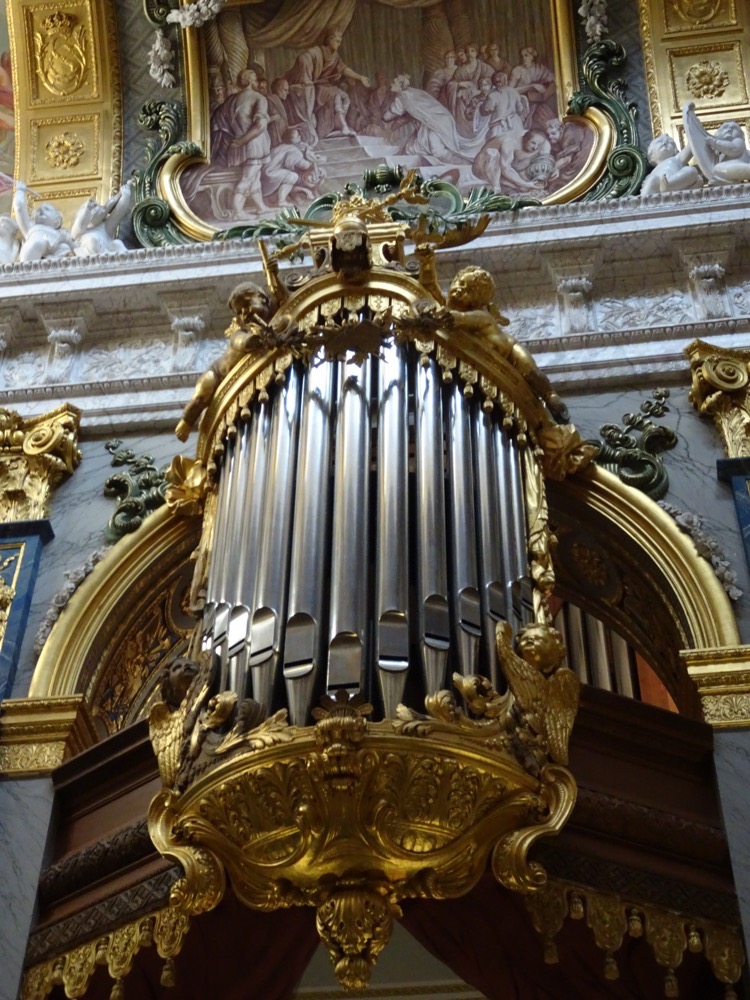 Portrait gallery on the way out.
Portrait gallery on the way out.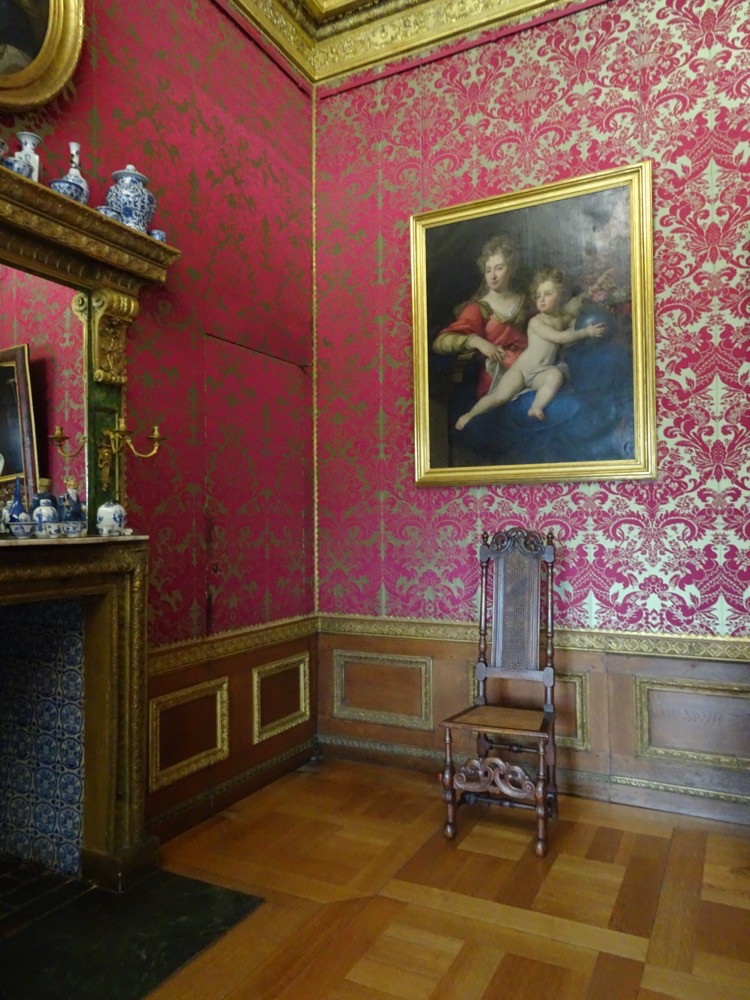
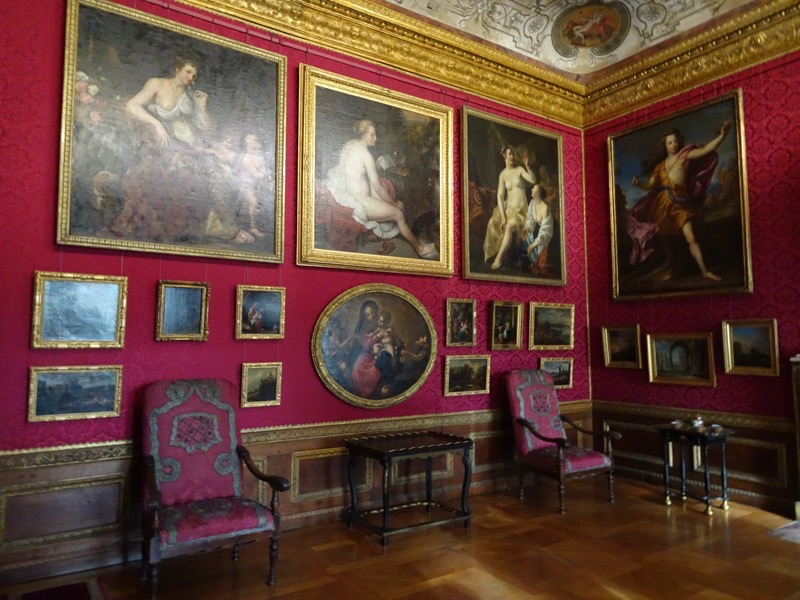
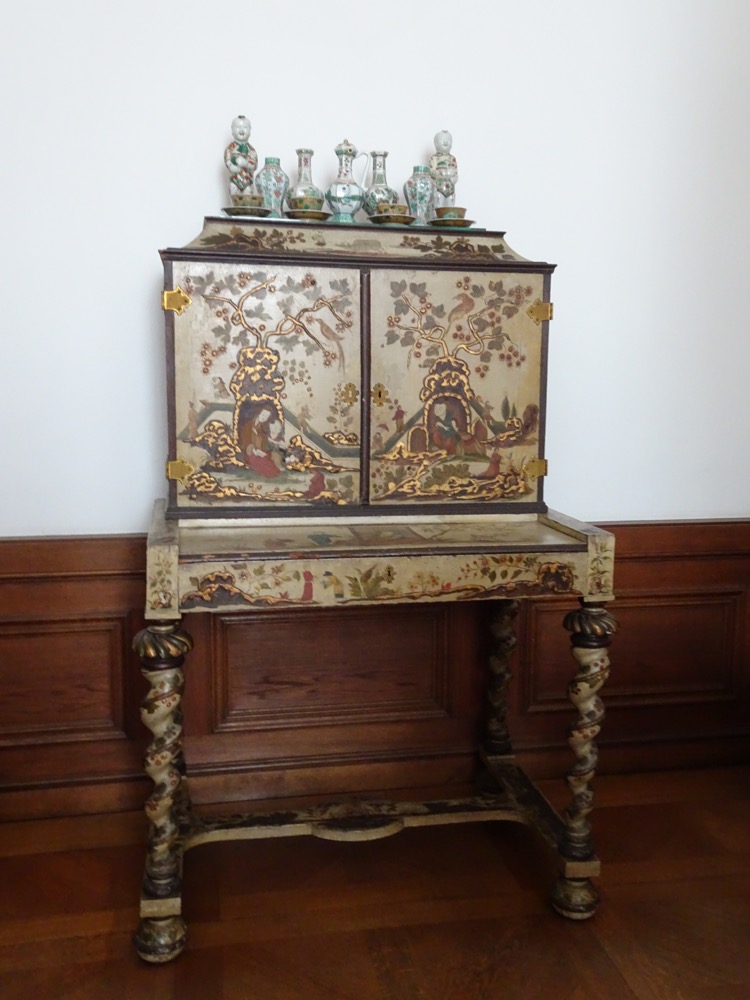 You exit through a servants entrance cleverly hidden under the stairs. The tour is supposed to continue on through the upper apartments, but there is a rope telling us it is closed. This is most likely due to the fact that it is October and they don’t want to staff the entire Palace for the winter, so we missed out on another 140m of lavish apartments upstairs.
You exit through a servants entrance cleverly hidden under the stairs. The tour is supposed to continue on through the upper apartments, but there is a rope telling us it is closed. This is most likely due to the fact that it is October and they don’t want to staff the entire Palace for the winter, so we missed out on another 140m of lavish apartments upstairs.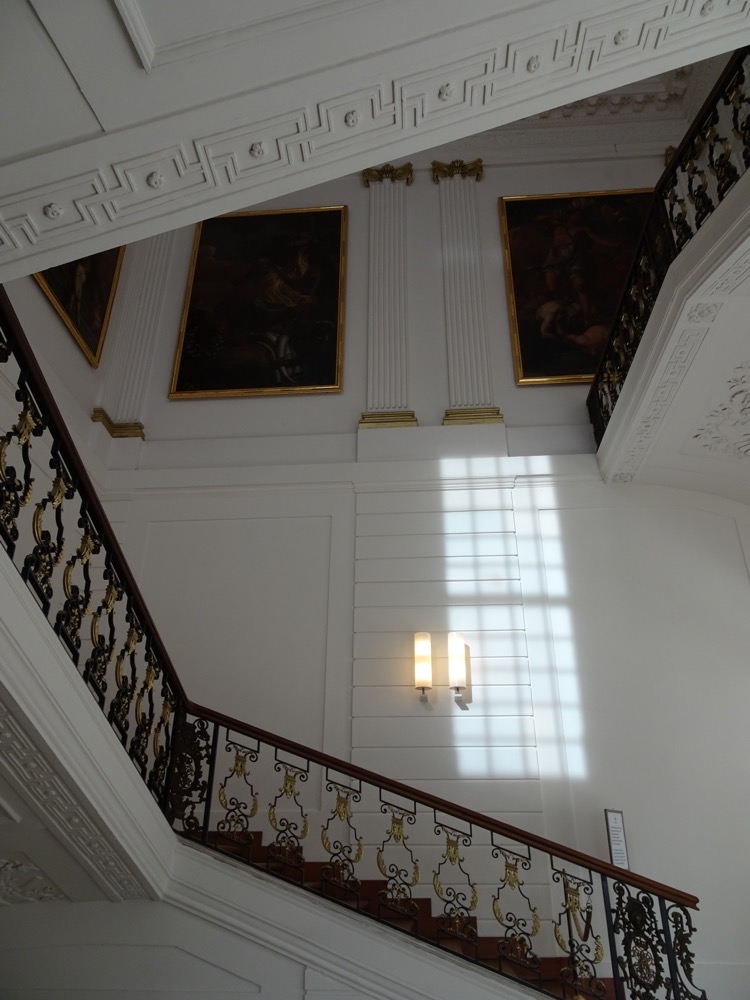 The weather had turned ‘moody’ while we were inside.
The weather had turned ‘moody’ while we were inside.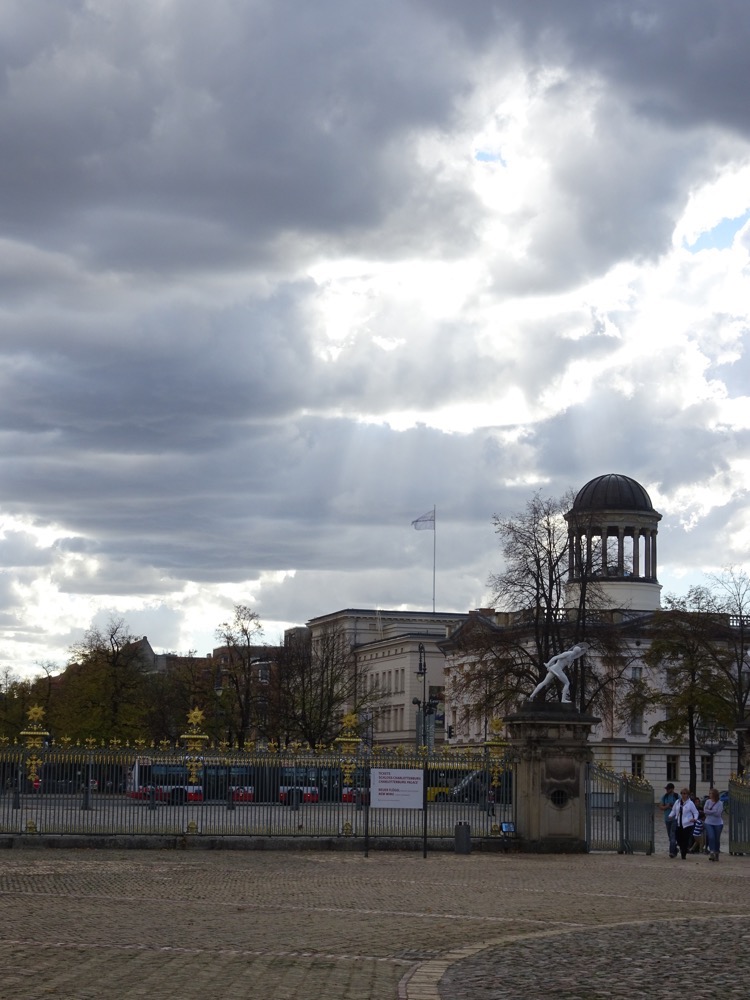
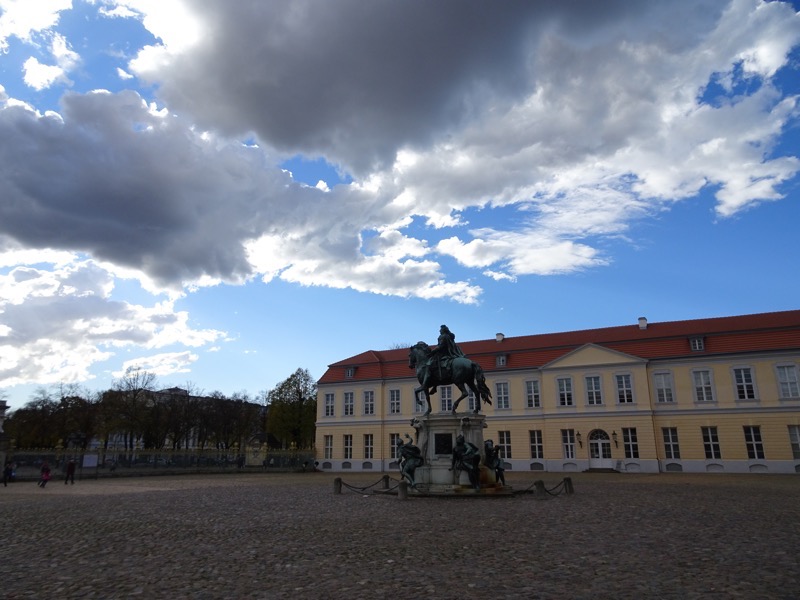 One for Leofric that I saw in the gift shop. 🙂
One for Leofric that I saw in the gift shop. 🙂 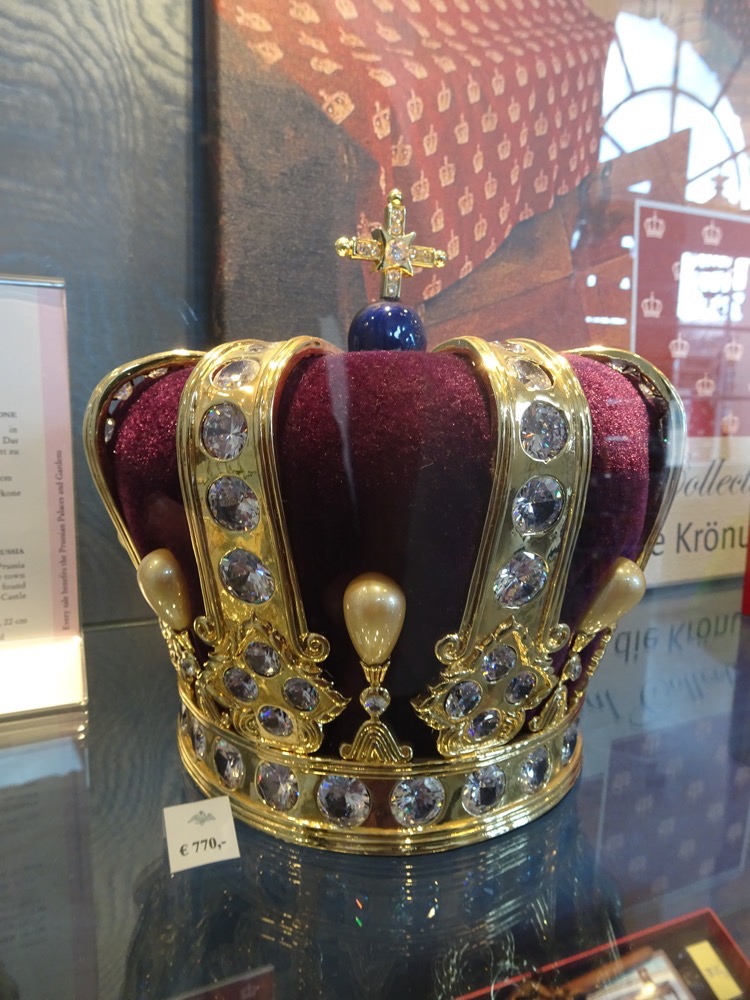 We walked around the back of the palace to see the formal gardens, but without an elevated viewpoint – it’s difficult to see the impressive design.
We walked around the back of the palace to see the formal gardens, but without an elevated viewpoint – it’s difficult to see the impressive design.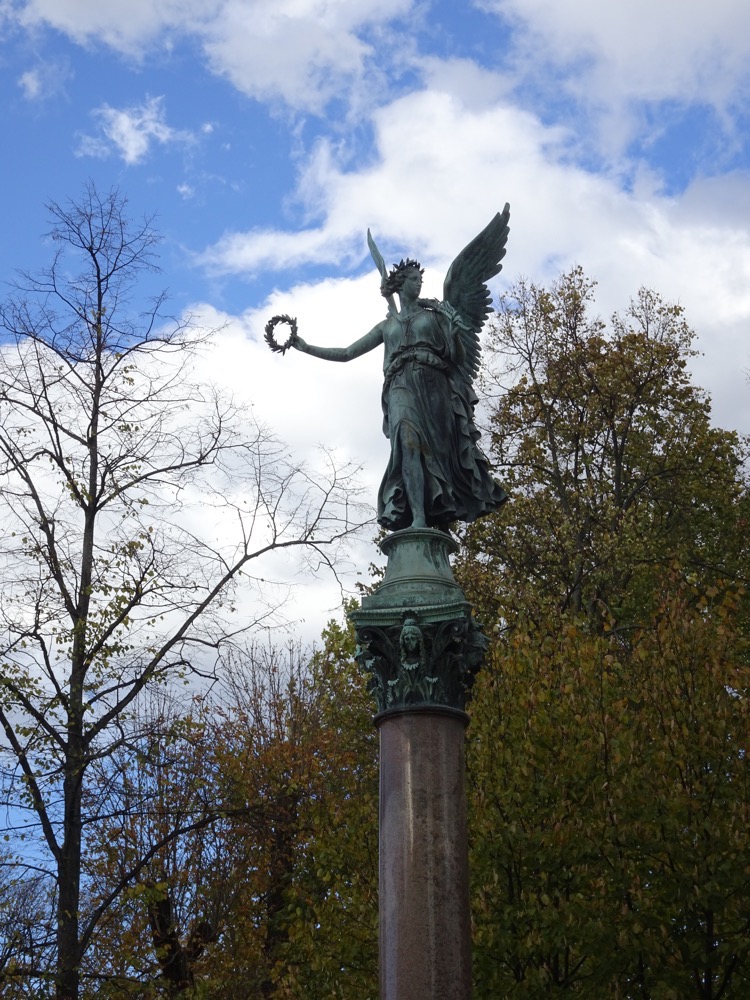
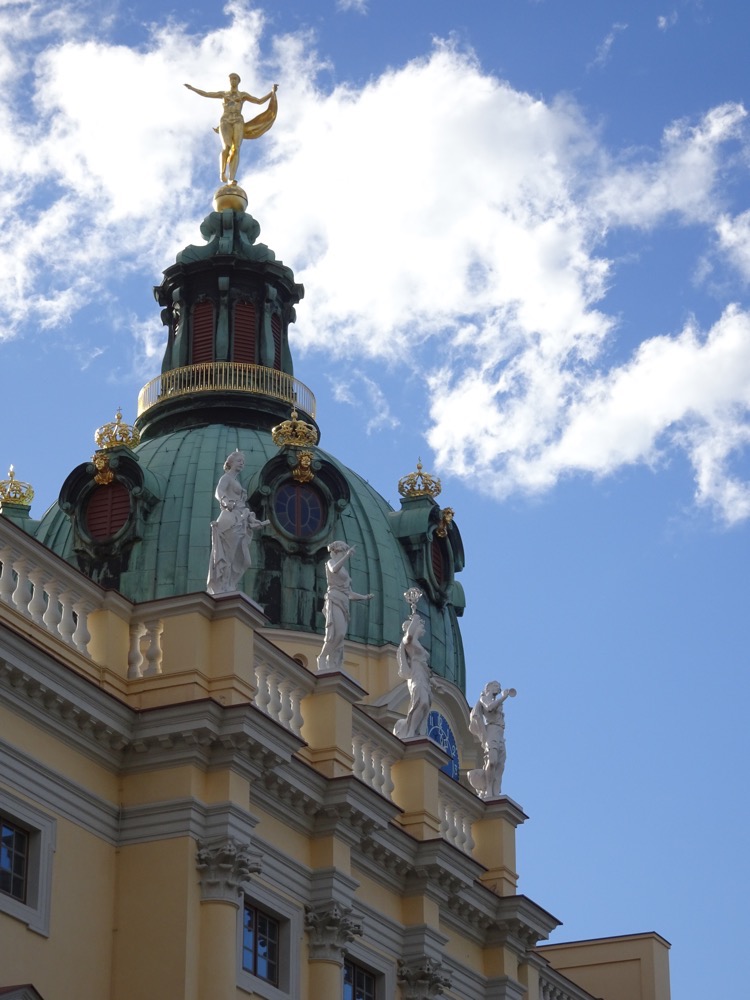
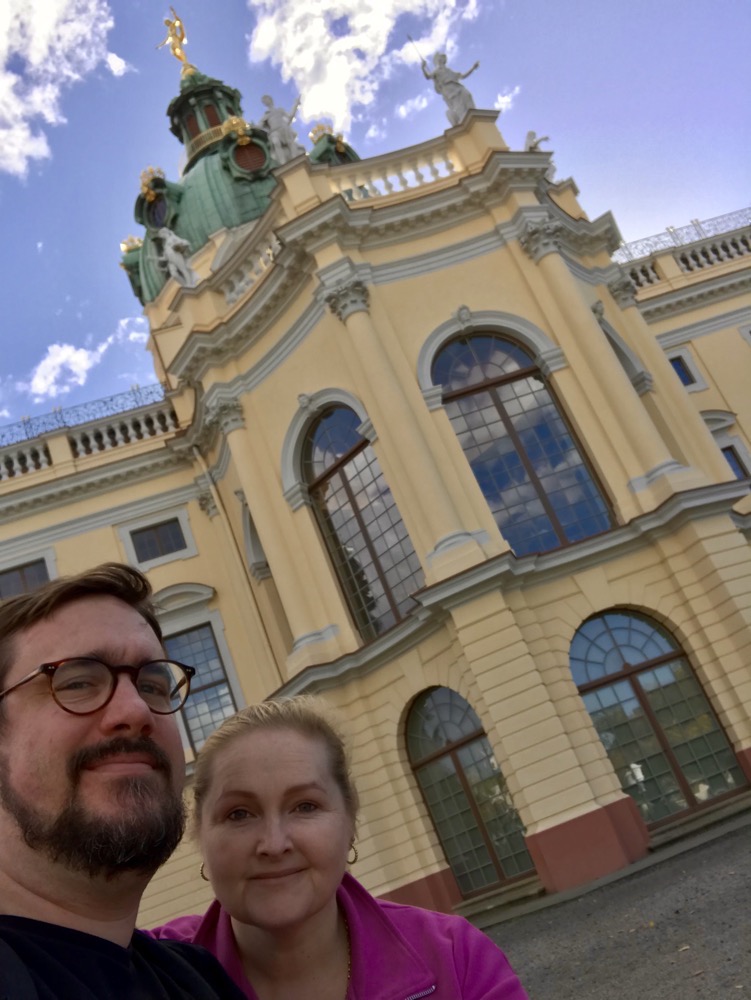
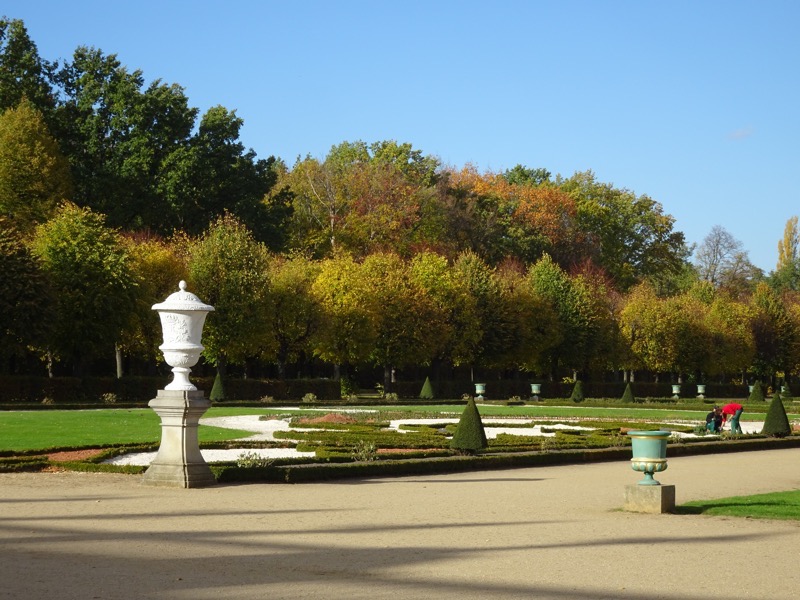
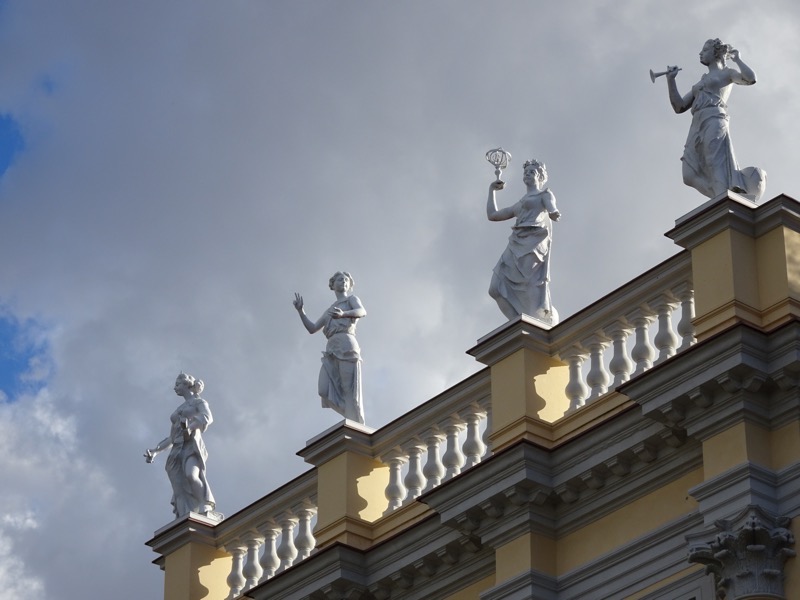
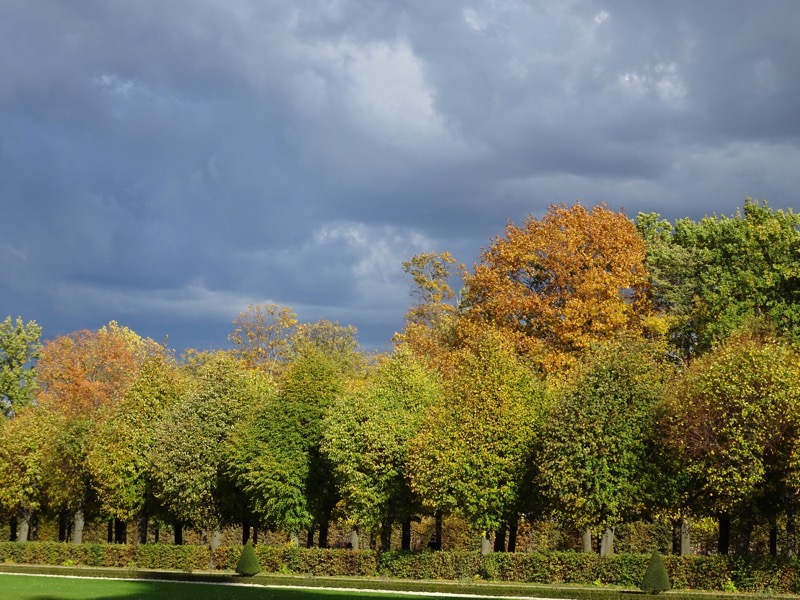
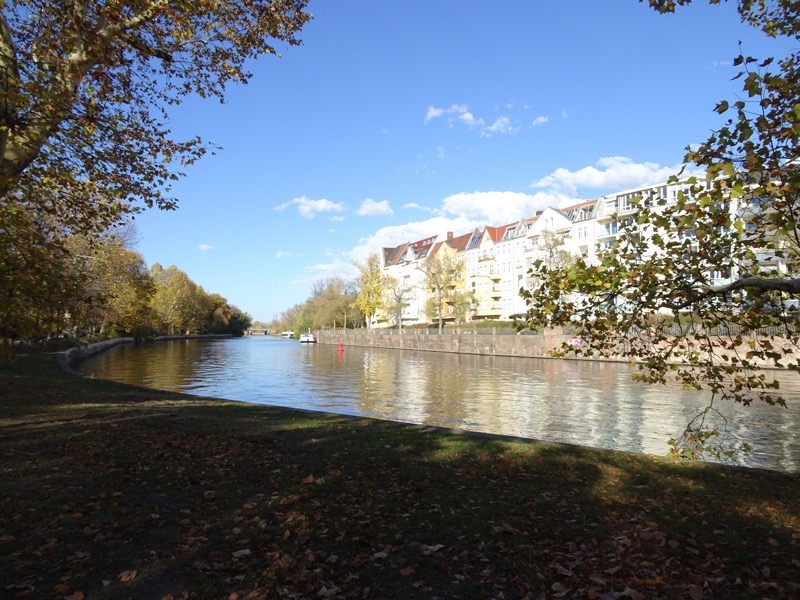
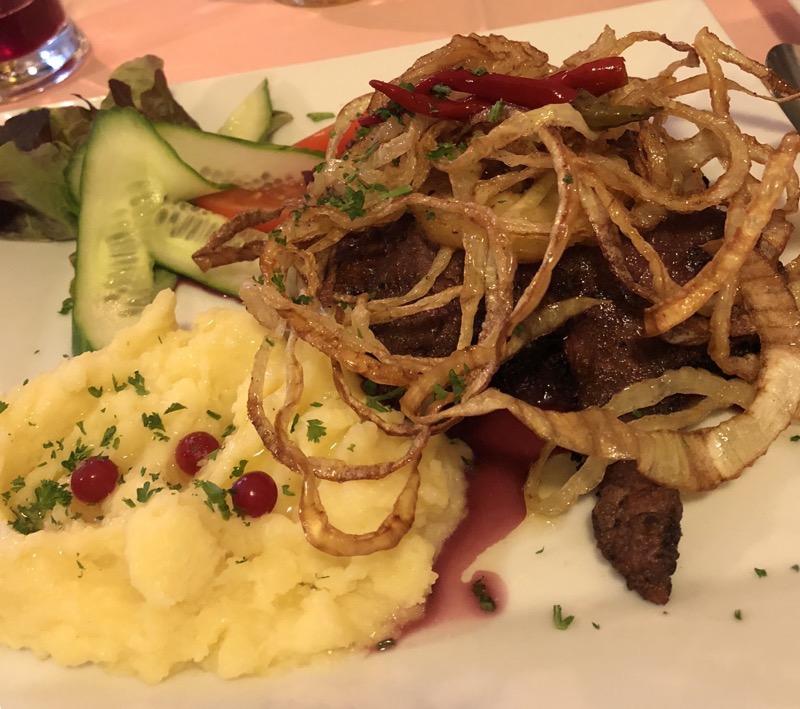 Wild boar sausage with pierogi :
Wild boar sausage with pierogi :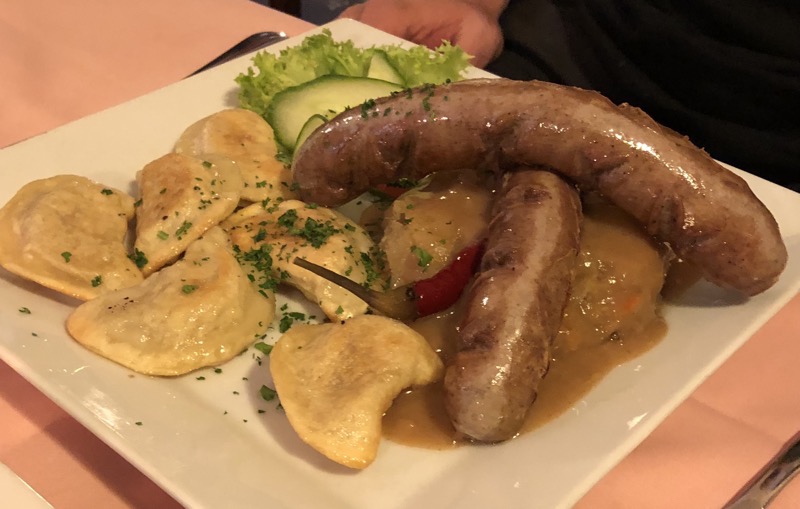 Last Russian honey cake until we go back to Russia or maybe do trans-Siberianan rail trip. 😛
Last Russian honey cake until we go back to Russia or maybe do trans-Siberianan rail trip. 😛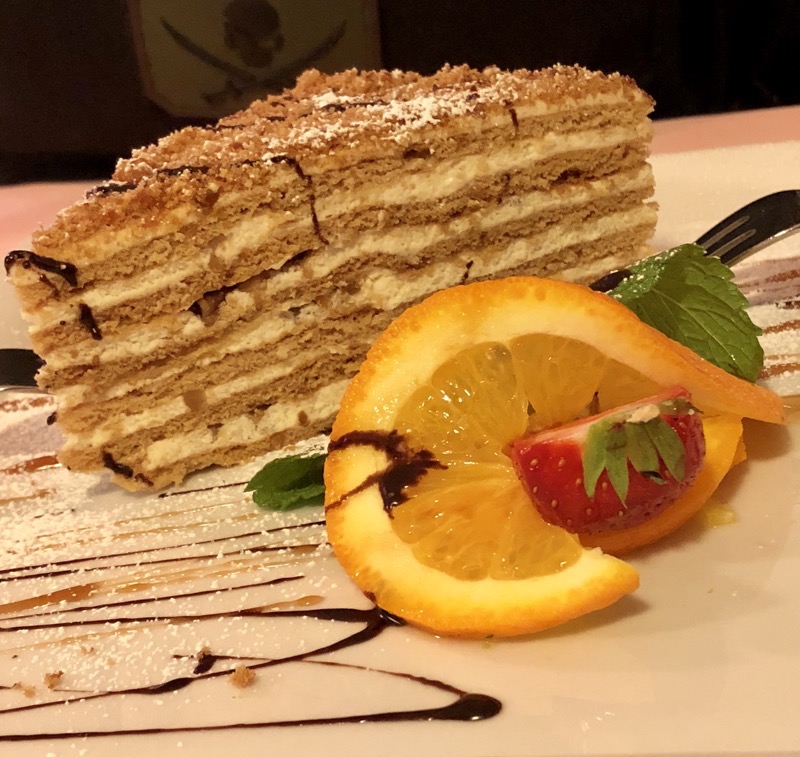 After lunch, we did some masterful navigating of Berlin’s bus and train systems to go see the East Side Gallery. The East Side Gallery is an open-air art gallery which consists of a series of large murals that have been painted directly onto a remnant of the Berlin Wall.
After lunch, we did some masterful navigating of Berlin’s bus and train systems to go see the East Side Gallery. The East Side Gallery is an open-air art gallery which consists of a series of large murals that have been painted directly onto a remnant of the Berlin Wall. 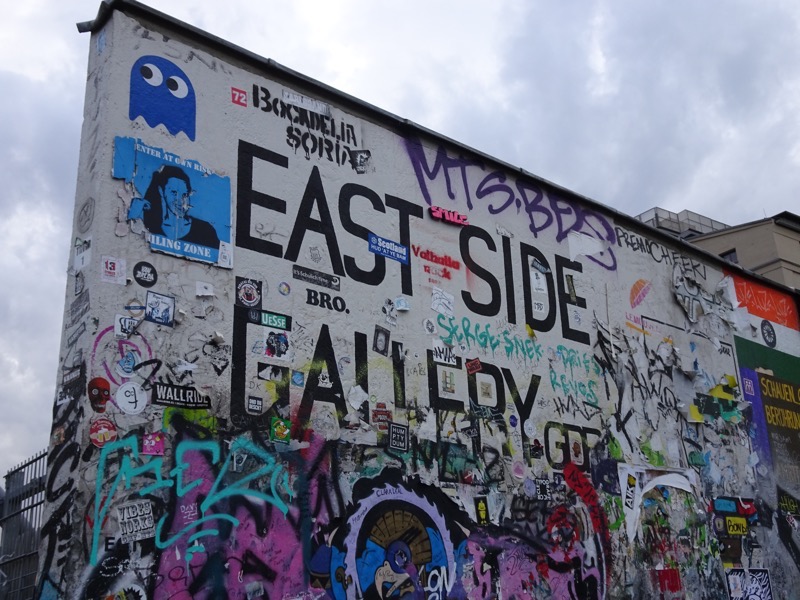
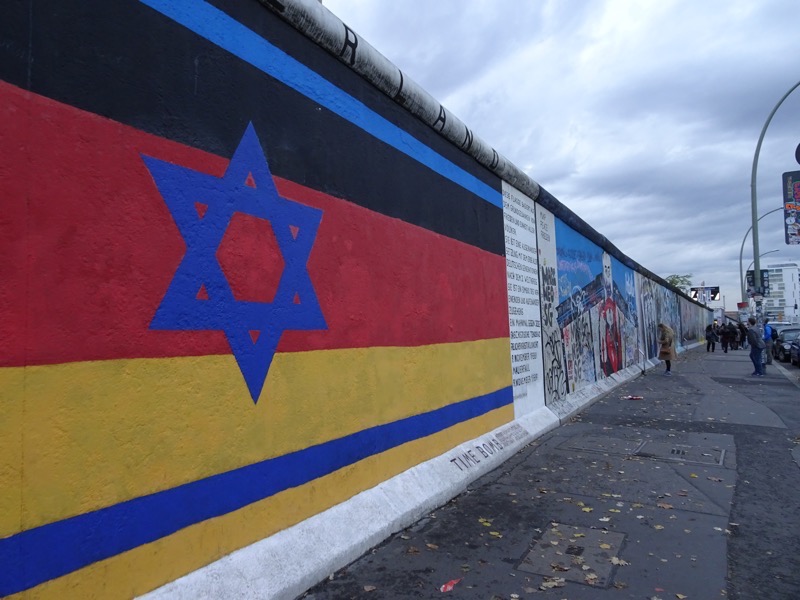 The paintings on Mühlenstraße started in 1990 and is over 1.3kms long making it the largest open-air art gallery in the world. There has been a lot of grafitti put on the artworks over the years, and some piece have been restored, but there is controversy over this with many artists refusing to re-do their artworks.
The paintings on Mühlenstraße started in 1990 and is over 1.3kms long making it the largest open-air art gallery in the world. There has been a lot of grafitti put on the artworks over the years, and some piece have been restored, but there is controversy over this with many artists refusing to re-do their artworks.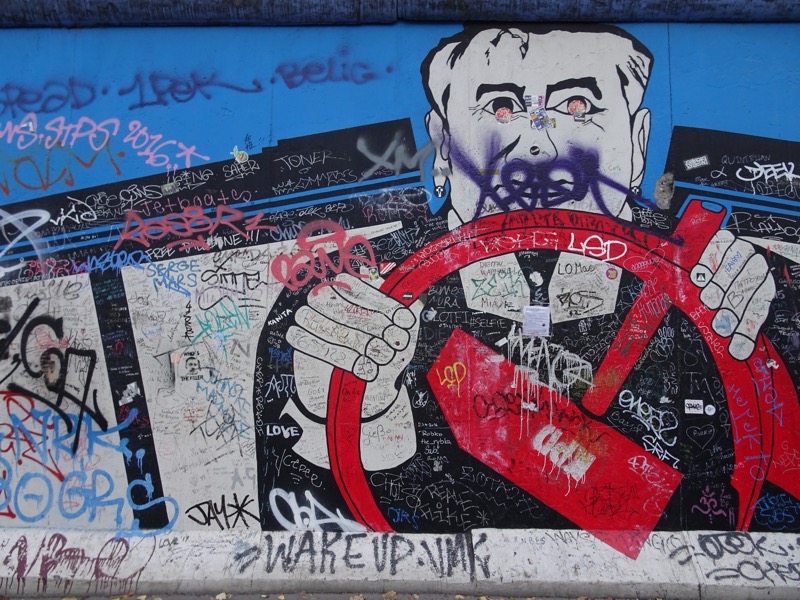
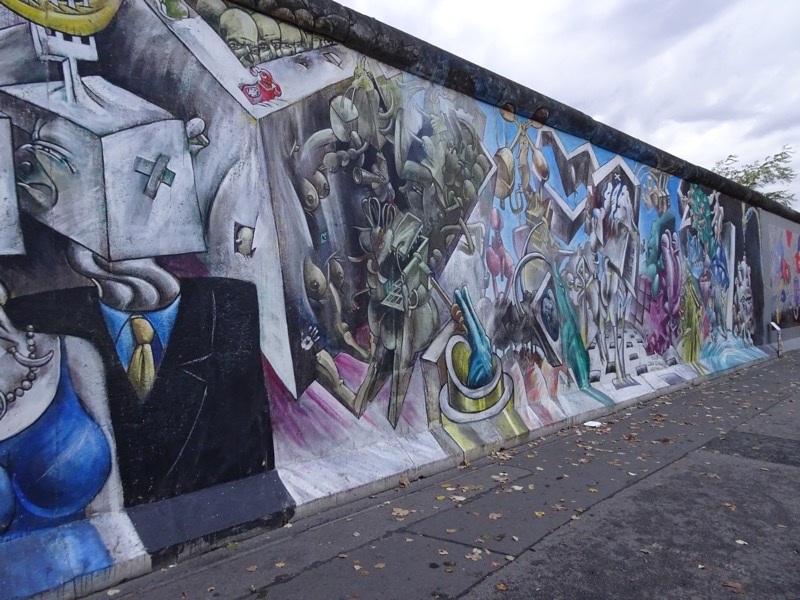 Today, it seems most of the art works are being left alone and not being grafitted, but there are areas of the wall where it seems grafitti is encouraged, as this is a living used space.
Today, it seems most of the art works are being left alone and not being grafitted, but there are areas of the wall where it seems grafitti is encouraged, as this is a living used space.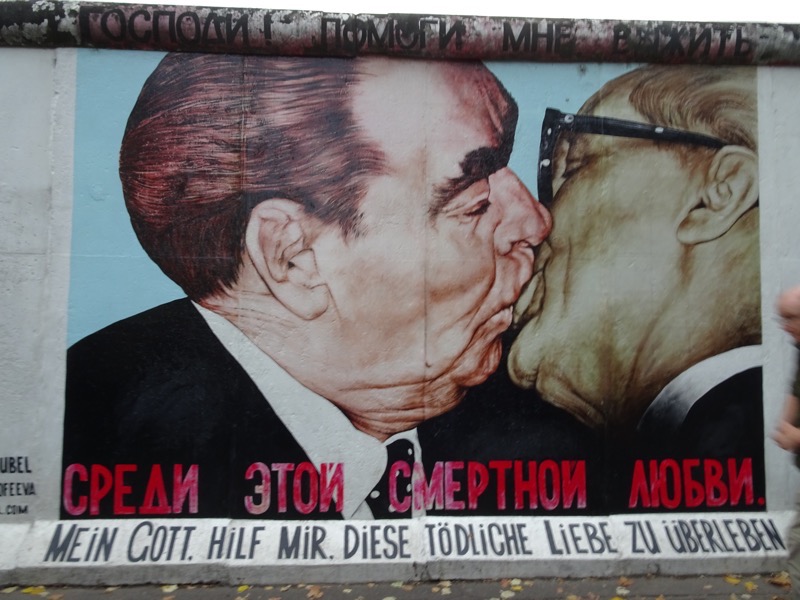 I love this: Moscow…walls; China… walls; Everywhere… no walls (with kangaroo!);, Berlin… walls.
I love this: Moscow…walls; China… walls; Everywhere… no walls (with kangaroo!);, Berlin… walls.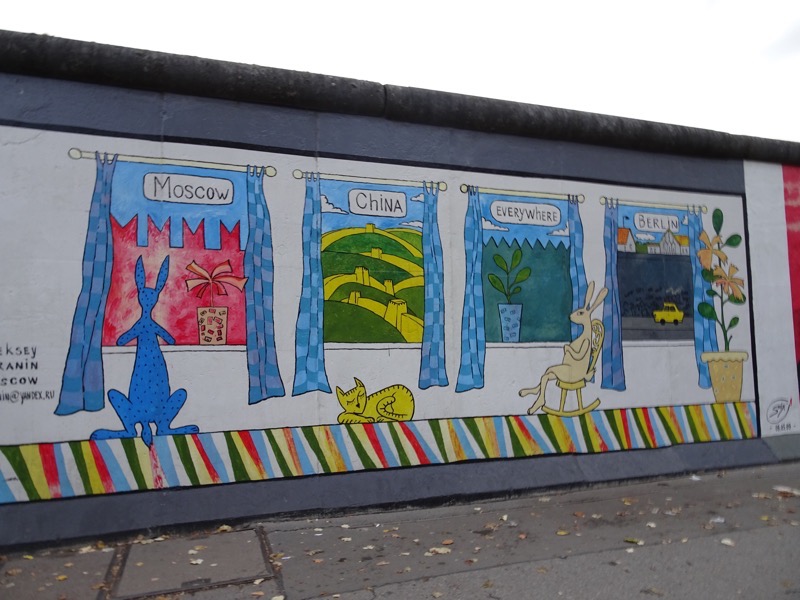 This section of wall is all grafitti… the big stenciled work is not an official piece.
This section of wall is all grafitti… the big stenciled work is not an official piece.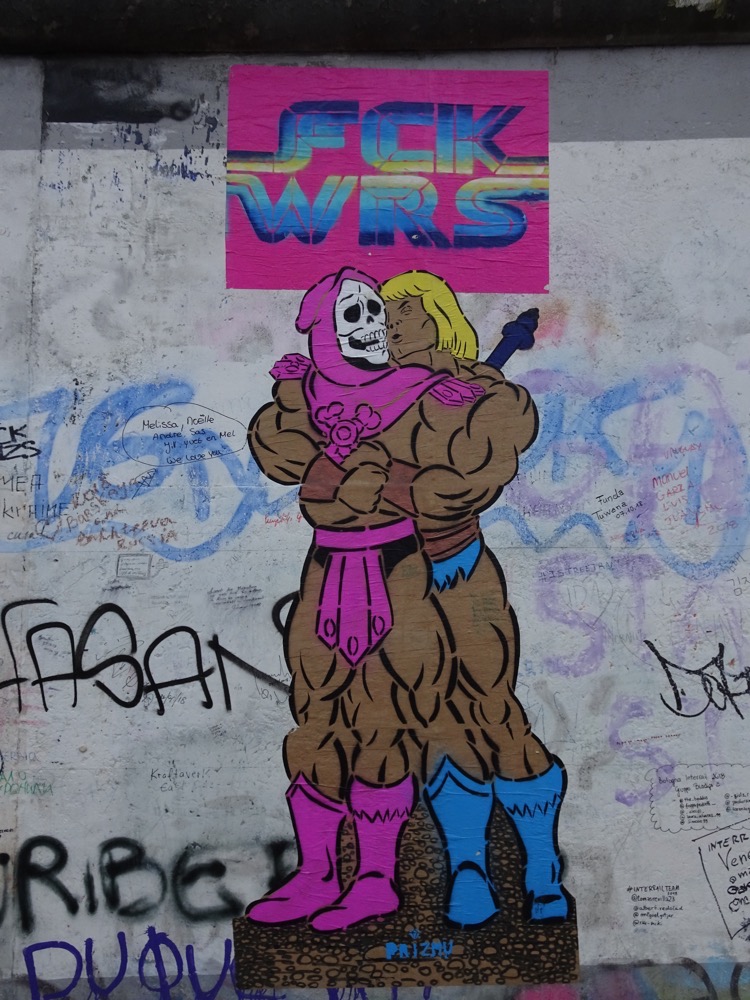 So we thought this was a good place to leave a small mark.
So we thought this was a good place to leave a small mark.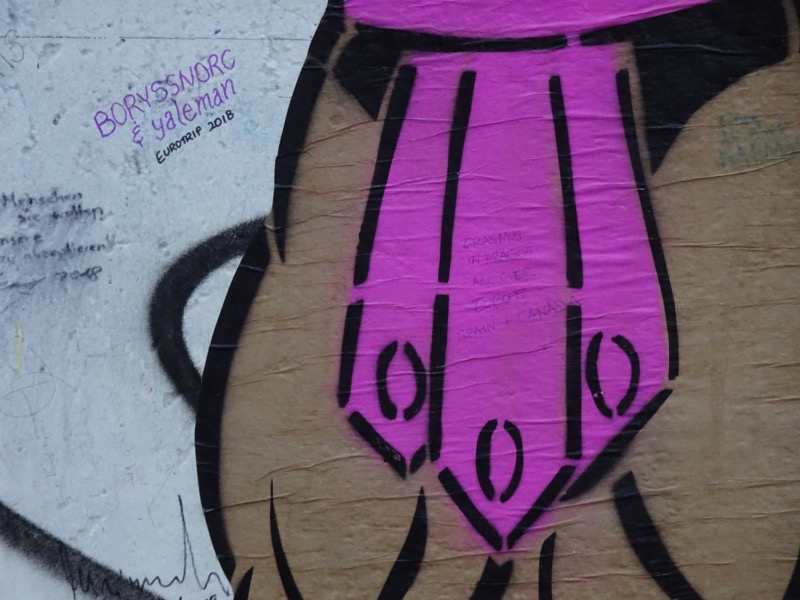
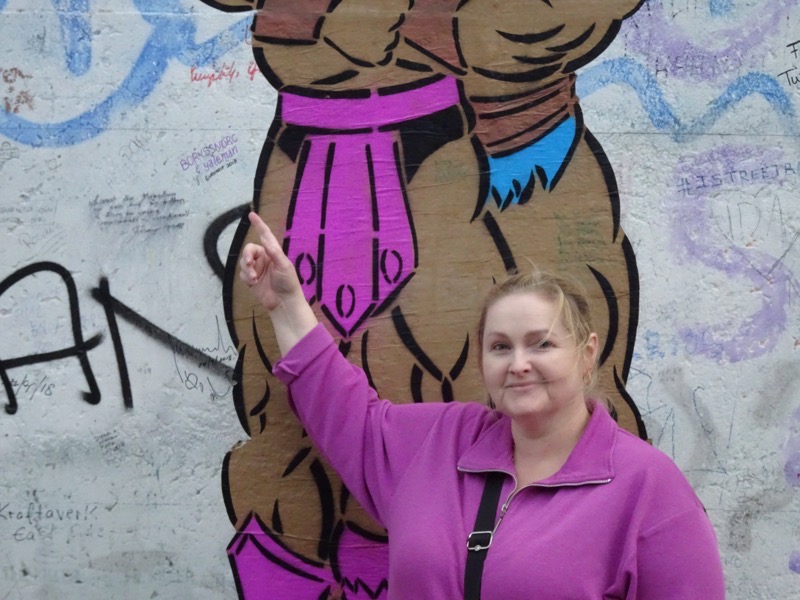
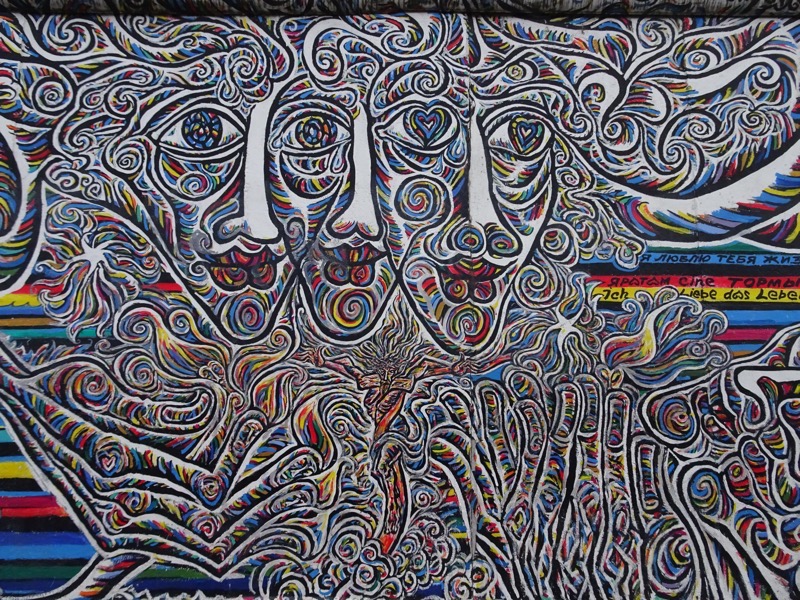
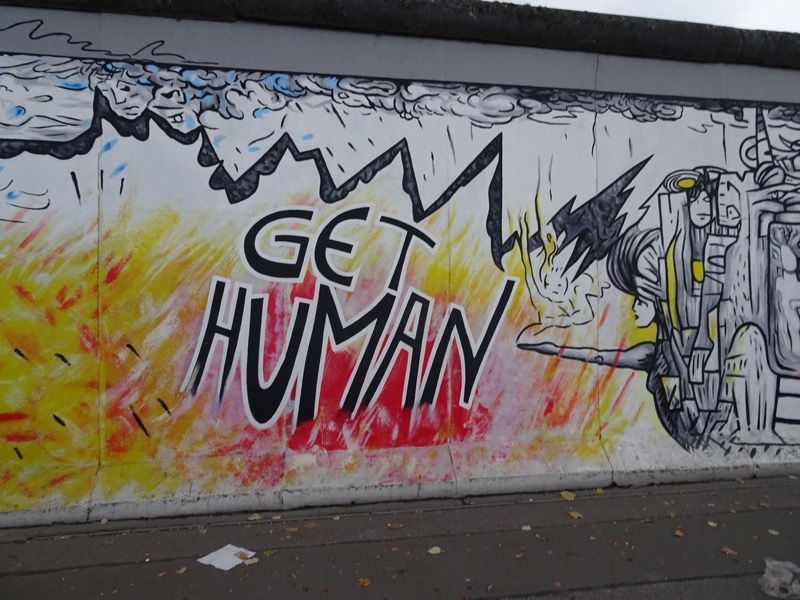
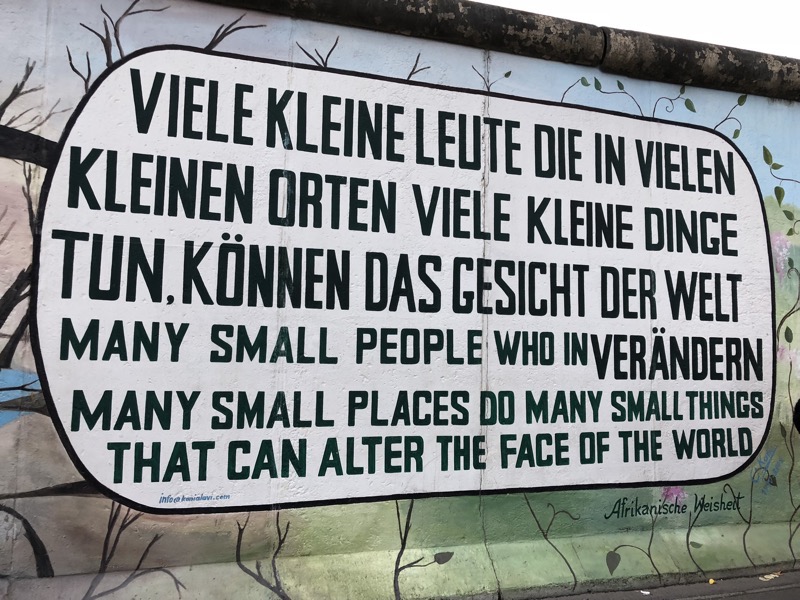
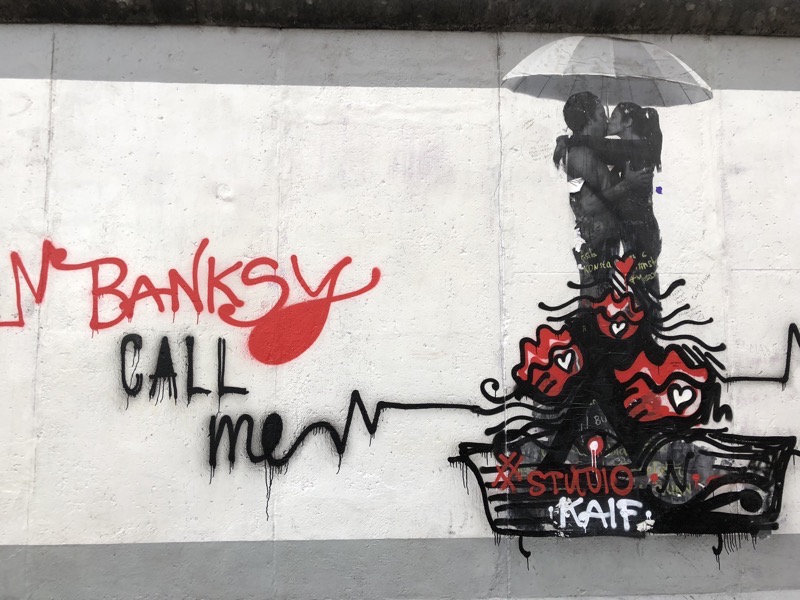
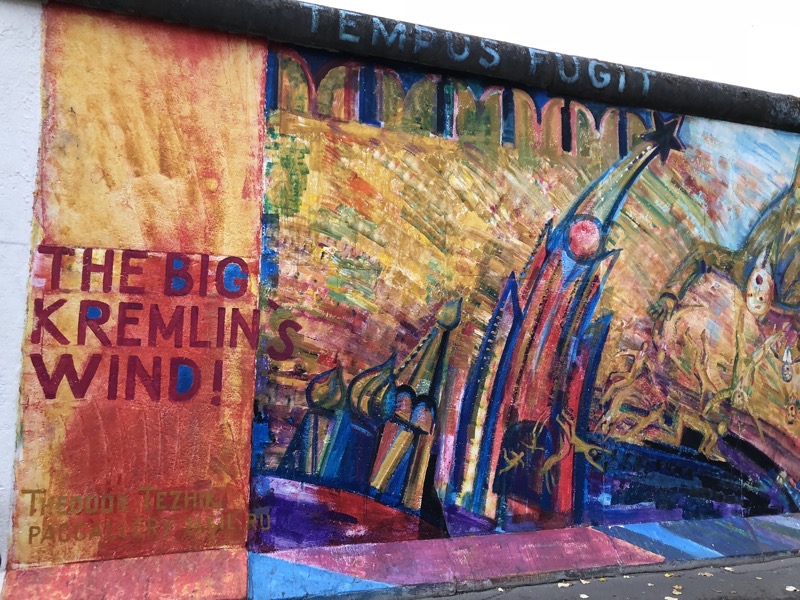 I know my photos make it look all peaceful and orderly – but of course, it wasn’t.
I know my photos make it look all peaceful and orderly – but of course, it wasn’t.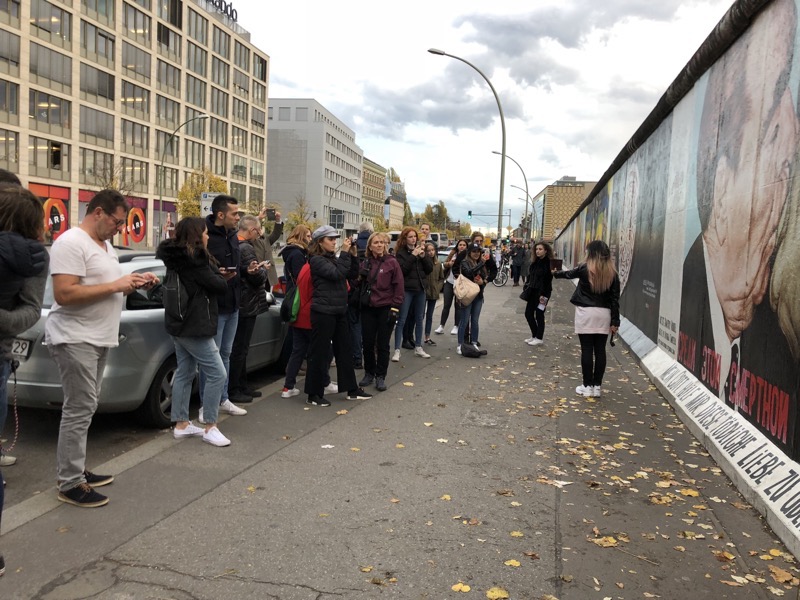
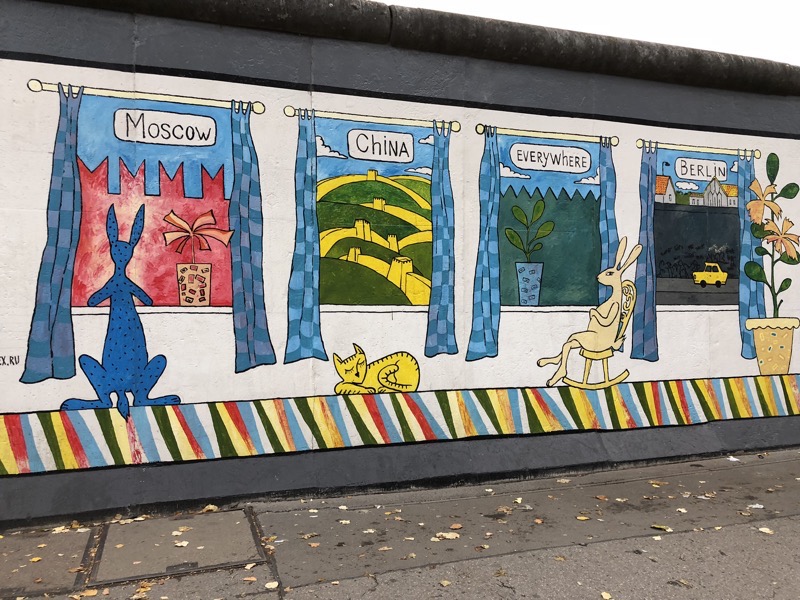
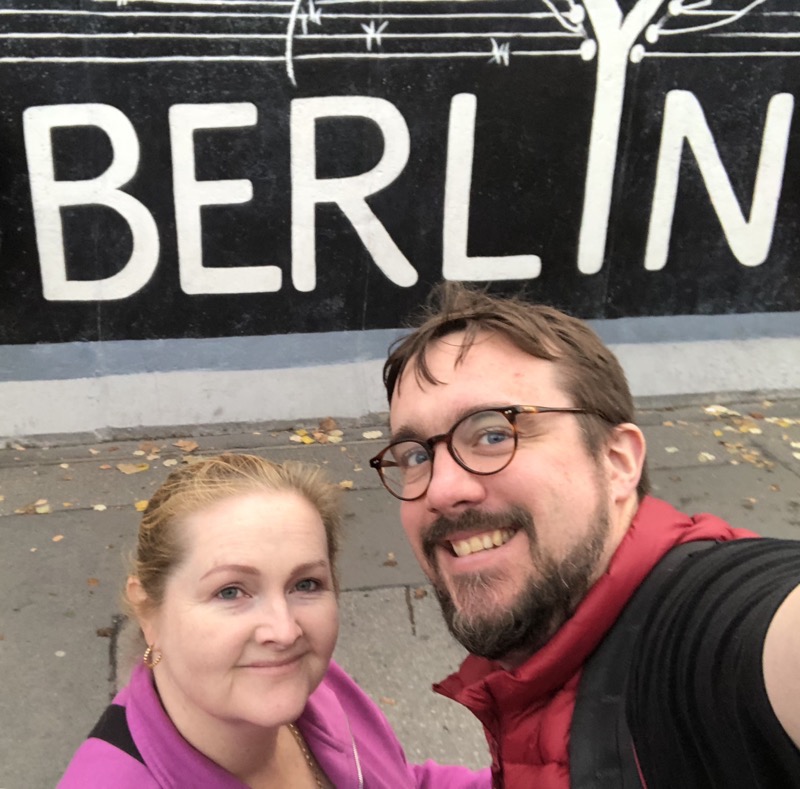
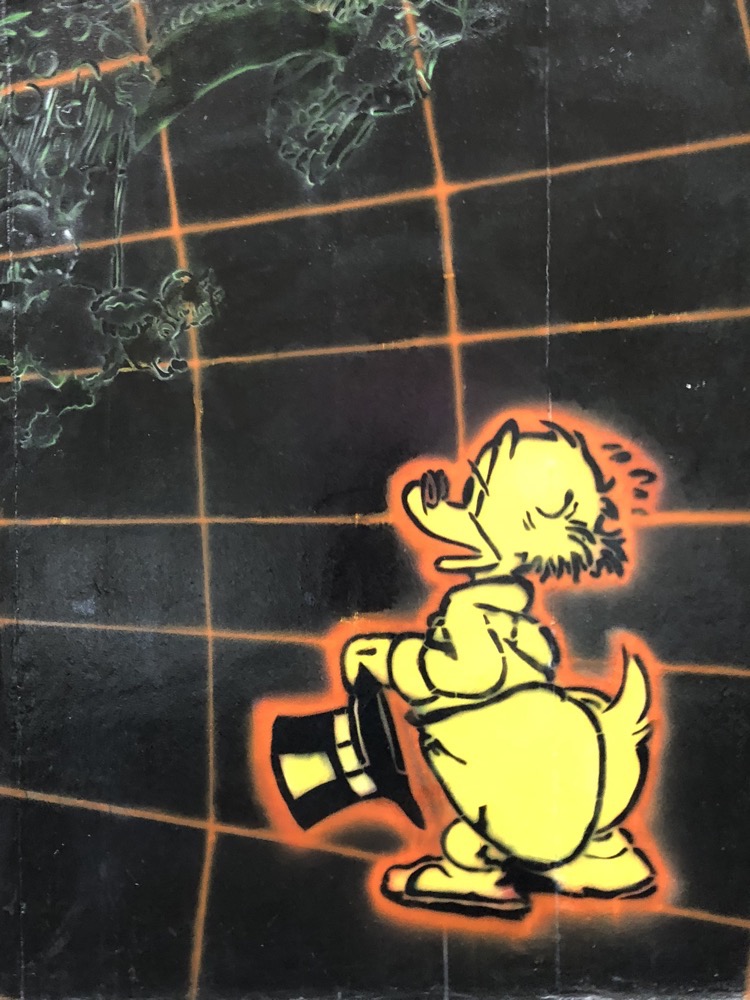
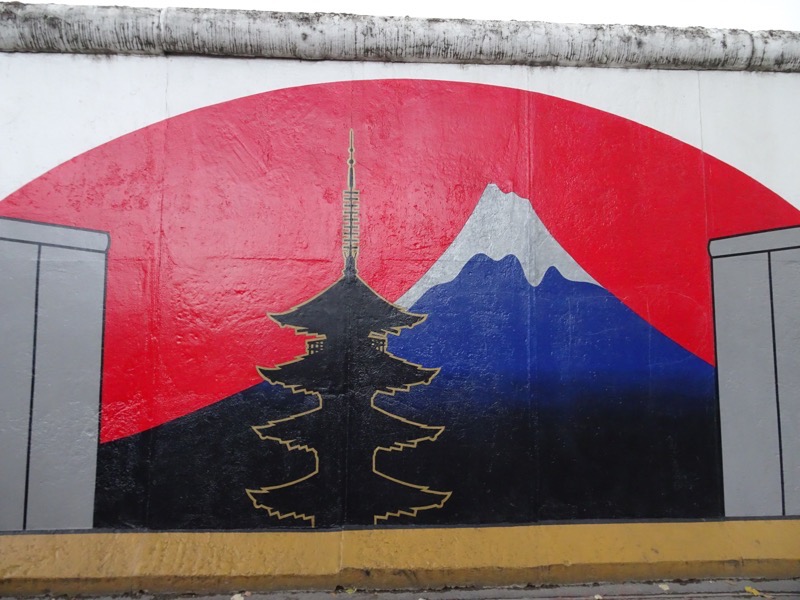 And it was about this time that our beautiful day with it’s 17C higher in temp then yesterday started to literally rain on our parade. So we hightailed it to the nearest train station and head back to the hotel.
And it was about this time that our beautiful day with it’s 17C higher in temp then yesterday started to literally rain on our parade. So we hightailed it to the nearest train station and head back to the hotel.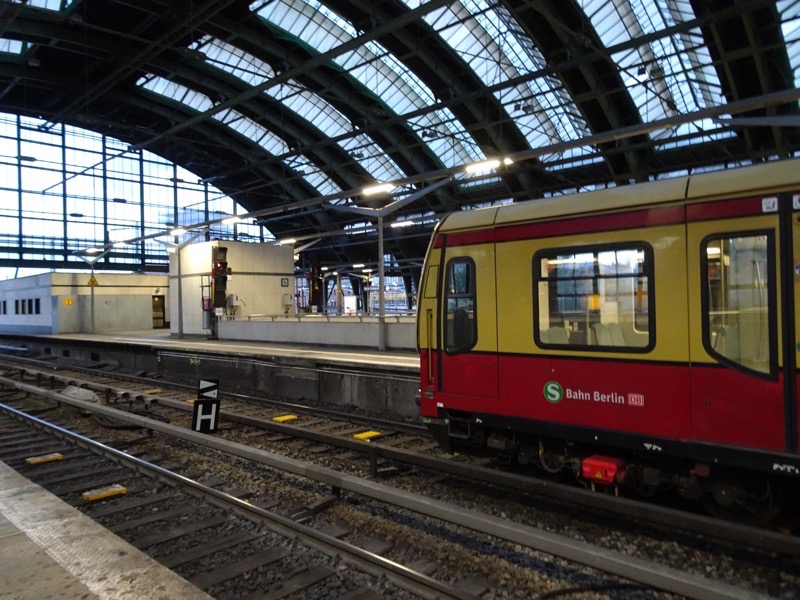
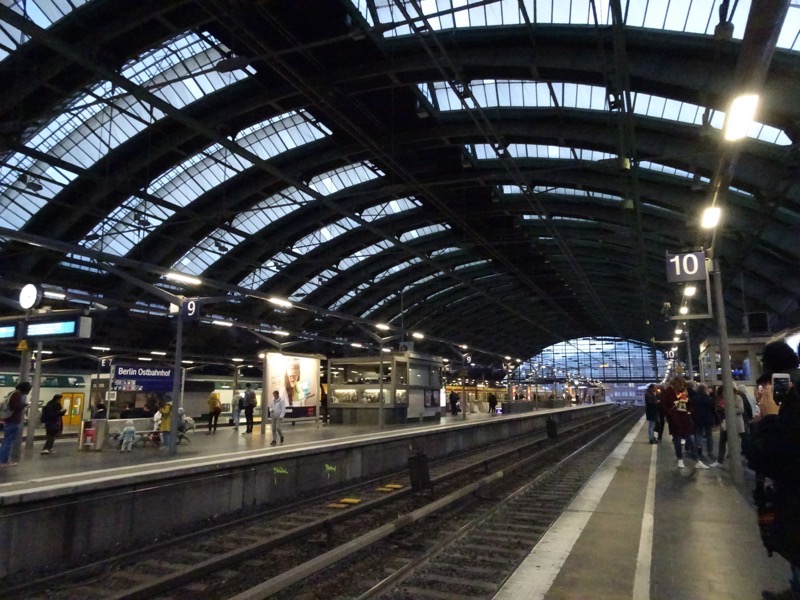
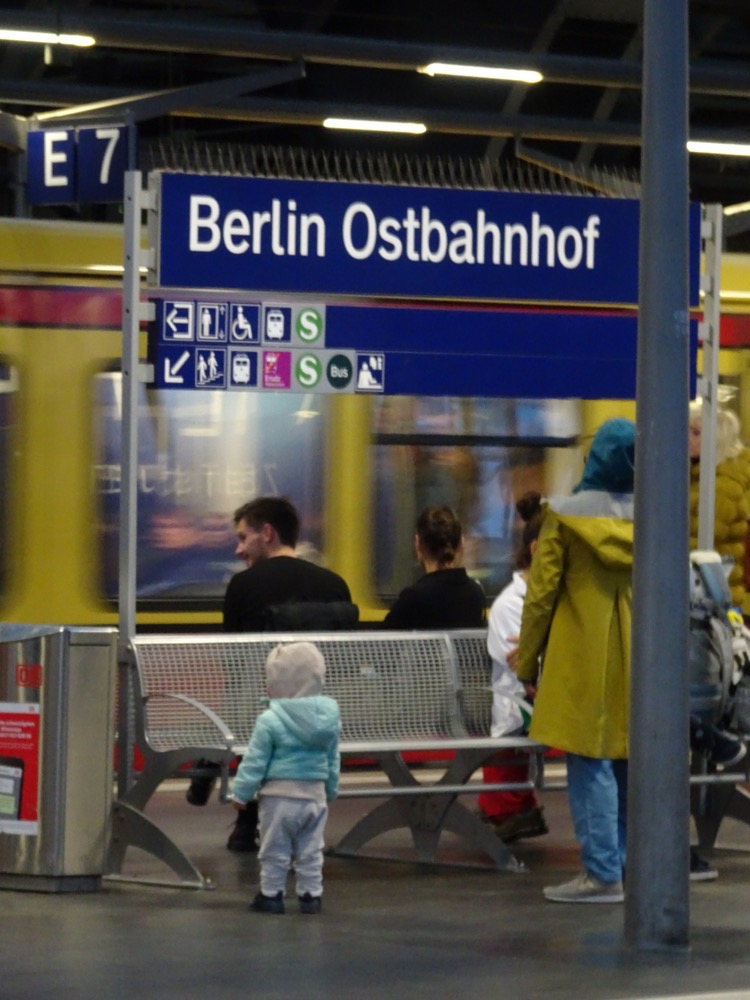 And so ends our last day in Europe… for tomorrow we fly from Berlin to London to Singapore to Brisbane and all things going to plan, we arrive two days from now.
And so ends our last day in Europe… for tomorrow we fly from Berlin to London to Singapore to Brisbane and all things going to plan, we arrive two days from now.